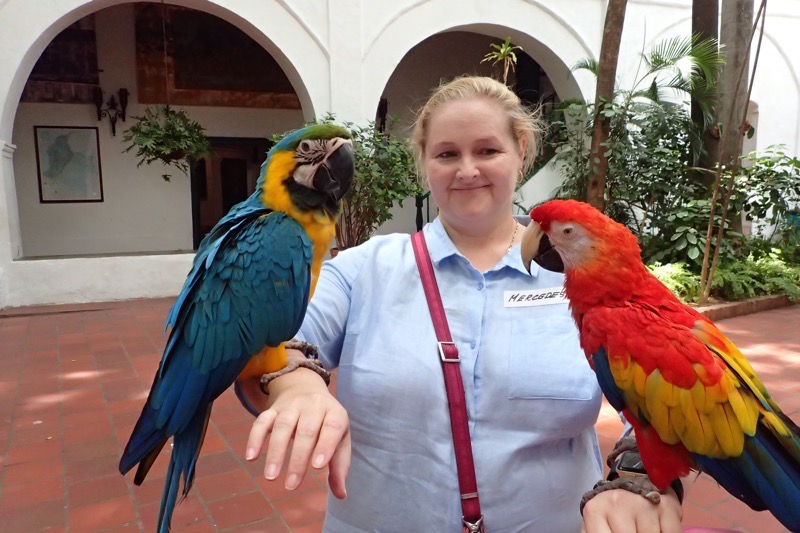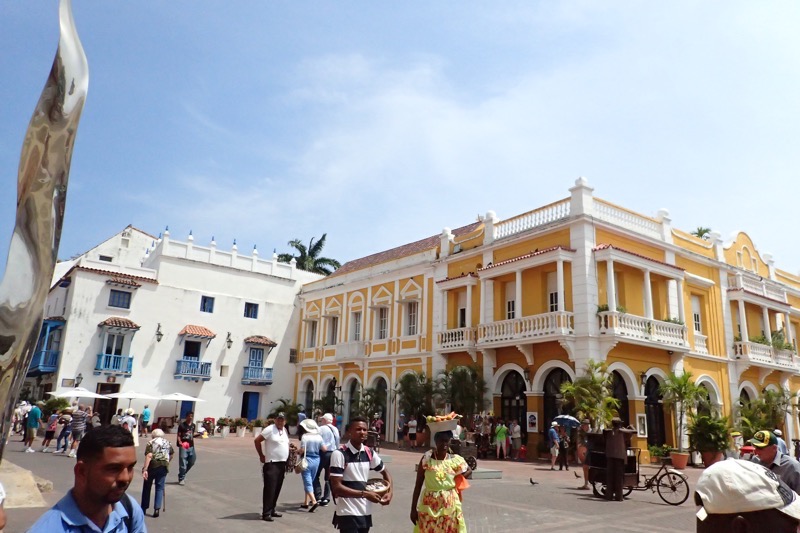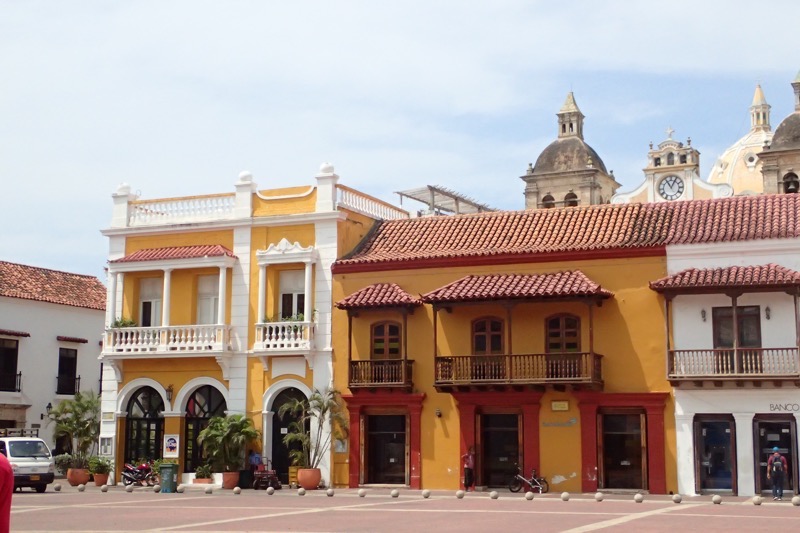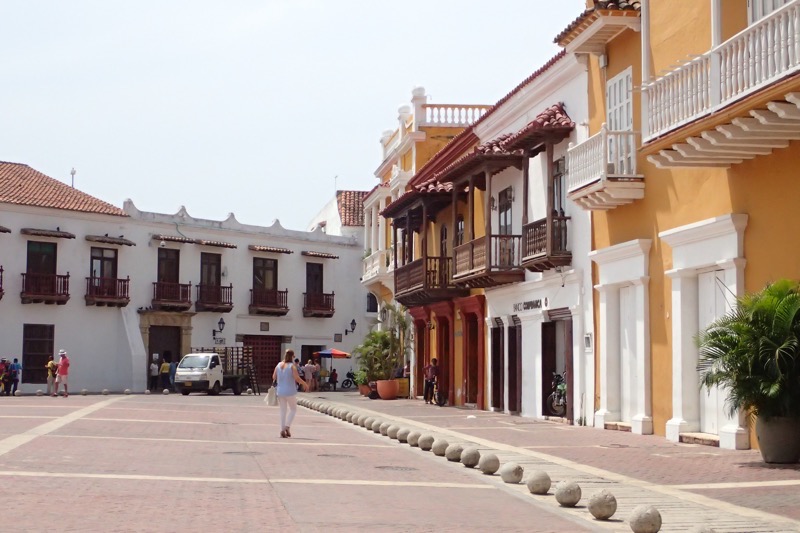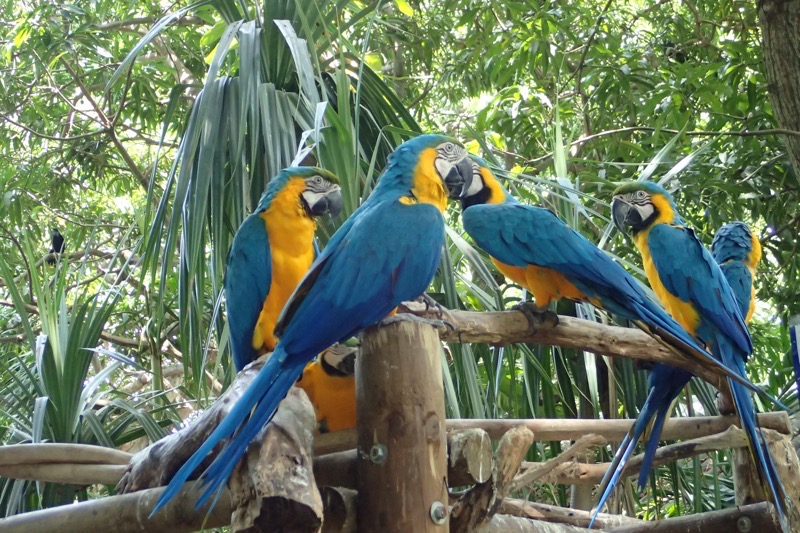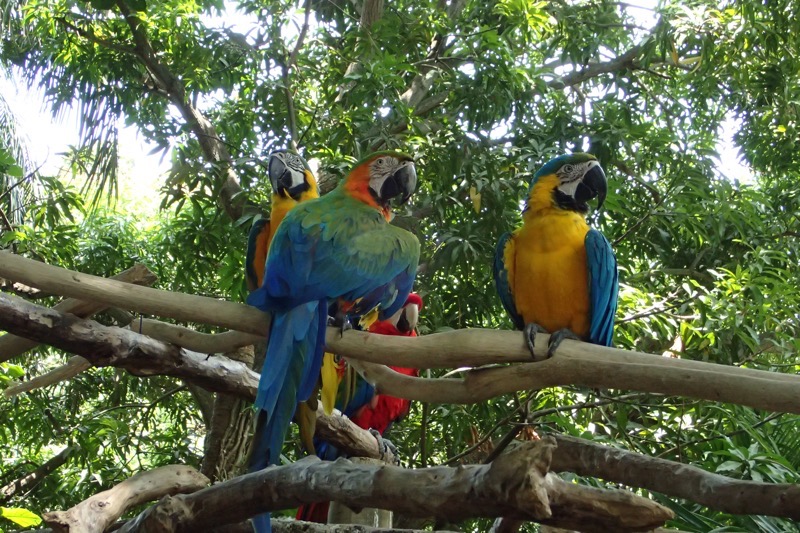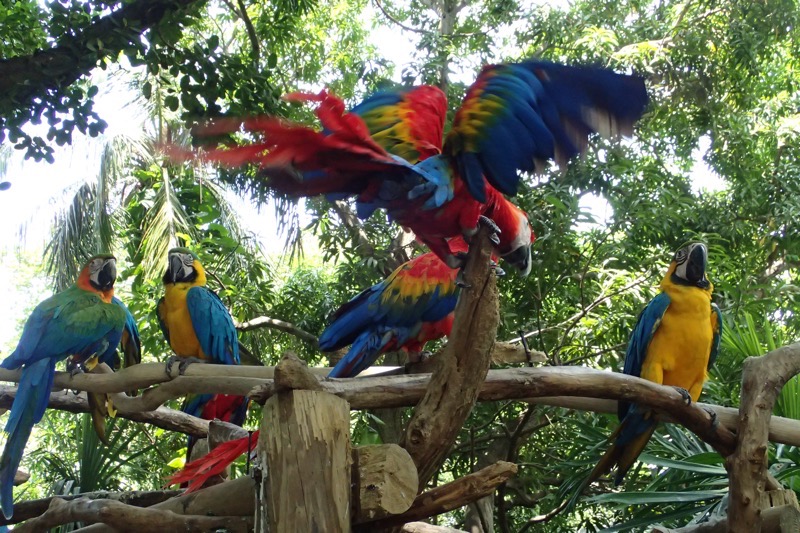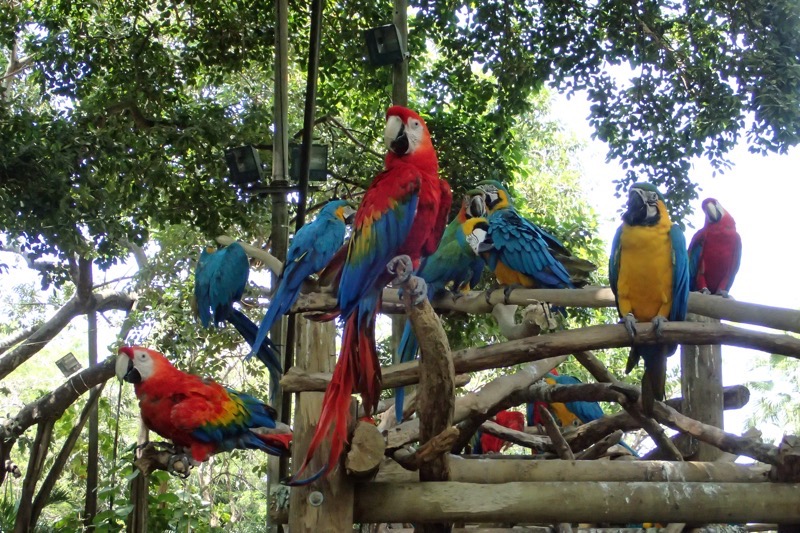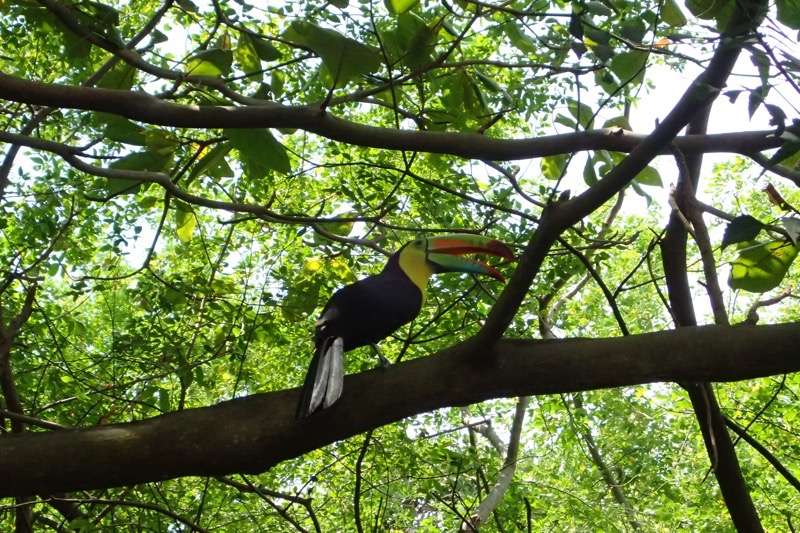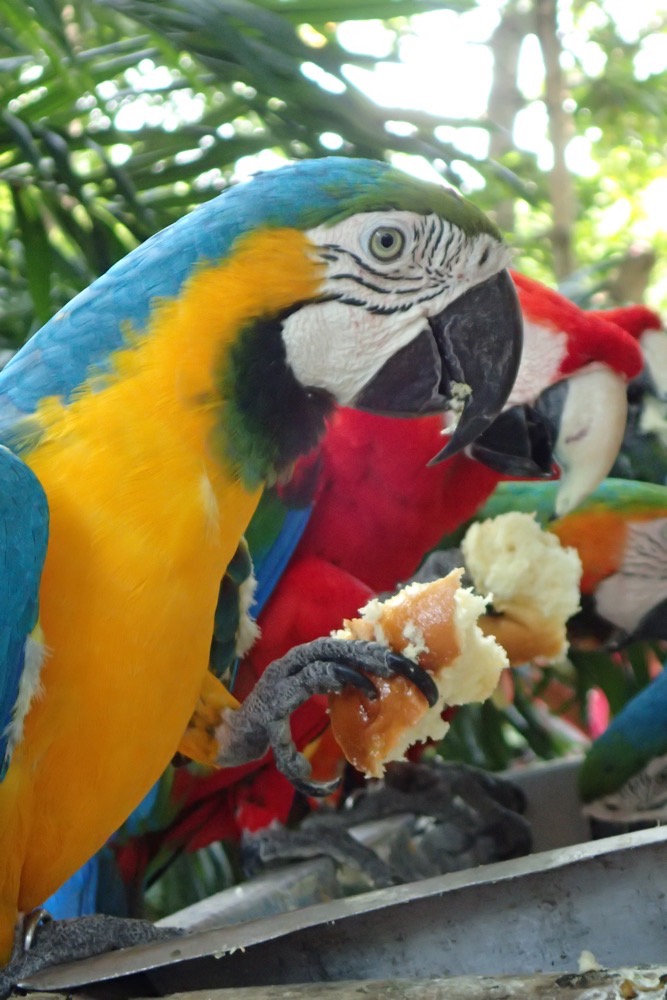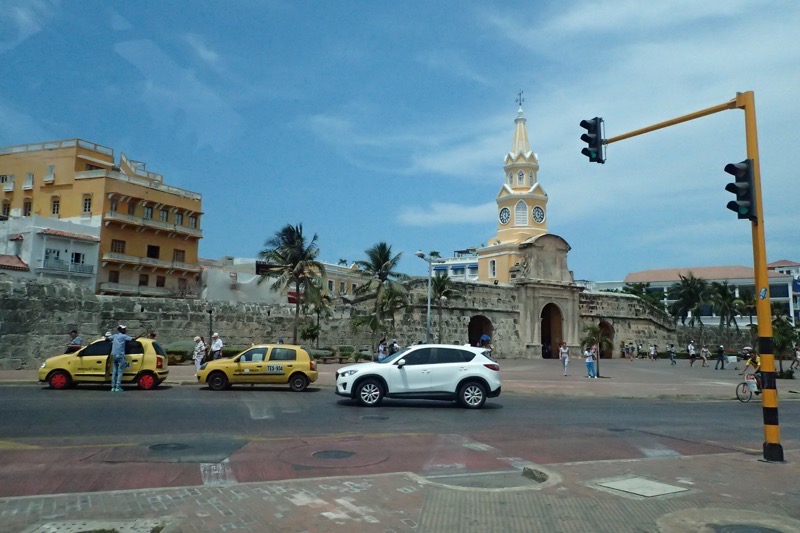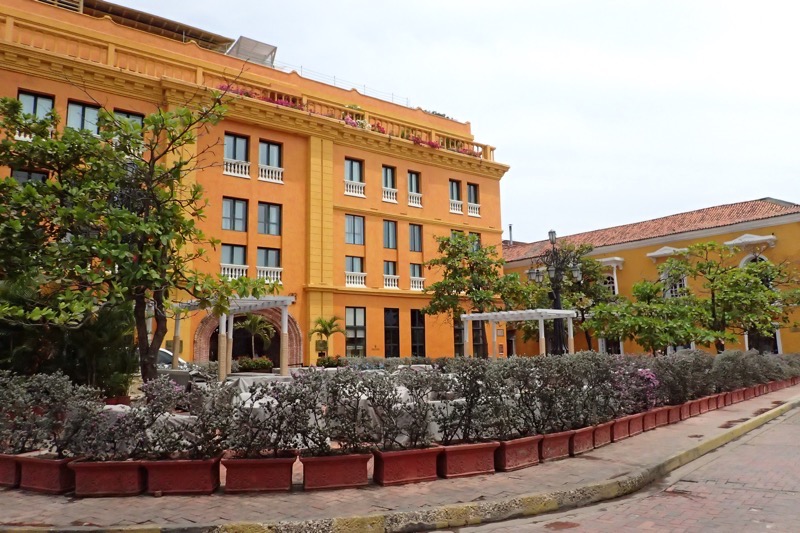Like everyone else who travels to South America, or indeed, like any traveller of any description, Machu Picchu has been ‘on my list’ for years. When we decided to do this huge South American cruise nearly two years ago, I started exploring options on the best way to accomplish doing a Machu Picchu overland tour to see this world famous heritage site. There is, of course, the Princess ship shore tour option… but once we saw the price of it – over AUS$5,000 per person (far out – that’s a whole ‘nother holiday!), and read reviews about the ship tours that seem to render it as a somewhat haphazard experience at best, it was time to do some research and find a better option.
So I hit the cruise forums and the travel advice websites and asked the good people on the Princess Cruises Passenger Forum on Facebook, and one name kept coming up over and over again – Jaime from Patagonia Shorex. ‘You have to do Machu Picchu with Jaime’ … and, ‘Jaime is absolutely the best for MP’. So I contacted Jaime and gave him the dates that our cruise was going to be in Manta and subsequently Lima, to see what he could do for us. Within hours, I had a proposed itinerary and, comparably, very reasonable rates… and within 24 hours, we had booked to do this amazing experience with Jaime. As time went on, I had more and more people join my group – people who had seen my post on Cruise Critic, or on Facebook, and some other people who had gone to Jaime directly after recommendations from their various travel agents. Over the course of the last 8 weeks on the ship, we have gotten to know most of our little group of Machu Picchu adventurers quite well – there was 22 in our group, and if the others were half as excited as I was about our impending detour of a lifetime, you could have bottled the anticipation.
Because I had booked first, the tour became “Robyn’s Group”, and we had arranged to meet in the Crooner’s Bar at 08:30 while I went down to administration to wait for Juliar – the lady who was holding out passports hostage! The plane to meet so early was because Juliar had told me that the Manta port in Ecuador has one of those horrid little shuttle systems to get you to the cruise ship terminal, and I thought we might need to get ourselves into the shuttle queue as early as possible – but late the night before I had word from Jaime, that he had managed to gain permission to bring his buses onto the port, right beside the ship, so we wouldn’t have to line up for the shuttles. Thank god for small mercies. Unfortunately the processing of the passports was taking longer than anticipated (very likely due to the local officials processing approximately 200 Princess ship tour passengers before processing any for private tour people) and it wasn’t until about 09:50 that I finally received all our passports and was able to disseminate them to our group so we could proceed ashore.
Eventually we walked off and there was Jaime waiting for us as promised. Big sigh of relief on my part – I willingly admit that I am never want to be head counting tourists again, I was so happy to see the professionals on the dock to take over. 🙂 Onto the bus, and off we went – headed for Guayaquil airport. On the way, we had a local guide, Daniel who was full of interesting information about Ecuador and the local area… if you’re not keen on reading about Ecuador, then skip down to “HERE!” below. 😛
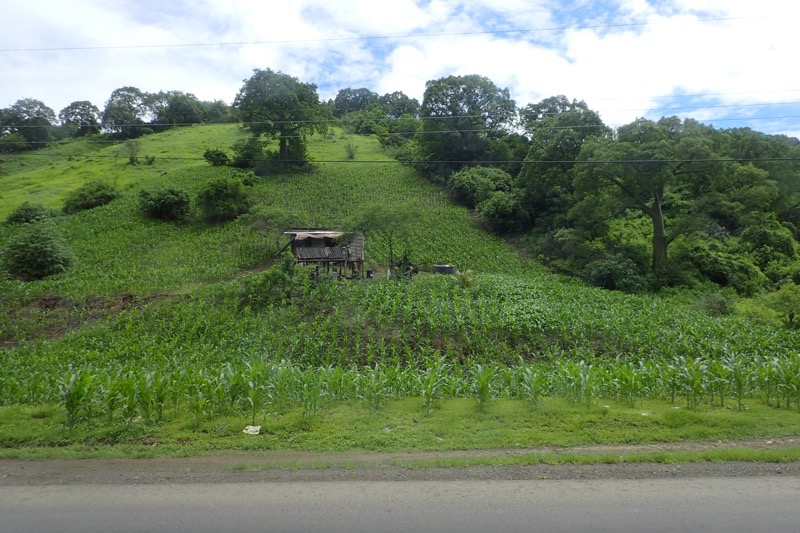
Ecuador was so named because the equator runs through it literally 0 0 0 degrees. Plenty of countries are on the equator, but French researchers who explored the country named it Ecuador and so it stayed.
One of the first places we drove through was a small town called Montecristi which is famous for its woven straw hats – better known as Panama Hats. Apparently, those ‘Panama’ hats actually originated in Ecuador. The weaving techniques used to make these hats had been used by indigenous people in this region for thousands of years, but Montecristi became famous for their hats when Theodore Roosevelt was responsible for all the workers on the Panama Canal being supplied with them in the early 1900s. It takes up to 7 days to hand weave a genuine Panama hat and they can cost hundreds if not thousands of dollars. Genuine Panama hats will always have a ‘Made in Ecuador’ label in them, so we are told, and the locals here refuse to call their Ecuadorian hats, Panama hats, instead they call them ‘sombreros de paja tequila’ which means, ‘tequila straw hats’. Unfortunately (or perhaps fortuitously depending on how you look at it), we did not have time to stop in this little town to go hunt for potentially expensive, genuine tequila straw hats. 🙂
Ecuador has several different regions consisting of the Pacific Coastal region, the Mountain region, the Sierra region and the Amazon region. As such it is very diverse in its agriculture, economy and even its population. Europeans, primarily Spanish, came to Ecuador in search or gold, silver, stones and spices, and they found some, but many of the indigenous learned to quickly hide these things from the Europeans.
Once away from the Coastal region, the countryside has very strong wet and dry seasons, which are predictable and happen abruptly ‘the seasons, they turn on and off like a tap’ according to Daniel. During the dry season, water is literally obtained from the excessive humidity in the air, and people use large areas covered in fabric to capture condensation and use this as a reliable water source.
The soil in much of Ecuador is of very good quality, thanks to over 75 volcanos, 15 of which are still active. The very rich volcanic soil allows most crops to grow anywhere from sea level regions to 4000 feet above sea level, and agriculture was once their biggest export – but now, it is oil. Coffee is still a major export crop, however Ecuadorians are not fond of their own strong coffees, and they send it all overseas… and I couldn’t believe this, but in Ecuador, they actually prefer crappy old Nescafé instant coffee over the beans they are famous for. Go figure.
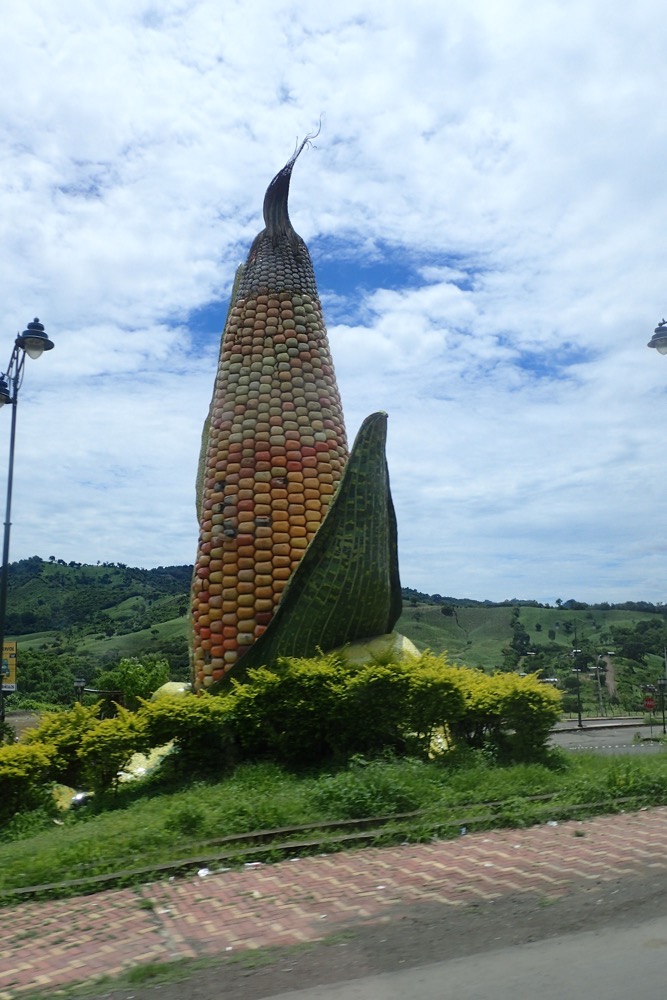
Being right on the equator means Ecuador gets 12 good hours of sunlight every single day, all year round. So they are able to grow all sorts of tropic fruits, mango orchards everywhere in the regions we are driving through, and rice of all things. Ecuador is huge on rice and they serve rice with nearly every meal, and lots of it as we were to discover. Oh and corn – I’ve never seen so many miles and miles of corn, and apparently they cultivate a gazillion varieties of the stuff.
Another famous and prolific export is, of course, the cacao for chocolate. Ecuador has exported cacao for over 200 years apparently and most of the cacao has been used in the US and Europe to turn into sweet milk chocolate products. But in the last ten years, Ecuador has changed their tactics, and started value adding by processing chocolate locally to create jobs and add a boost to their economy. They now produce many very fine chocolates – mostly dark chocolate products, and in particular they make unique chocolates with other local ingredients. For example, rich dark chocolate with the pink salt crystal mined in Cusco. We saw some of this at the airport, it was ridiculously expensive, but I may have to find some to take home for some of my chocolate loving friends, even though I don’t like the stuff myself.
What else? WWII saw some major changes in Ecuador, in part due to war rationing and a drop in demand for chocolate products, they needed a different income stream, and it was around this time that oil was found in Ecuador and has been a major export ever since. Oil is found in the Amazonian region of the country and according to Daniel, is largely responsible for the country’s prosperity now. Seriously, what prosperity? Everywhere we look, we see people living in poverty in lean to shanty housing and with no proper sanitation?! Really makes you wonder what it was like before the oil income? Diesel here is really cheap, around USD$1.00 per gallon because the government controls the prices and it has not changed in price for the last ten years. Speaking of money, Ecuador has no local currency, in 2000 they adopted the USD as their official currency, though they have the right to mint their own coins, these coins are not legal tender back in the US. It’s a weird arrangement – a completely independent nation that entirely uses a foreign currency. Very odd.
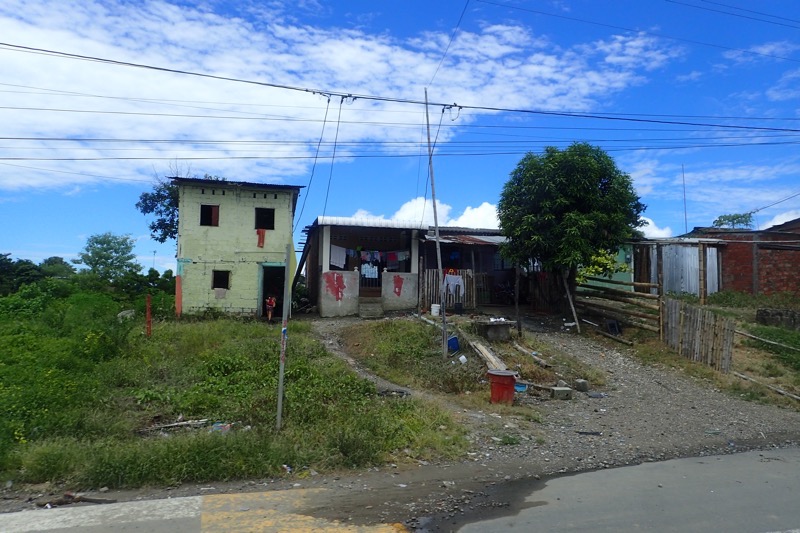
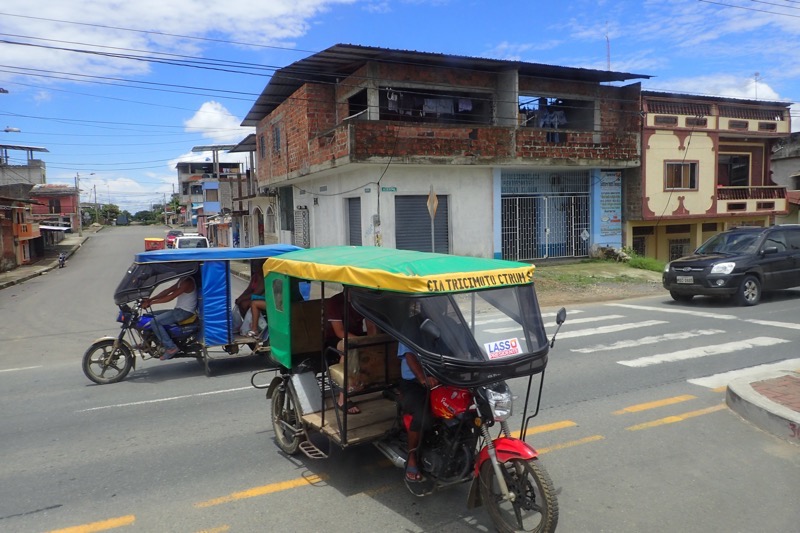 The saint of Guayaquil, who isn’t actually from Guayaquil and whose name I’ve forgotten… whoops. (Maybe I’ll come back and fix that if I ever return to the land of decent internet). Her name is Narcisa de Jesús Martillo y Moran.
The saint of Guayaquil, who isn’t actually from Guayaquil and whose name I’ve forgotten… whoops. (Maybe I’ll come back and fix that if I ever return to the land of decent internet). Her name is Narcisa de Jesús Martillo y Moran.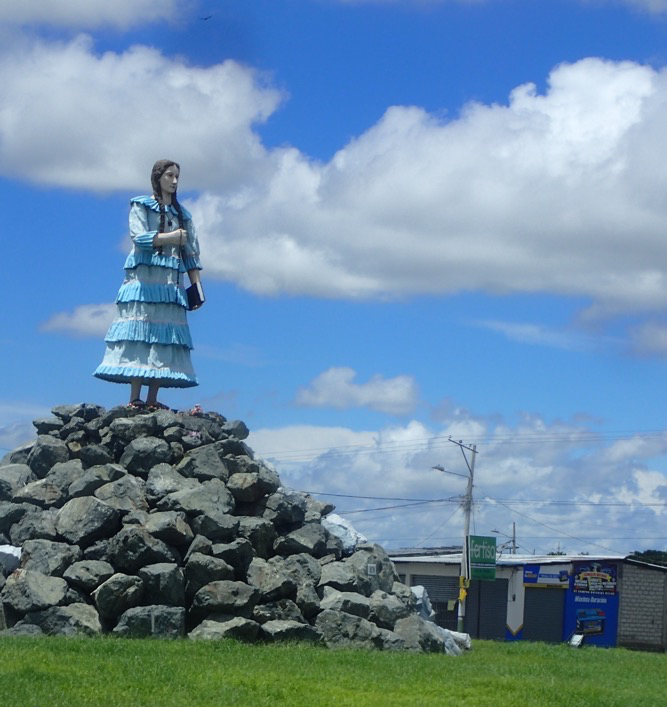
“HERE” 😛
Anyway, many mango orchards and rice paddy fields later, we arrived at Guayaquil. First things first – lunch. We went to a really lovely local restaurant called, Puerto Moro, where we started in on some fresh made lemonade and weird, but delicious, cheesy rice balls for a starter. We then had a big choice to make, ‘chicken or meat’. I’ve noticed that in South America, chicken is always distinguished from meat, but if you want to know if they are offering you beef, pork or lamb in that ‘meat’ selection – you’ll have to actually enquire. Lunch was very nice – I opted for the chicken and it was cooked in an unusual herb mixture and served with salad, plantains, and (you guessed it!) a big pile of rice
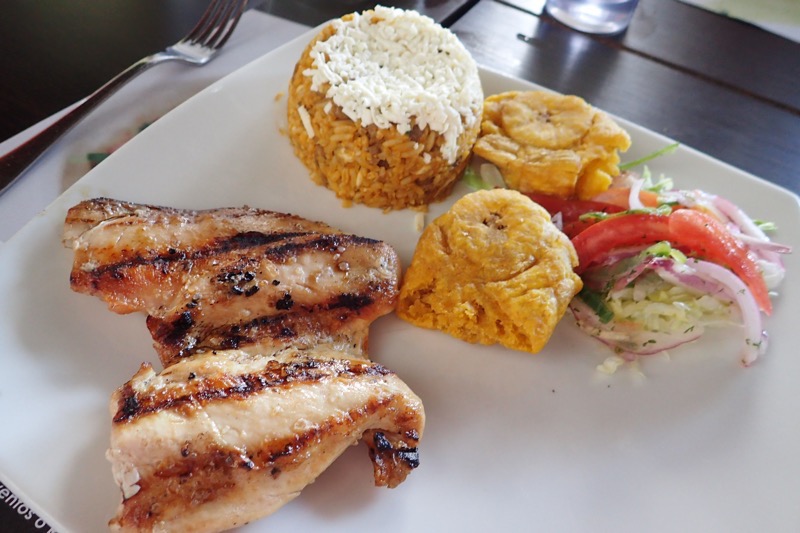
After this we made our way to the Guayaquil airport, where I was surprised to find a large international airport as modern as any I’ve visited anywhere in the world. It was really quite incongruous with the obvious poverty we had witnessed on our drive to get there – huge duty free store, expensive straw tequila hats for sale, gift shops, book shops, coffee shop and a bar… and all very modern and clean. It’s easy to see where recent infrastructure spending has gone. Processing through customs was a bit err… interesting though. We waited in a queue for about 45 minutes to get through customs in spite of the fact that there was about 8 people processing and seemingly not that many people in front of us. When I got to the front of the queue, it became obvious that something was amiss. Some passports were scanning fine and being processed relatively quickly, but many were not – including mine. The customs officer who processed my passport was pfaffing around a lot (I’m used to this, given my previously documented experiences with a passport with a prominent Pakistani visa in the front), but it wasn’t scanning for her. In the end she gave up and took a used what looked like her personal mobile phone, the gold sparkly phone cover was a giveaway, to take a picture of the page with my entry and exit stamps and the photo page of my passport! I was somewhat perturbed by that, but saw other customs officers doing the same thing! Hmmm….
Then it was time to wait. Transit days tend to be filled with ‘hurry up and wait’ and this one was no different. We were all processed in and in the boarding gate and we had over two hours until our flight was scheduled to depart. We chatted among ourselves, and mostly engaged in that most enjoyable pastime, people watching, until eventually our flight was called and we all boarded.
The flight was just the way we like them, uneventful. The only oddity was being handed a customs declaration form to fill out – in Spanish! We muddled through the forms as best we could and tried to get assistance from the airline staff, but I still felt uneasy about signing a document in a foreign language that I couldn’t read! We arrived at Lima after barely a 1.5hr flight, and again with the customs nonsense, though this time the process went much smoother. I think we are a bit spoiled in Australia, being such a large continent with a singular national government means you can travel quite a long way on the one mainland before you need to deal with customs.
Eventually we popped out the other end at Lima and made the arduous trek to our hotel… the Costa del Sol Wyndham Hotel at Lima airport – literally two minutes walk from the airport doors! It is a lovely modern hotel that is very well appointed. What an excellent choice, for proximity and convenience, seeing we are flying out first thing tomorrow. We wheeled our little cabin bags across the road, handed over passports, had room keys, stashed our stuff, freshened up, and were then happily situation in the hotel bar enjoying complimentary pisco sours, all within about 30 minutes of having left the airport. 🙂

It was a long, but strangely informative, transit day and most of us were all free wifi’d out by 11:30pm so we turned in fairly early.
Tomorrow: Cusco… onward and upwards, literally!

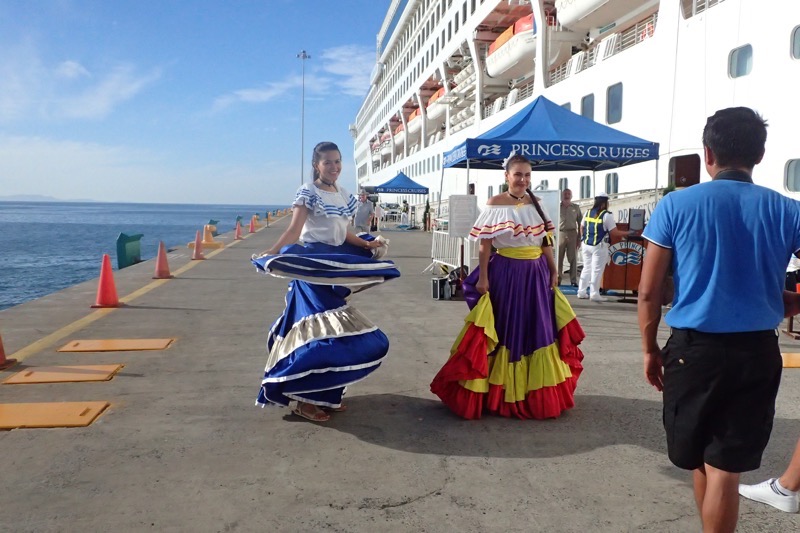 Puntarenas was discovered by Hernan Ponce de Leon in 1519 and is located south of Nicaragua and north of Panama… on one side of the country is the Pacific Ocean side and to the other, the Caribbean. The city of Puntarenas is surrounded by lush rainforests full of tropical plants, exotic animals and plenty of outdoor adventure activities. The rainforest here is really quite odd – it is a strange blend of dry forest meeting the edge of typical tropical rainforest, but because we are here in the middle of the dry season, everything has a thick layer of dust over it… it was very unusual to see rainforest looking like a tinderbox and covered in dust.
Puntarenas was discovered by Hernan Ponce de Leon in 1519 and is located south of Nicaragua and north of Panama… on one side of the country is the Pacific Ocean side and to the other, the Caribbean. The city of Puntarenas is surrounded by lush rainforests full of tropical plants, exotic animals and plenty of outdoor adventure activities. The rainforest here is really quite odd – it is a strange blend of dry forest meeting the edge of typical tropical rainforest, but because we are here in the middle of the dry season, everything has a thick layer of dust over it… it was very unusual to see rainforest looking like a tinderbox and covered in dust.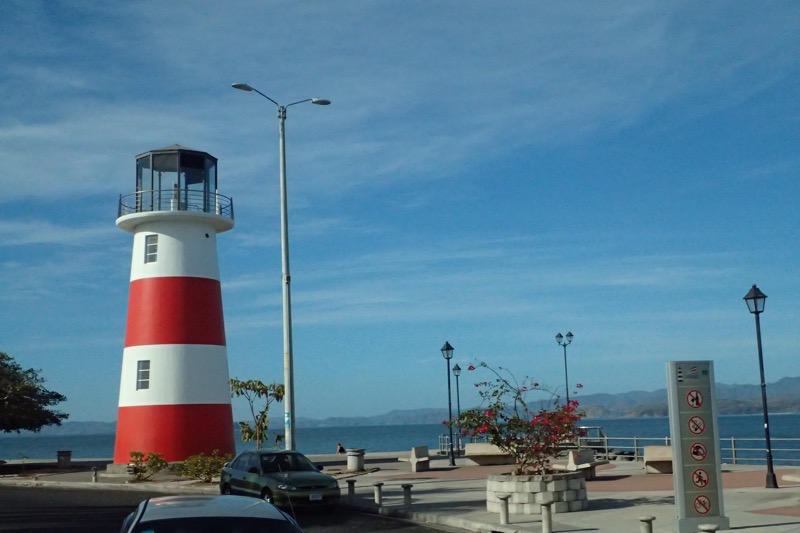

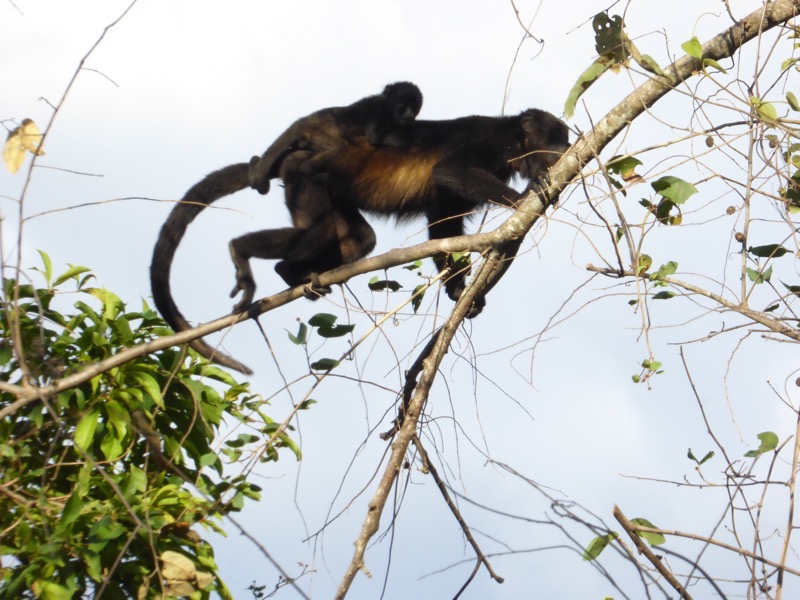
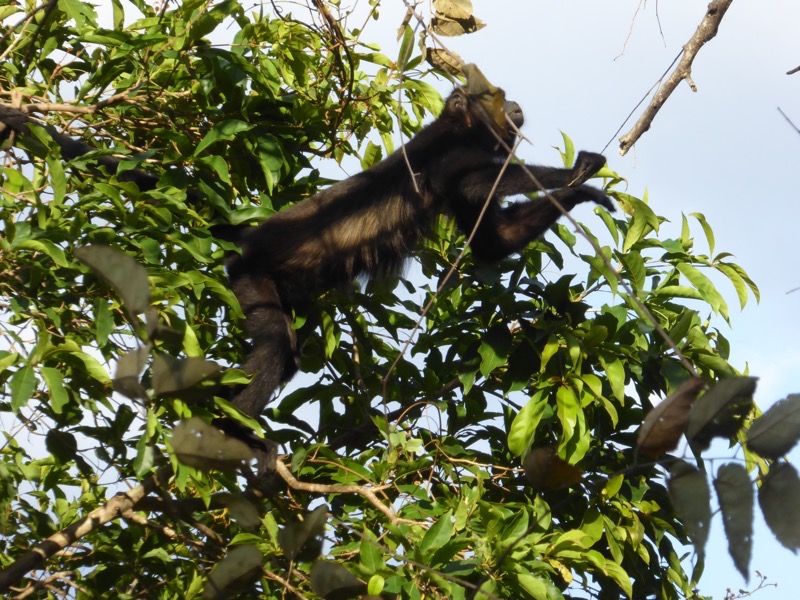 Costa Rica is very famous for its lush tropical fruit exports, and we made a quick stop at a fruit stall to sample all the beautiful fruits and to stock up on lovely cold fruit smoothies. The mango was absolutely delicious! So many beautiful fresh fruits, I can imagine if you came down here on holiday from somewhere like Michigan or something, you’d think it was paradise.
Costa Rica is very famous for its lush tropical fruit exports, and we made a quick stop at a fruit stall to sample all the beautiful fruits and to stock up on lovely cold fruit smoothies. The mango was absolutely delicious! So many beautiful fresh fruits, I can imagine if you came down here on holiday from somewhere like Michigan or something, you’d think it was paradise.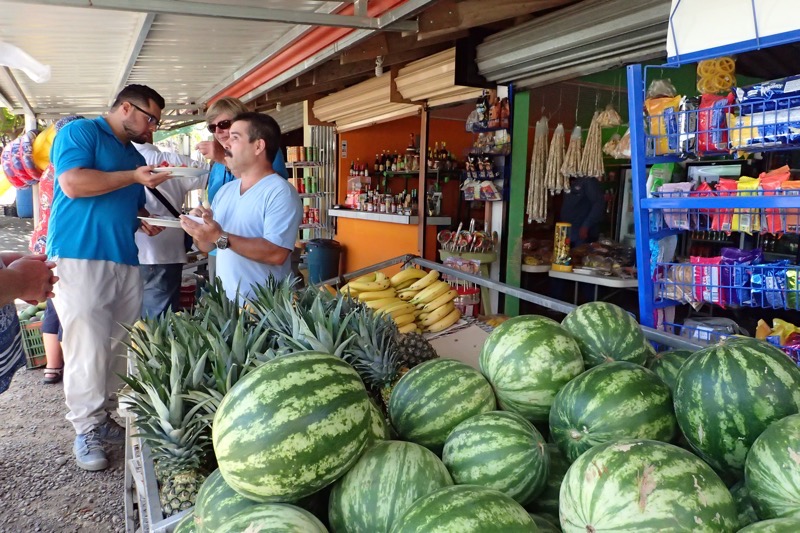
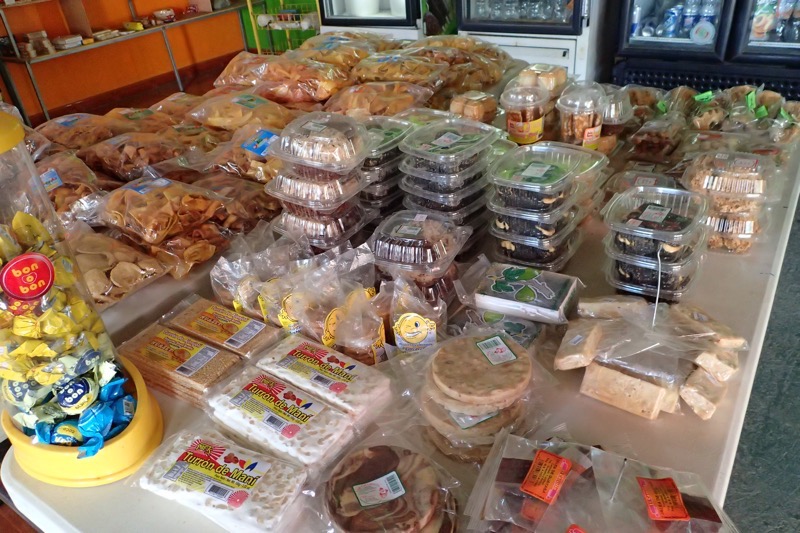
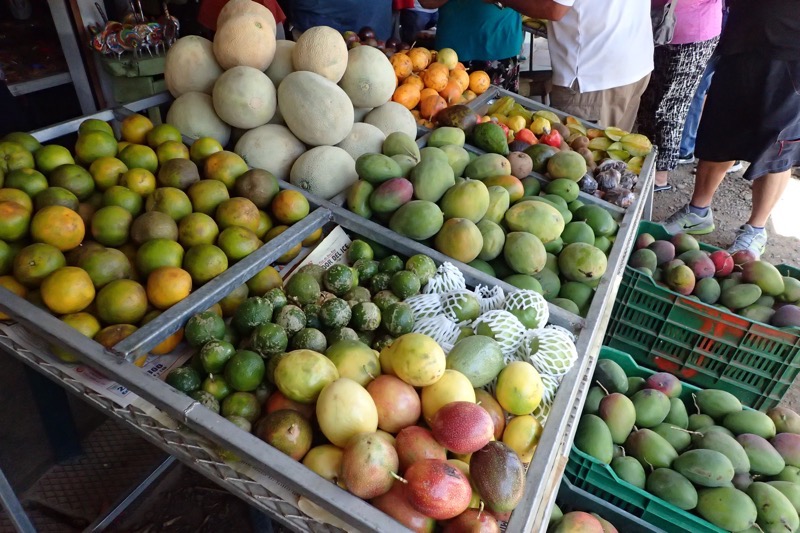 Also for the tourists to try, was some freshly squeezed sugar cane juice, and they demonstrated for us how it was traditionally extracted from the cane. It was very sweet and brought back memories of chewing and sucking on raw sugar cane up in Hervey Bay when i was a kid.
Also for the tourists to try, was some freshly squeezed sugar cane juice, and they demonstrated for us how it was traditionally extracted from the cane. It was very sweet and brought back memories of chewing and sucking on raw sugar cane up in Hervey Bay when i was a kid.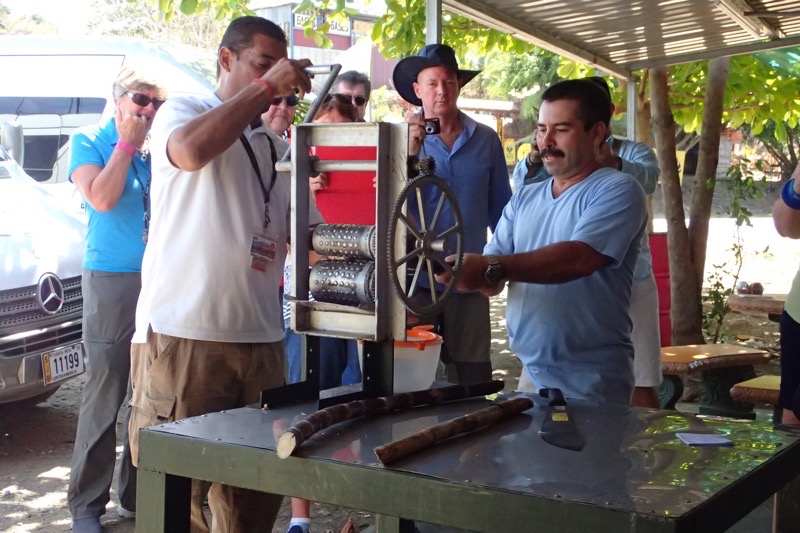 We stopped also at a cashew orchard, and while all of us knew that cashews were a tree nut, none of us had ever seen a cashew tree before… the cashews comes from this enormous fruit, most of which is barely edible and part of which is actually toxic. And seeing this, and seeing how much is wastage, I now understand why cashews are so expensive.
We stopped also at a cashew orchard, and while all of us knew that cashews were a tree nut, none of us had ever seen a cashew tree before… the cashews comes from this enormous fruit, most of which is barely edible and part of which is actually toxic. And seeing this, and seeing how much is wastage, I now understand why cashews are so expensive.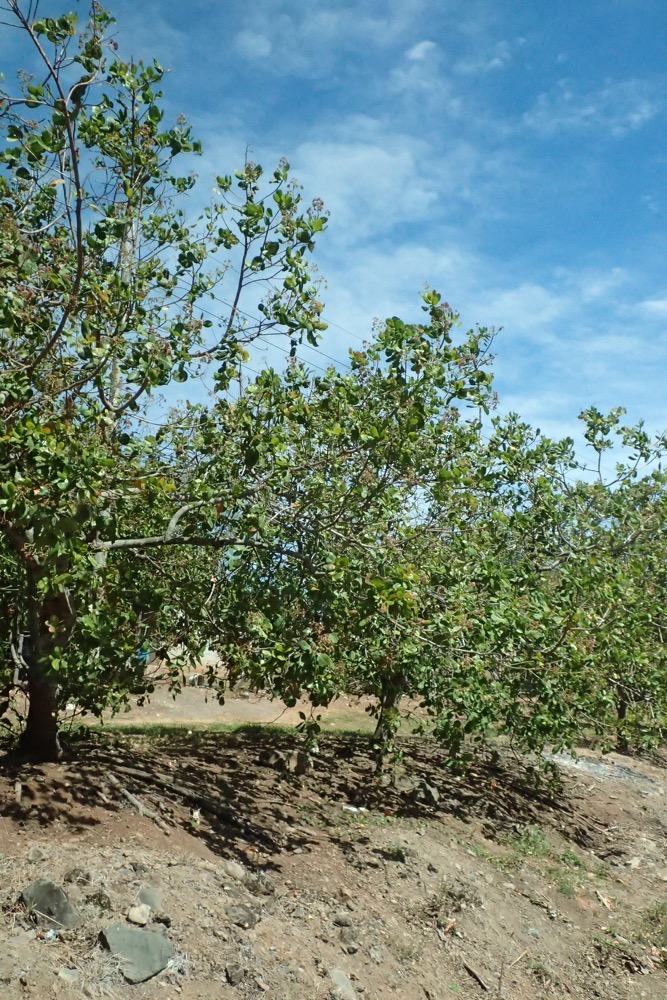
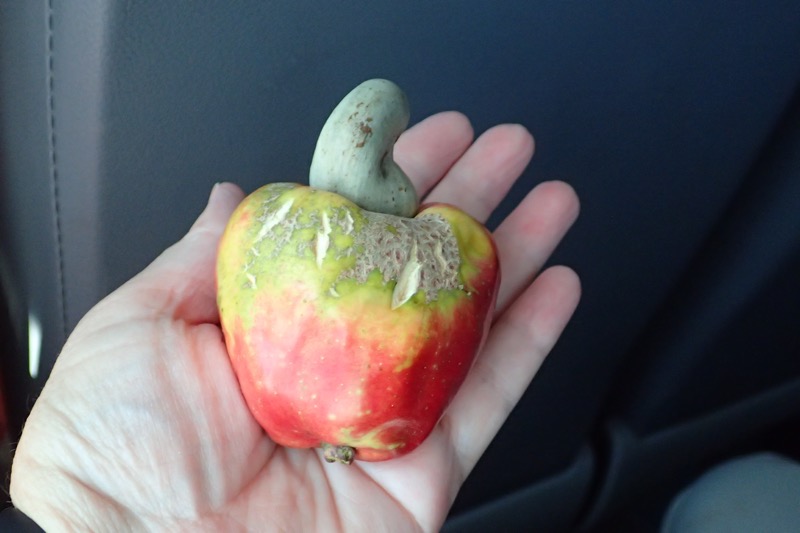
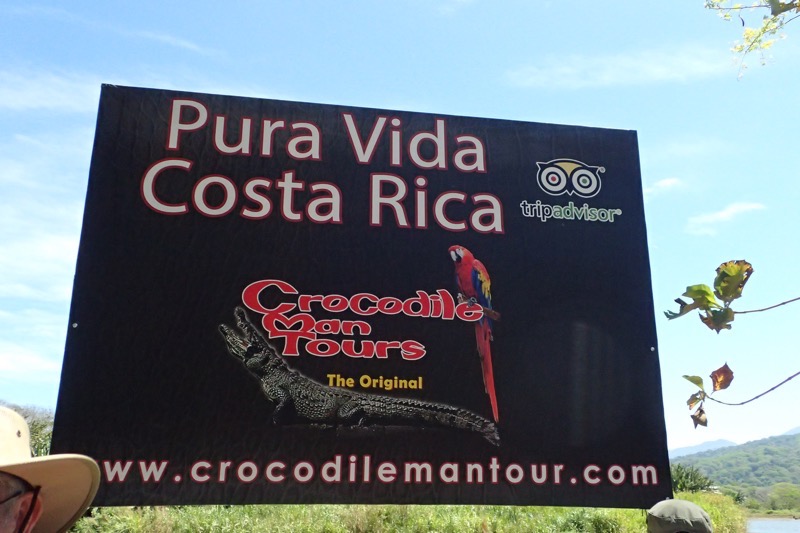
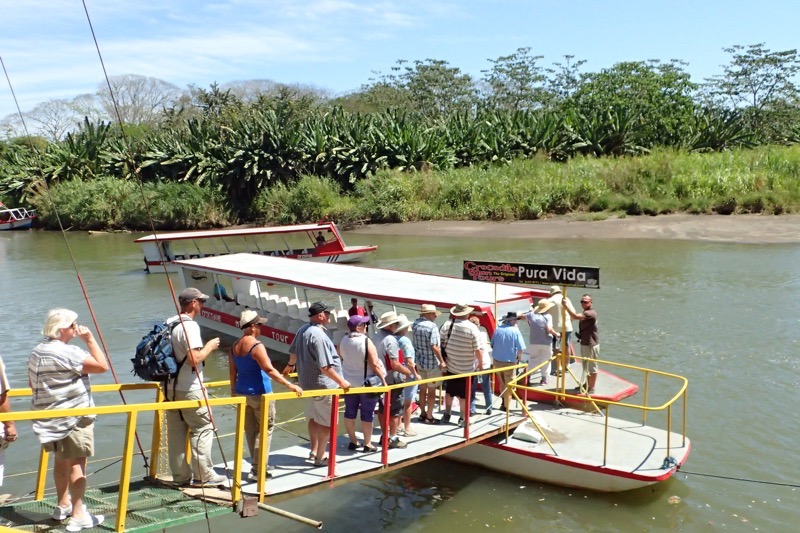
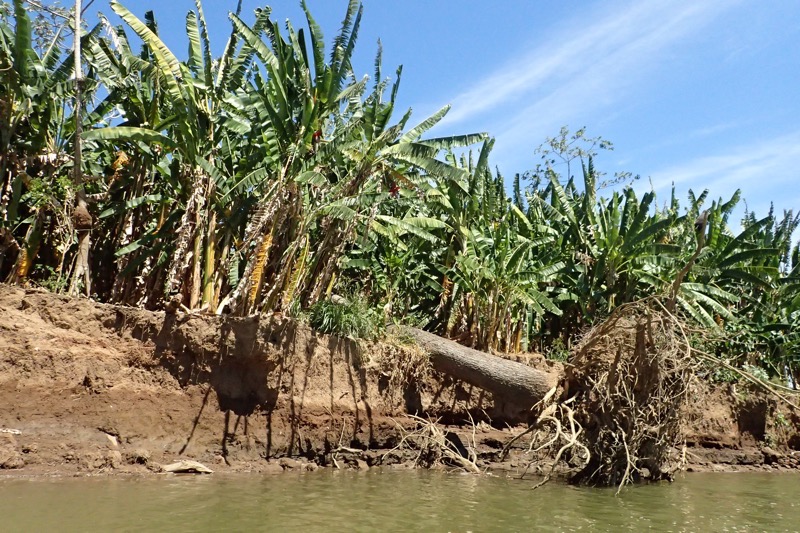 This fellow was named ScarFace – I couldn’t quite make out the reason for his name sake, I was too distracted by Ruiz our boat driver climbing out into the water to hand feed the bloody big thing with a piece of chicken! ScarFace must have been close to 4m long and probably a few hundred kilos, and I’m pretty sure he could make short work of Ruiz if he decided to…
This fellow was named ScarFace – I couldn’t quite make out the reason for his name sake, I was too distracted by Ruiz our boat driver climbing out into the water to hand feed the bloody big thing with a piece of chicken! ScarFace must have been close to 4m long and probably a few hundred kilos, and I’m pretty sure he could make short work of Ruiz if he decided to…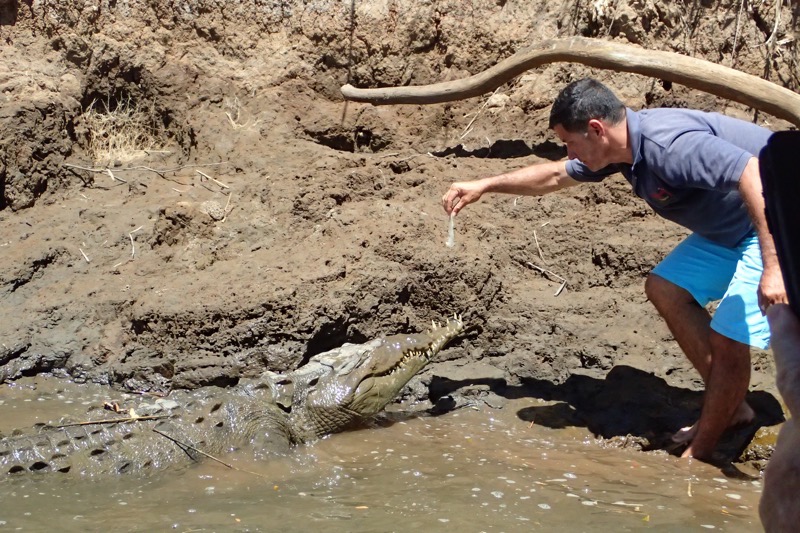
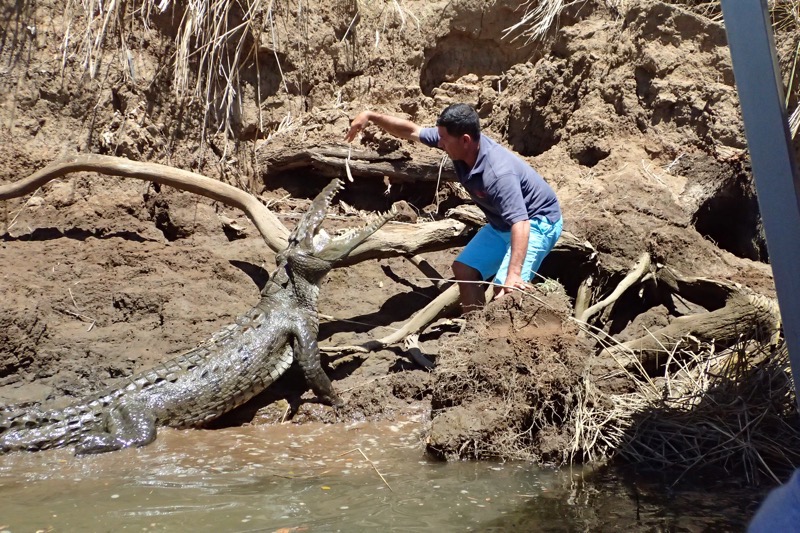 There is something very sly looking about crocodiles when they are just still and watching you… :/
There is something very sly looking about crocodiles when they are just still and watching you… :/ 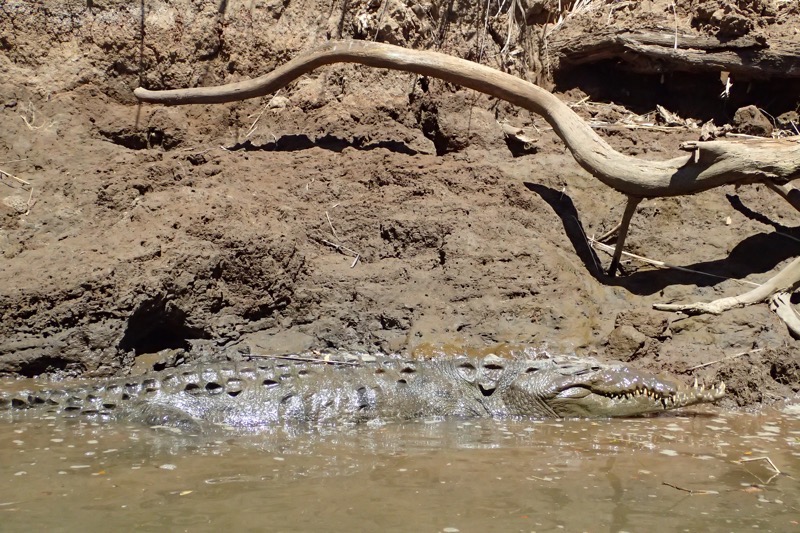 This big one was closer to 5m long, and nicknamed Tornado ever since he was seen death rolling a COW that had come down the bank to drink from the river. A COW!
This big one was closer to 5m long, and nicknamed Tornado ever since he was seen death rolling a COW that had come down the bank to drink from the river. A COW! 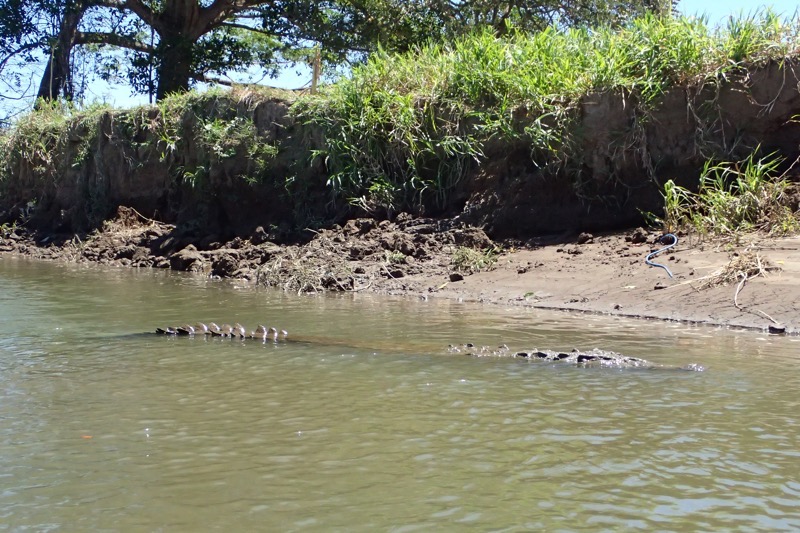 Grey-blue great heron… very pretty, and presumably very fast if they can survive here with their snappy aquatic neighbours.
Grey-blue great heron… very pretty, and presumably very fast if they can survive here with their snappy aquatic neighbours.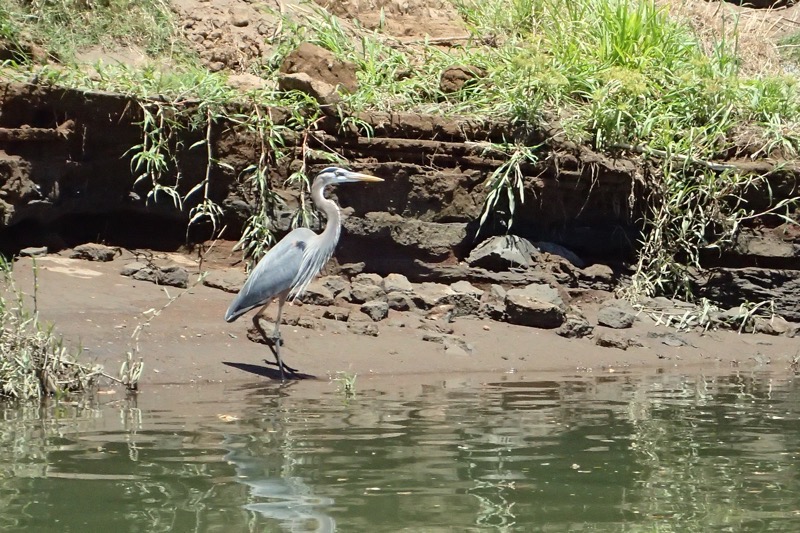
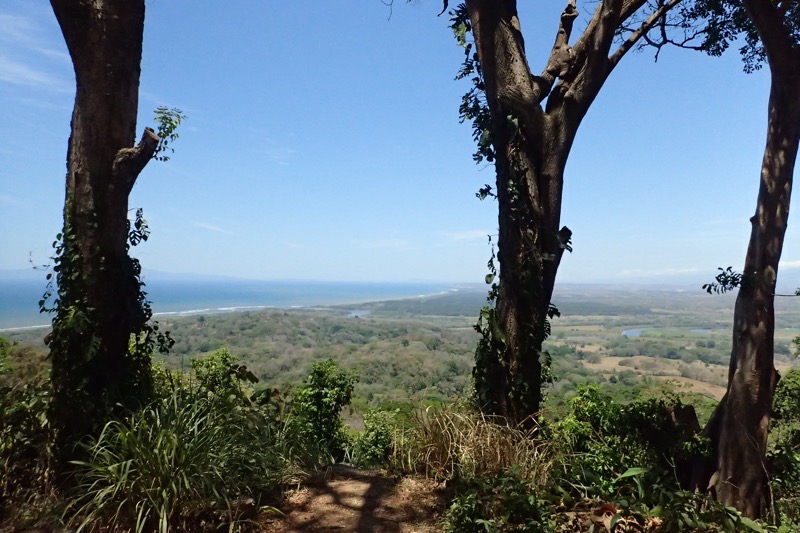 Quaint little restaurant at the top of the mountain – the Waterfall of Love, which sounded like a tacky carnival ride, but was closed so I couldn’t go and see what I was certain was going to be very interesting decor!
Quaint little restaurant at the top of the mountain – the Waterfall of Love, which sounded like a tacky carnival ride, but was closed so I couldn’t go and see what I was certain was going to be very interesting decor!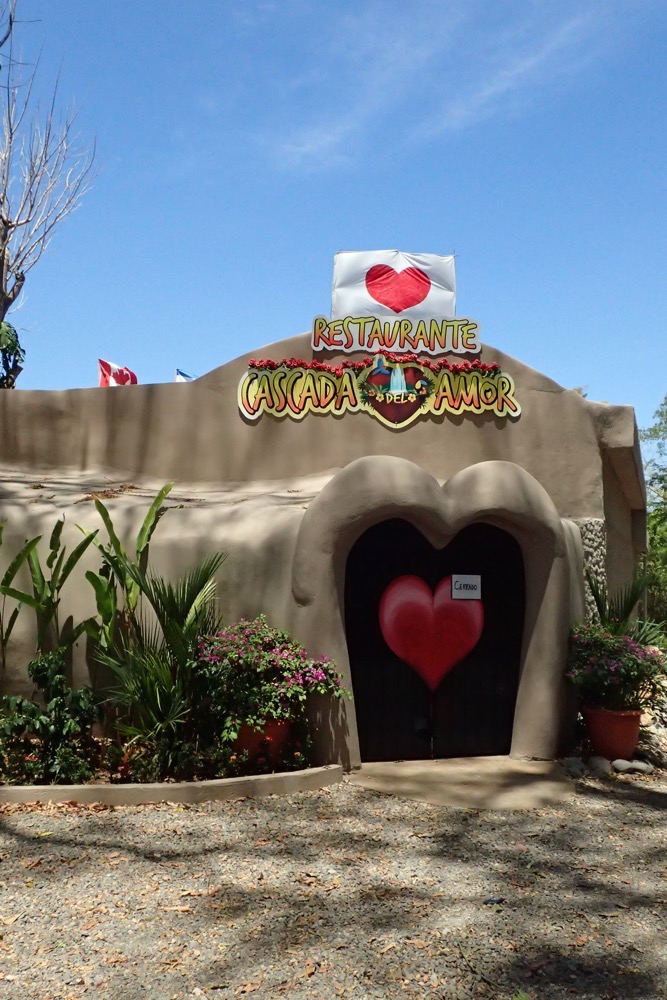 After this we went to Villa Lapa, which is a resort area that has been built in the style of a traditional Costa Rican village. Andres was very well versed on all the plants, trees, fruits, animals and insects of the region and pointed out 1001 different tropical plants… many of which were very familiar to Australians. We did try to communicate that a lot of the plants he was telling us about in some detail, were growing quite happily in our gardens at home, but alas, he persisted comments like, “My friends, look here, you must see this – it is called a bromeliad/cicada/poinciana.” Le sigh…
After this we went to Villa Lapa, which is a resort area that has been built in the style of a traditional Costa Rican village. Andres was very well versed on all the plants, trees, fruits, animals and insects of the region and pointed out 1001 different tropical plants… many of which were very familiar to Australians. We did try to communicate that a lot of the plants he was telling us about in some detail, were growing quite happily in our gardens at home, but alas, he persisted comments like, “My friends, look here, you must see this – it is called a bromeliad/cicada/poinciana.” Le sigh…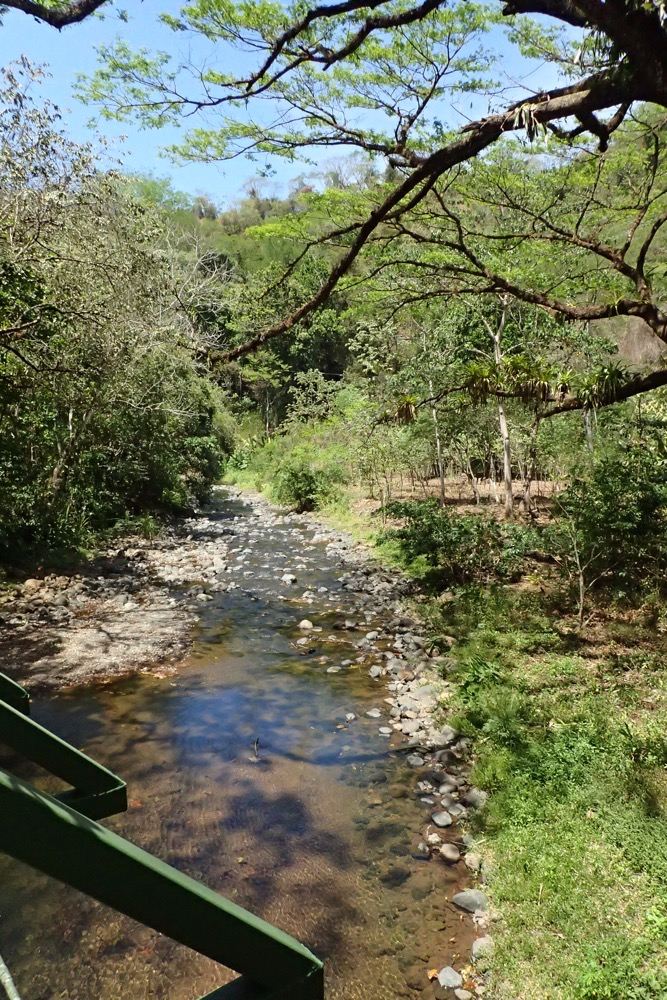
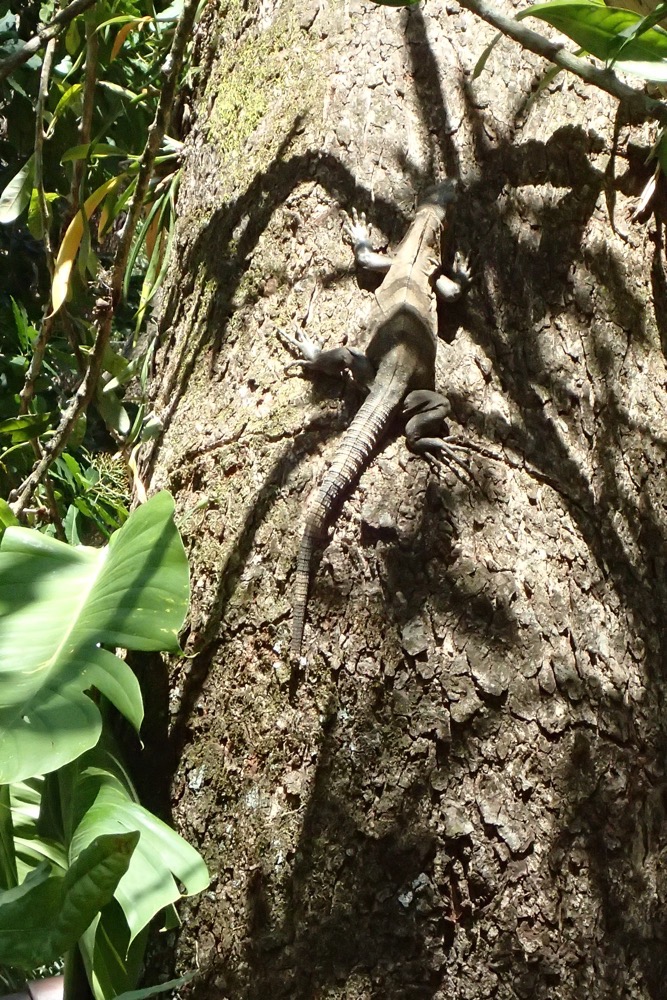 Village entrance.
Village entrance.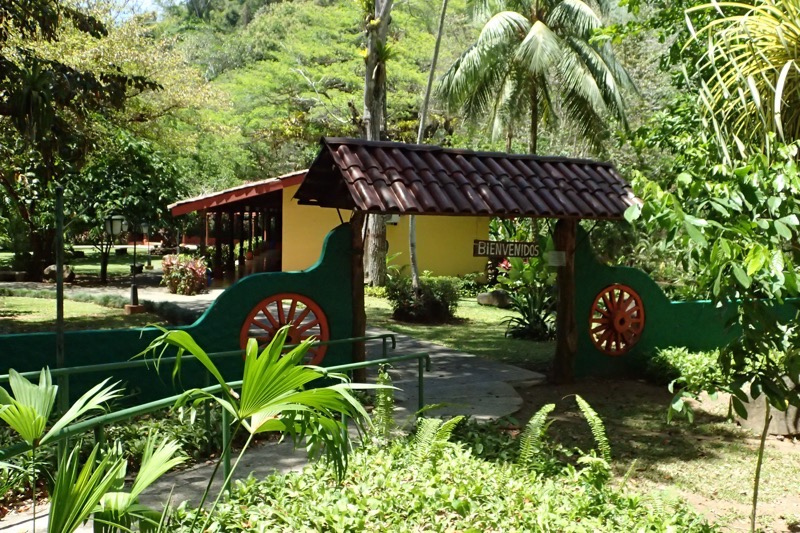
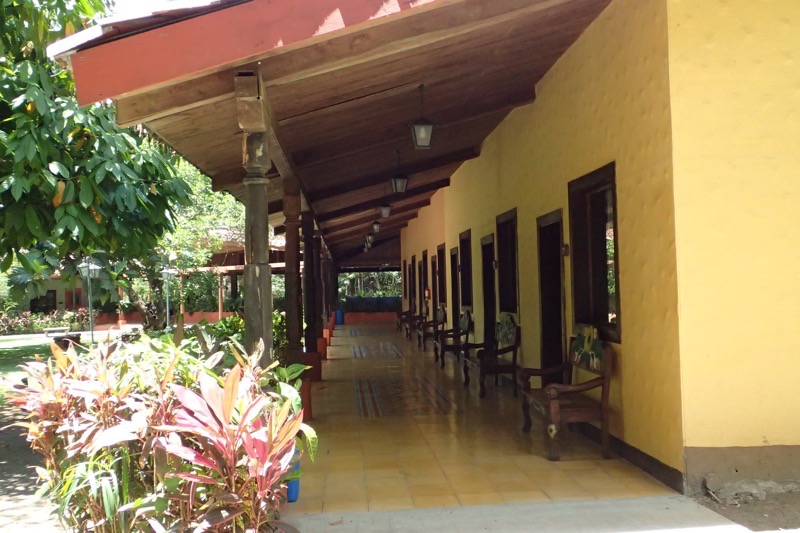 Typical village Catholic church
Typical village Catholic church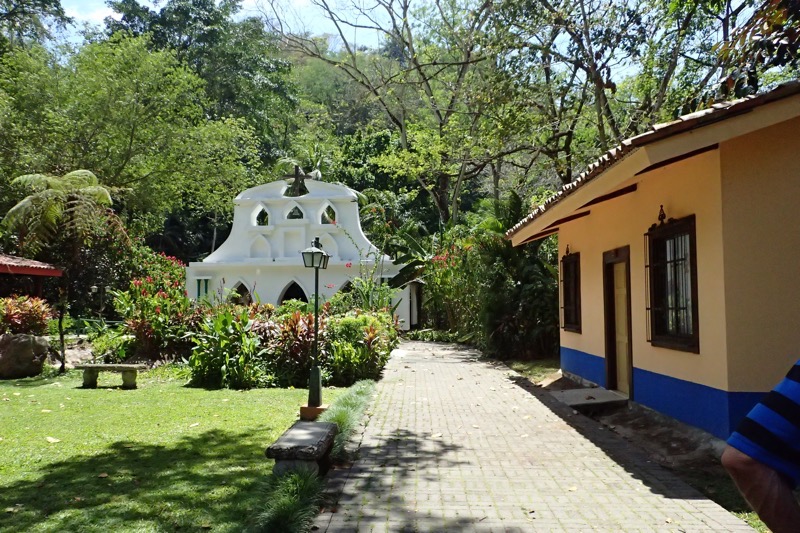
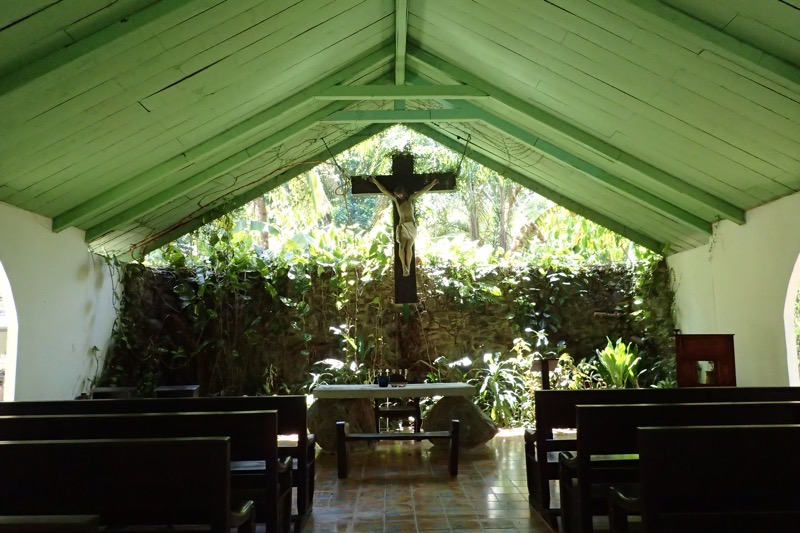 A barn/tavern
A barn/tavern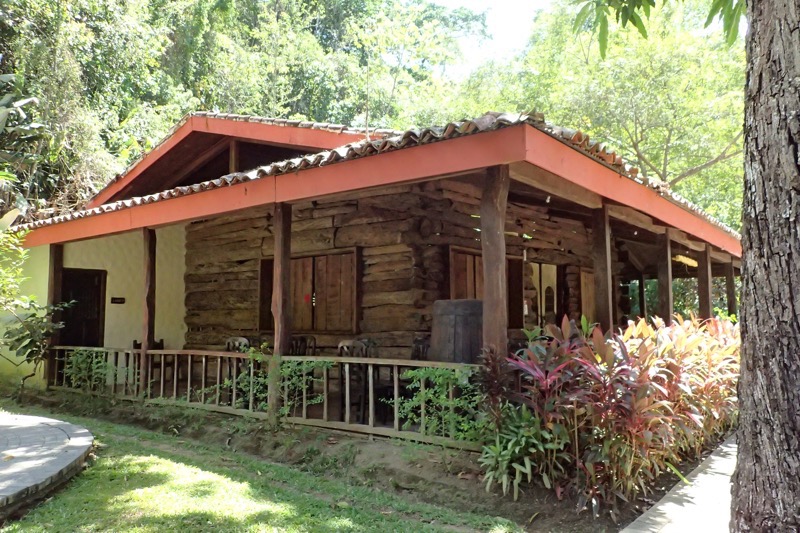
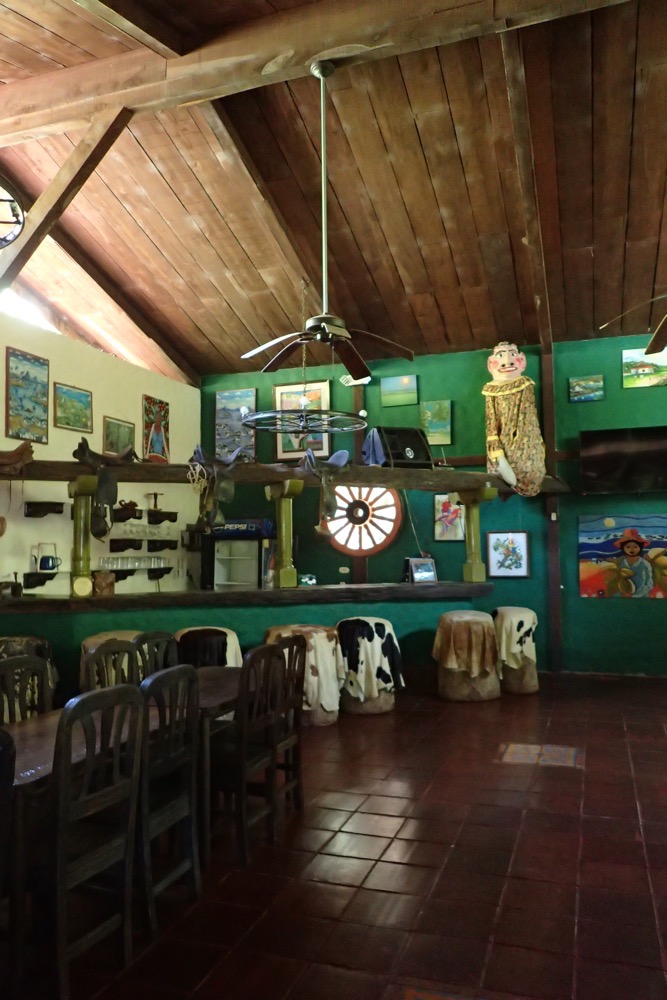 After the village we drove to Playa de Leone for some lunch in a very colourful local restaurant with lovely food and cheap ice cold beer… very welcome given it was about 34C and 85% humidity.
After the village we drove to Playa de Leone for some lunch in a very colourful local restaurant with lovely food and cheap ice cold beer… very welcome given it was about 34C and 85% humidity.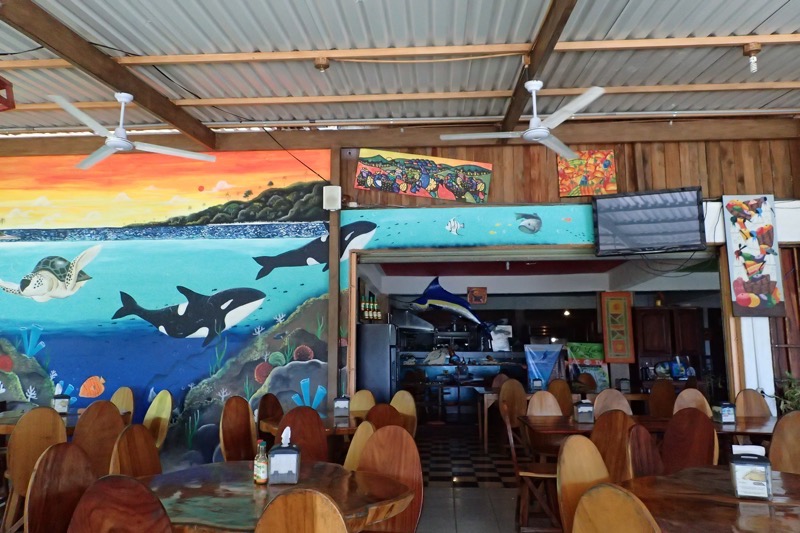
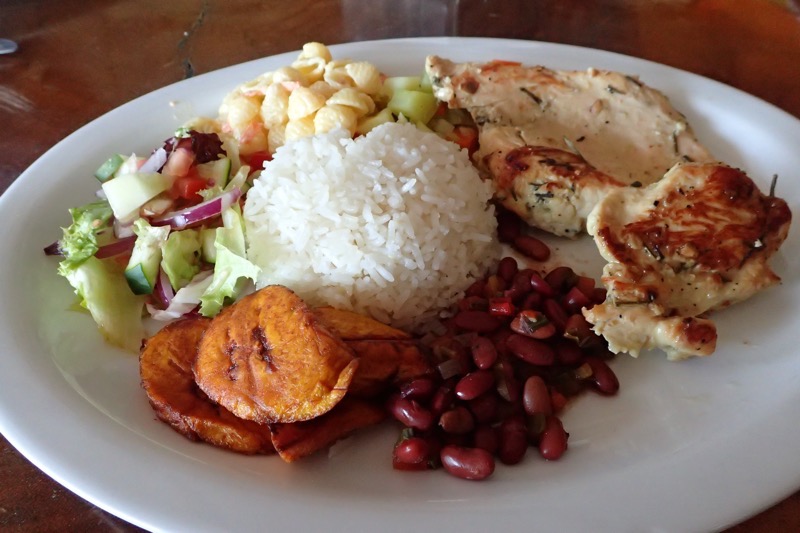
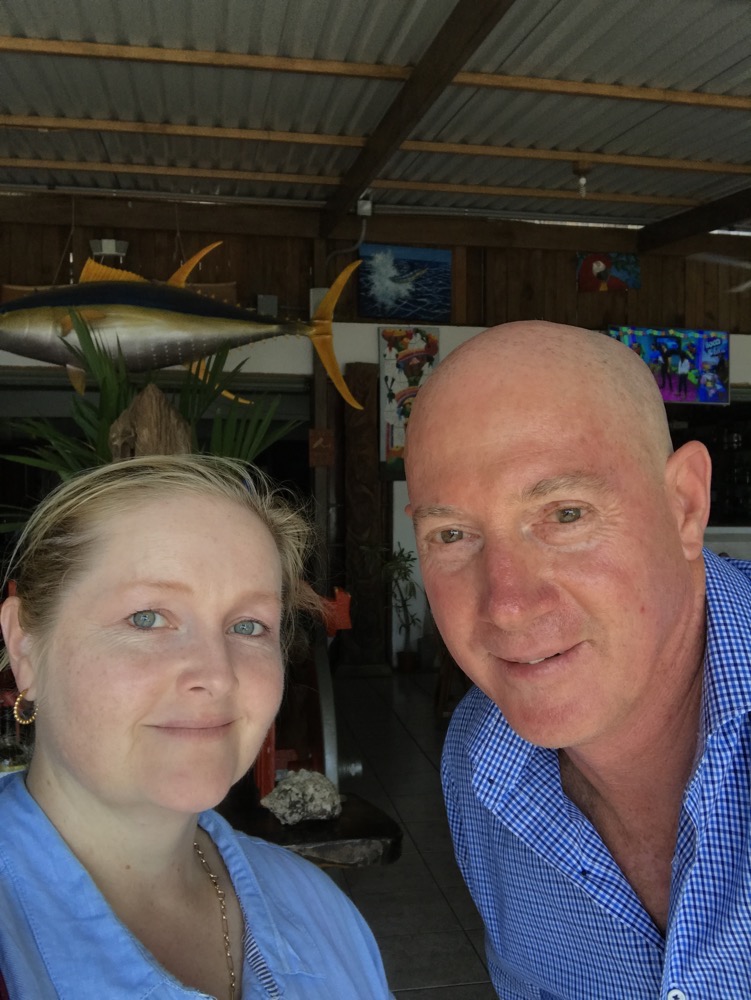 I found myself having lunch with this guy – who I had seen around the ship quite a bit and who looked very familiar. I assumed (incorrectly) that he looked familiar because we had been on tour together at some point… but after barely two minutes conversation over lunch, he said he too thought I was familiar and it turns out we both belong to the SSAA at Belmont and have both been volunteering there for RASA days for the last few years, just in different disciplines! Talk about going half way around the world to meet someone from just around the corner!
I found myself having lunch with this guy – who I had seen around the ship quite a bit and who looked very familiar. I assumed (incorrectly) that he looked familiar because we had been on tour together at some point… but after barely two minutes conversation over lunch, he said he too thought I was familiar and it turns out we both belong to the SSAA at Belmont and have both been volunteering there for RASA days for the last few years, just in different disciplines! Talk about going half way around the world to meet someone from just around the corner!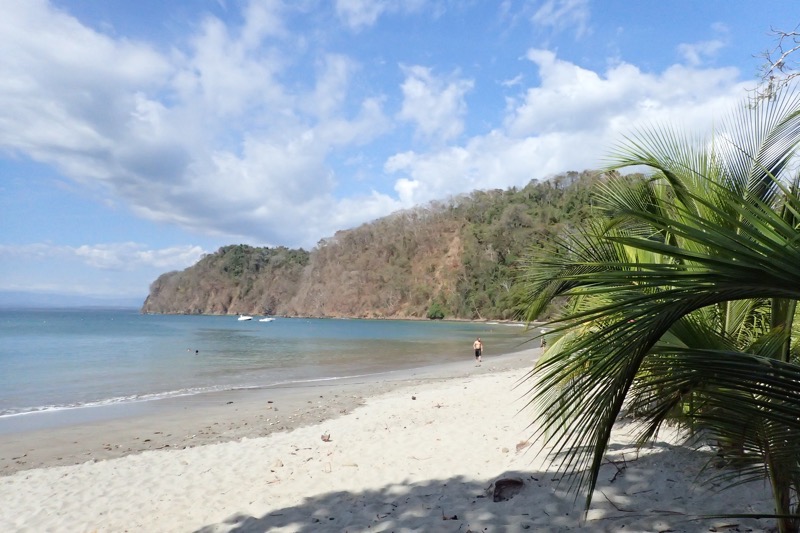
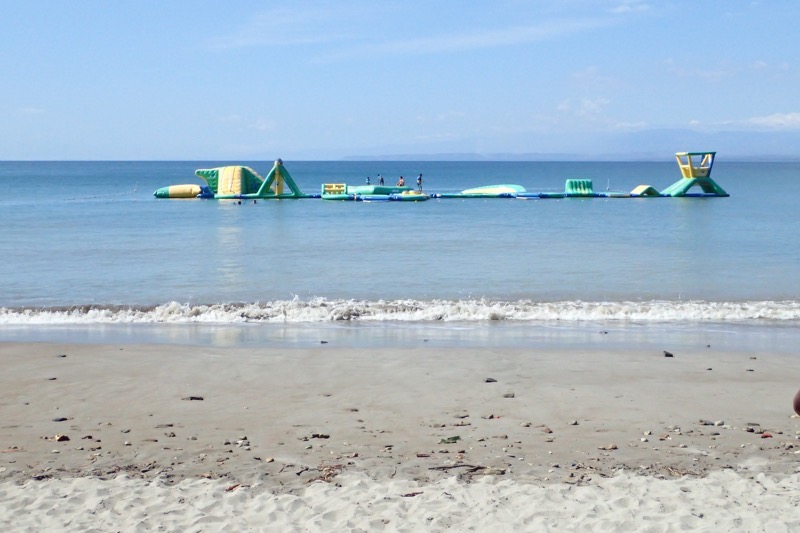
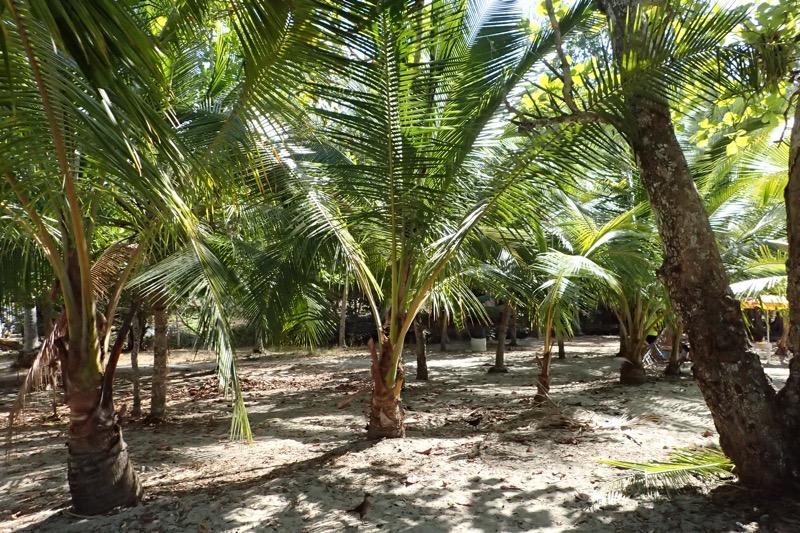 From here we made our obligatory souvenir shopping stop. Costa Rica has lots of beautiful timber products made from Rosewood, Tigerwood, Purple Heart, Cortex, Fustic, Ironwood, Teak, Lacewood and Guapinol to beautiful effect.
From here we made our obligatory souvenir shopping stop. Costa Rica has lots of beautiful timber products made from Rosewood, Tigerwood, Purple Heart, Cortex, Fustic, Ironwood, Teak, Lacewood and Guapinol to beautiful effect.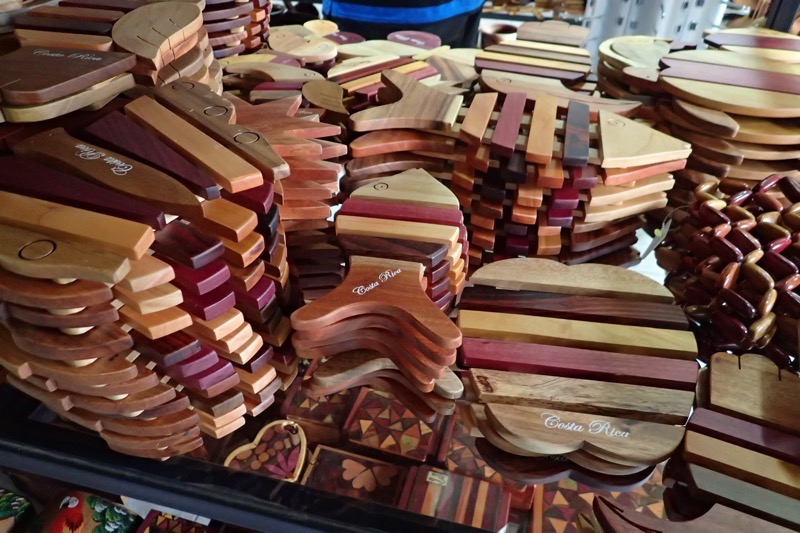
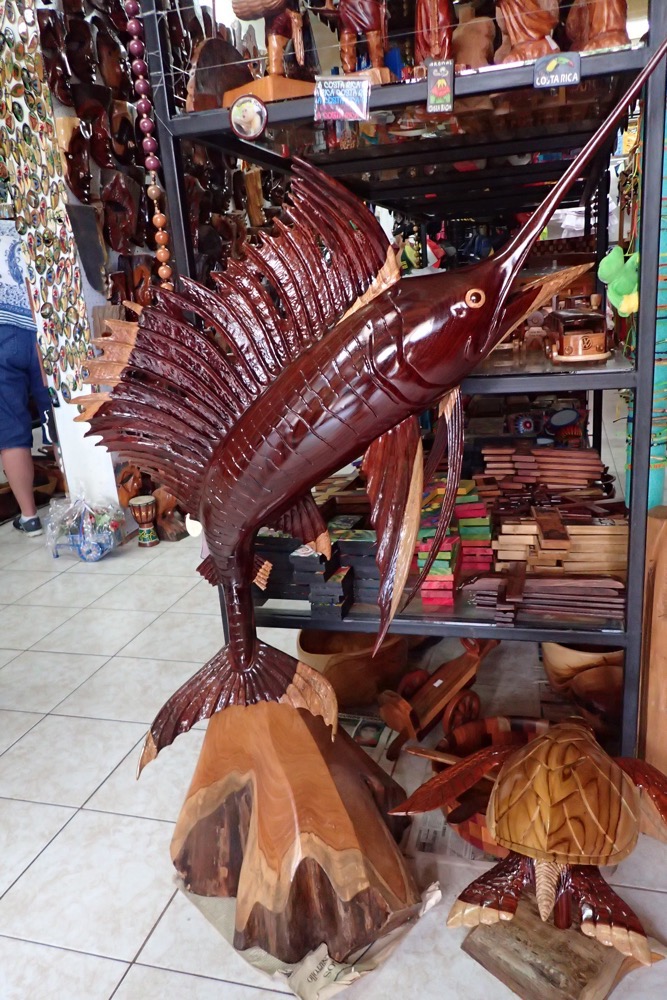
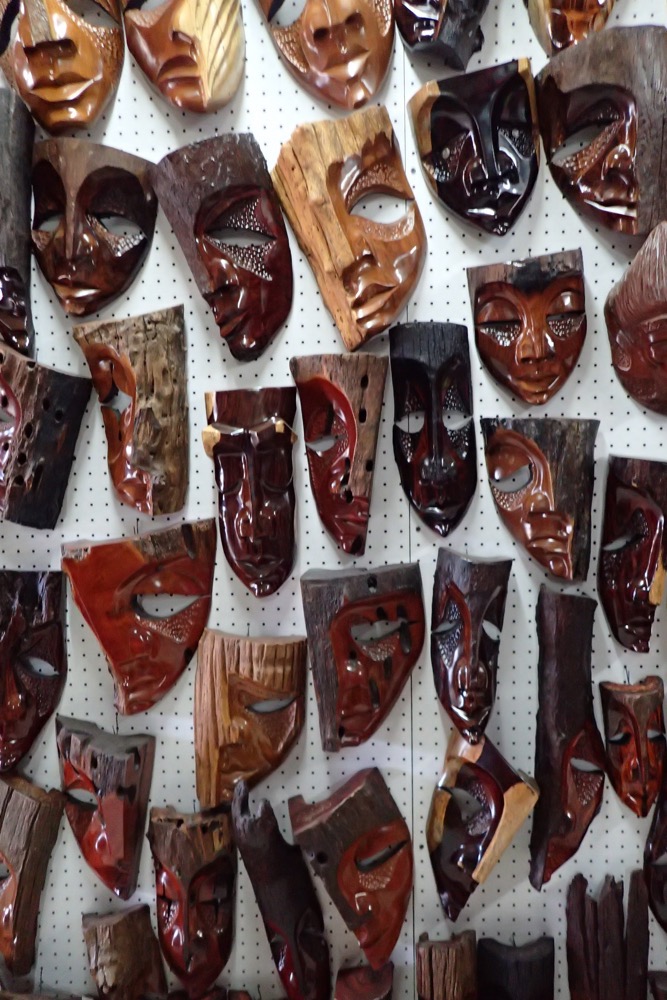 On the way back to the ship, we made another stop to see even more crocodiles at a bridge that has shallow flowing water where the crocodiles like to hang out to stay warm and to catch small fishes in the steam. I counted 25 of these monsters and they were all 4-5m long. It was like the sort of bridge the villains would hang James Bond from and then turn their backs of him and wait for the crocs to get him. We have plenty of big crocs in Australia, but I’ve never seen so many of the large prehistoric beasties in one spot like this.
On the way back to the ship, we made another stop to see even more crocodiles at a bridge that has shallow flowing water where the crocodiles like to hang out to stay warm and to catch small fishes in the steam. I counted 25 of these monsters and they were all 4-5m long. It was like the sort of bridge the villains would hang James Bond from and then turn their backs of him and wait for the crocs to get him. We have plenty of big crocs in Australia, but I’ve never seen so many of the large prehistoric beasties in one spot like this.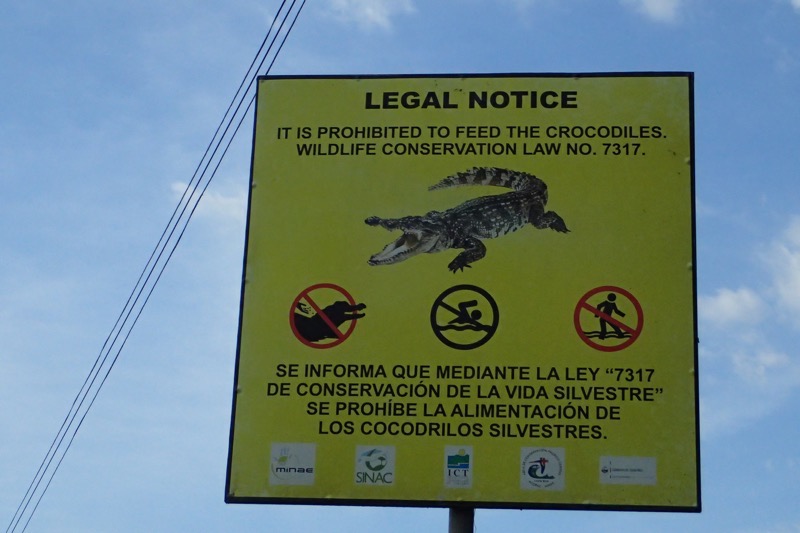
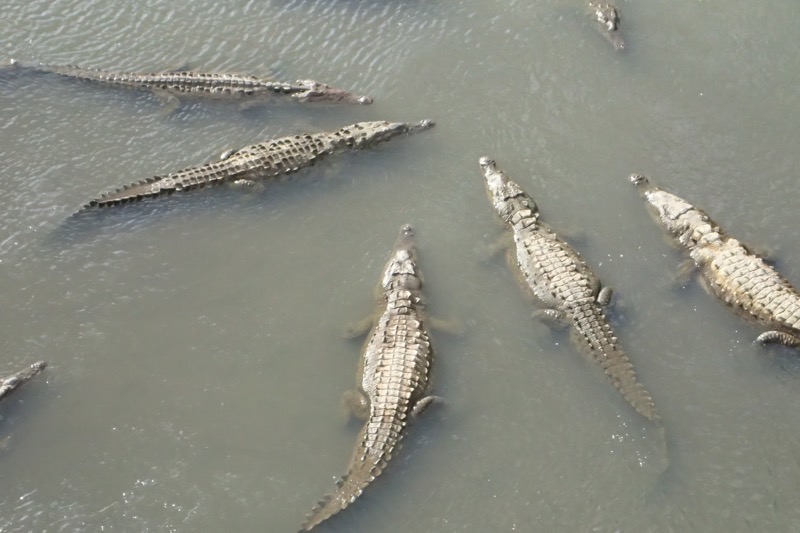
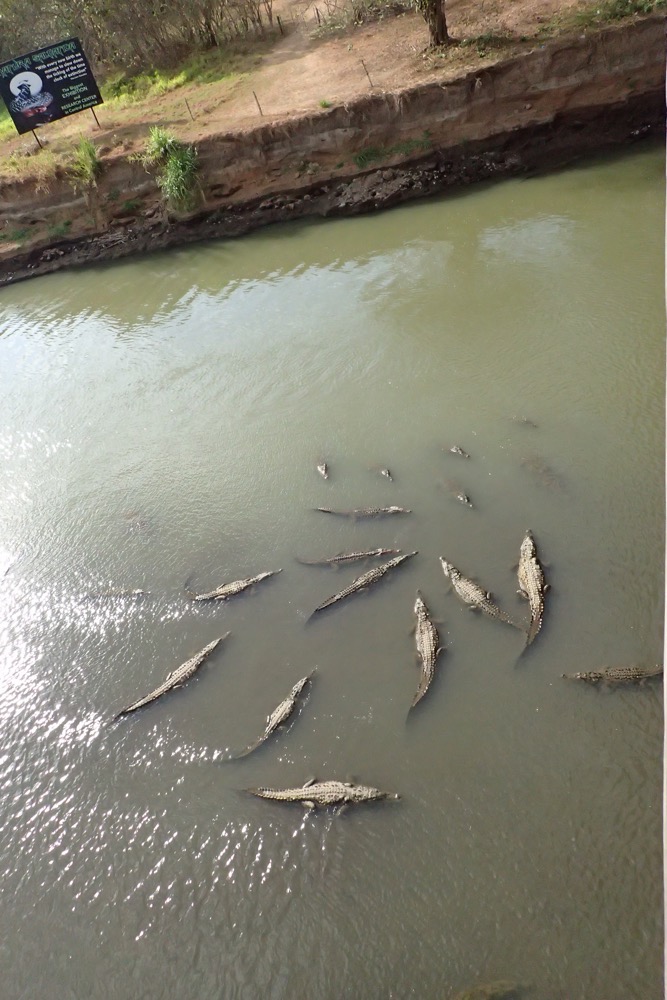
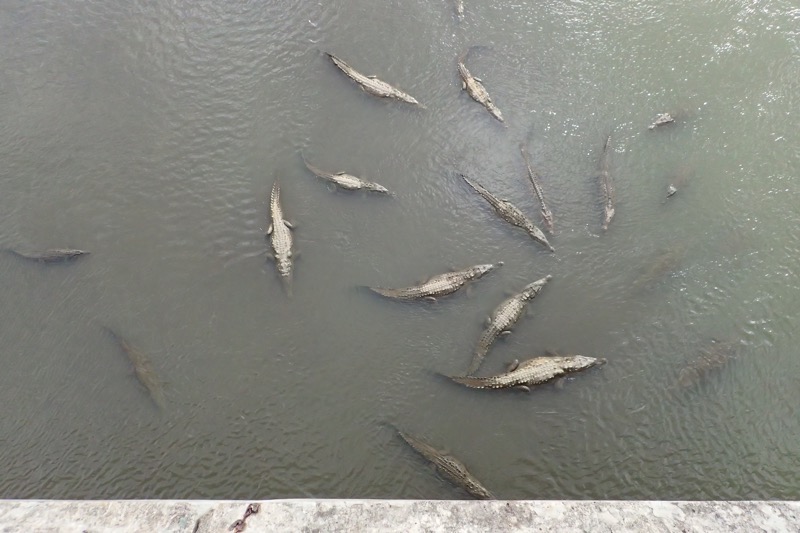
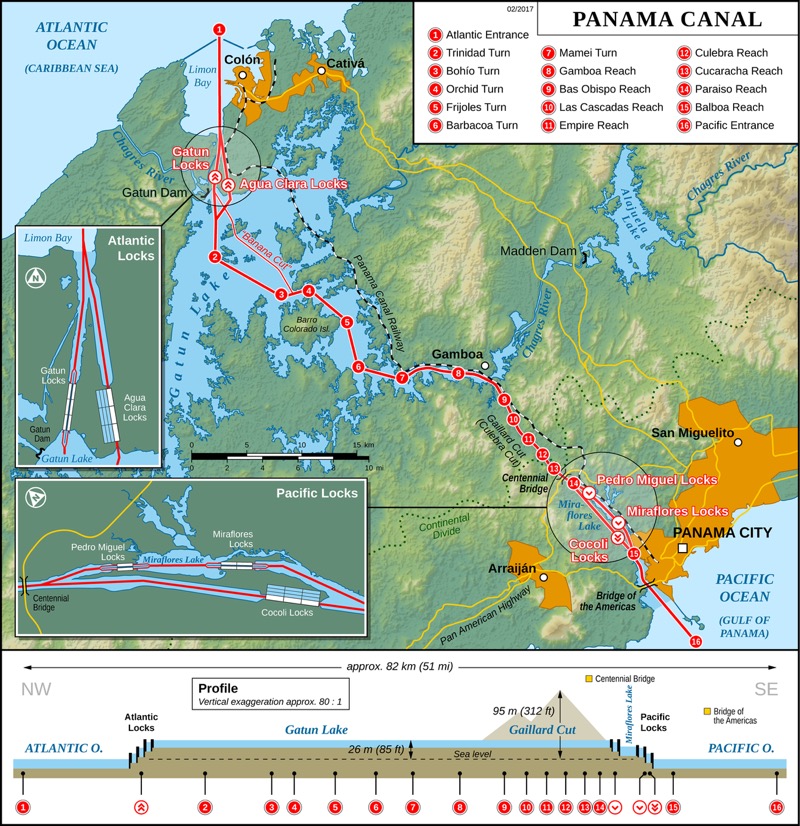 The Panama Canal is a 77 km, manmade, waterway that cuts through the country of Panama connecting the Atlantic Ocean to the Pacific Ocean. The canal is a major international maritime trade route… and on every cruisers check list. We were up early to get a good look at the entry area near the town of Christobel.
The Panama Canal is a 77 km, manmade, waterway that cuts through the country of Panama connecting the Atlantic Ocean to the Pacific Ocean. The canal is a major international maritime trade route… and on every cruisers check list. We were up early to get a good look at the entry area near the town of Christobel.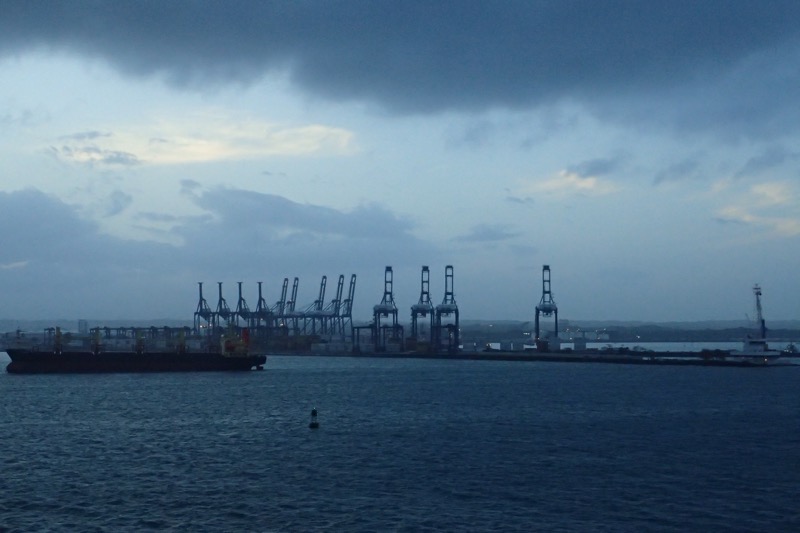 At either end of the canal are major port operations allowing for the offloading of containers to be moved by rail instead of through the lock system. The locks assist ships in being elevated 26 metres above sea level to a large manmade lake, Gatun Lake, and again a second set of locks allow the ships to be moved back down to sea level on the Panama City side. The entire system was devised to allow ships to avoid the hazardous and time consuming Cape Horn route in the southernmost tip of South America via the Straits of Magellan or the Drake Passage – where we were just a few short weeks ago.
At either end of the canal are major port operations allowing for the offloading of containers to be moved by rail instead of through the lock system. The locks assist ships in being elevated 26 metres above sea level to a large manmade lake, Gatun Lake, and again a second set of locks allow the ships to be moved back down to sea level on the Panama City side. The entire system was devised to allow ships to avoid the hazardous and time consuming Cape Horn route in the southernmost tip of South America via the Straits of Magellan or the Drake Passage – where we were just a few short weeks ago.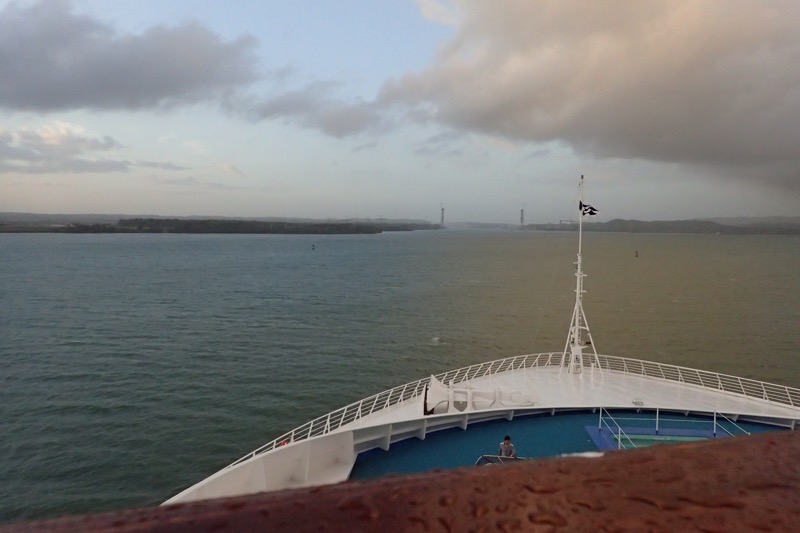 A larger, wider canal was finished in 2016 and it allows for Post-Panamax ships to move through which are capable of carrying more cargo.
A larger, wider canal was finished in 2016 and it allows for Post-Panamax ships to move through which are capable of carrying more cargo.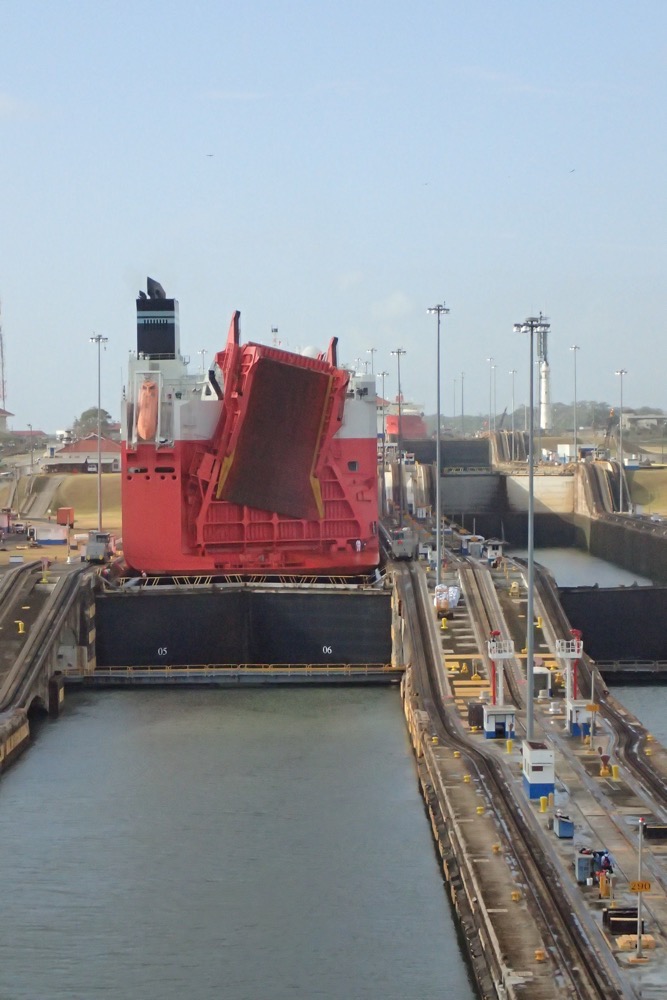 When looking at all these photos of the canal – it is most interesting to note the differing water levels of each lock, that allow the ships to move north and south through the system. The canal was officially opened in 1914 and initially saw about 1,000 ships per year utilising the canal. Most recent numbers see approximately 15,000 ships pass through the canal each year, and a total of 815,000 vessels had used it by 2012.
When looking at all these photos of the canal – it is most interesting to note the differing water levels of each lock, that allow the ships to move north and south through the system. The canal was officially opened in 1914 and initially saw about 1,000 ships per year utilising the canal. Most recent numbers see approximately 15,000 ships pass through the canal each year, and a total of 815,000 vessels had used it by 2012.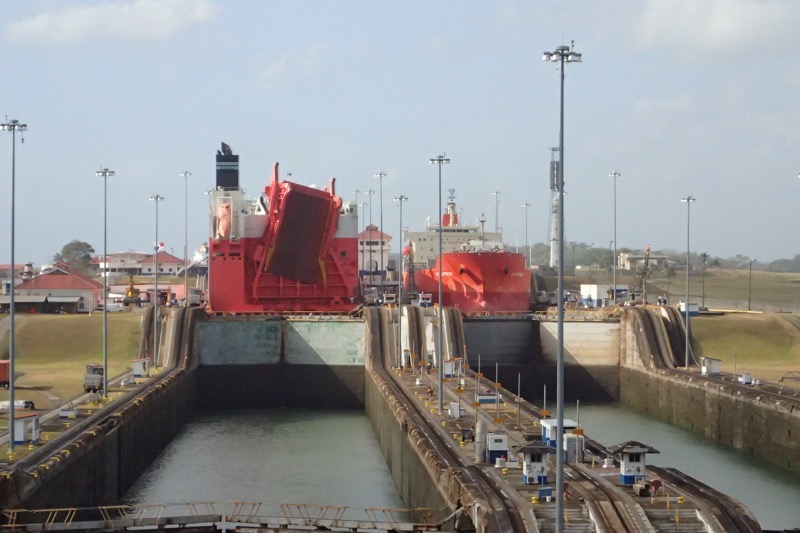 We were spoon fed a lot of history about the canal across the Panama Isthmus today by our destination expert, Hutch, and while I find this stuff quite interesting – feel free to zone out about now. The first proposals of a canal across Panama date back to 1534 when Charles V of Spain conducted a survey looking for a route that would make the voyage for ships travelling Spain to Peru, shorter and easier thereby giving Spain a significant military advantage over the Portuguese.
We were spoon fed a lot of history about the canal across the Panama Isthmus today by our destination expert, Hutch, and while I find this stuff quite interesting – feel free to zone out about now. The first proposals of a canal across Panama date back to 1534 when Charles V of Spain conducted a survey looking for a route that would make the voyage for ships travelling Spain to Peru, shorter and easier thereby giving Spain a significant military advantage over the Portuguese.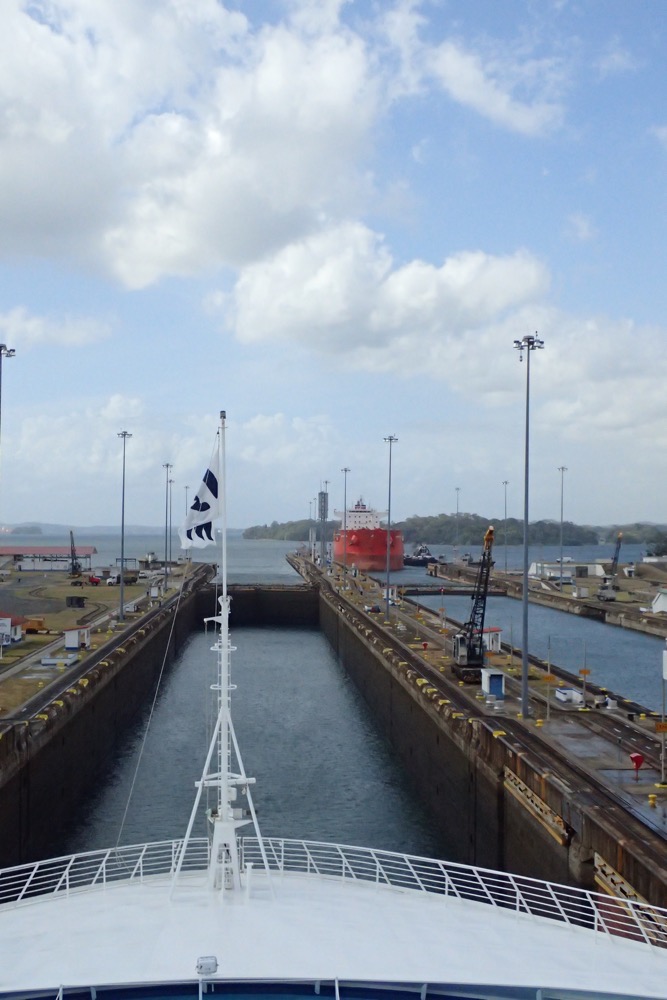 Going through the locks now – you can see what an enormous undertaking it was. It is easily as impressive as seeing the Hoover Dam or the Great Wall of China. The Gatun locks:
Going through the locks now – you can see what an enormous undertaking it was. It is easily as impressive as seeing the Hoover Dam or the Great Wall of China. The Gatun locks: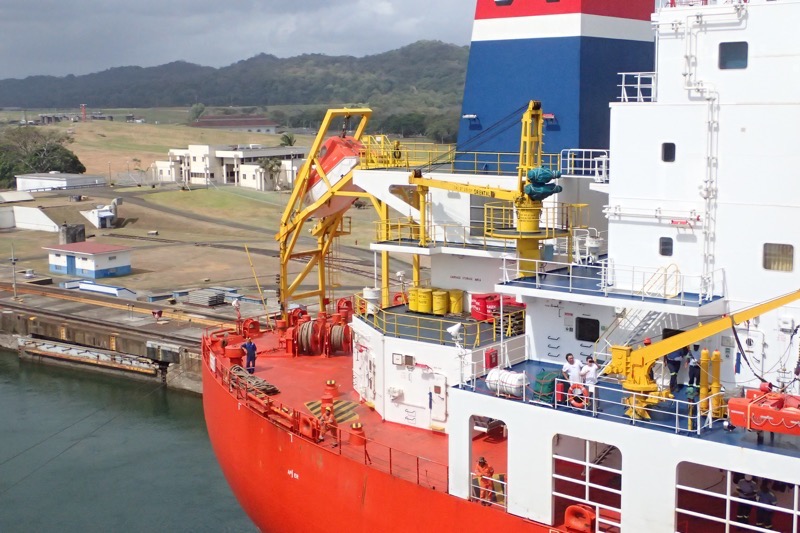
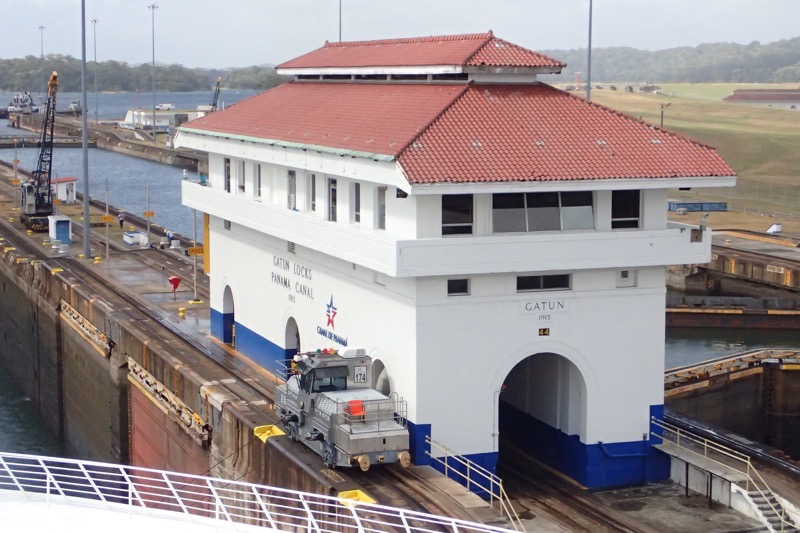
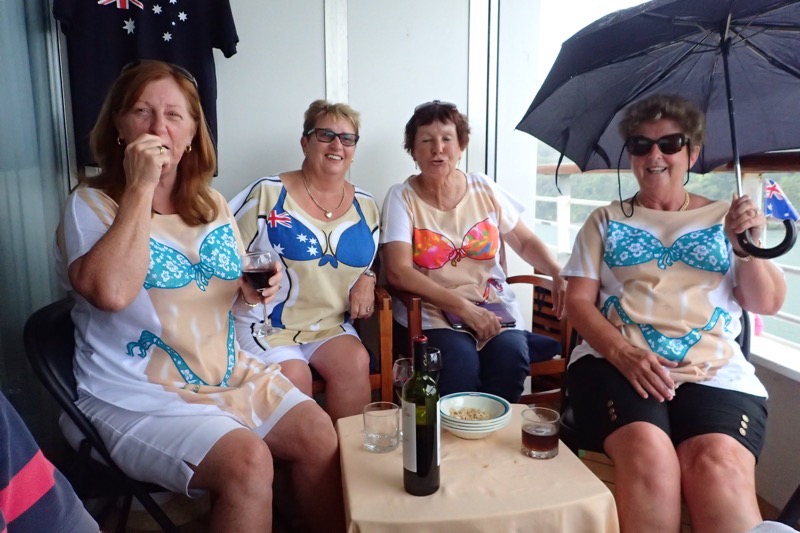 Marie, Sandra, Kathleen, and Sandy all dressed up for ‘flashing’ onlookers and the local tug boat captains! 🙂
Marie, Sandra, Kathleen, and Sandy all dressed up for ‘flashing’ onlookers and the local tug boat captains! 🙂 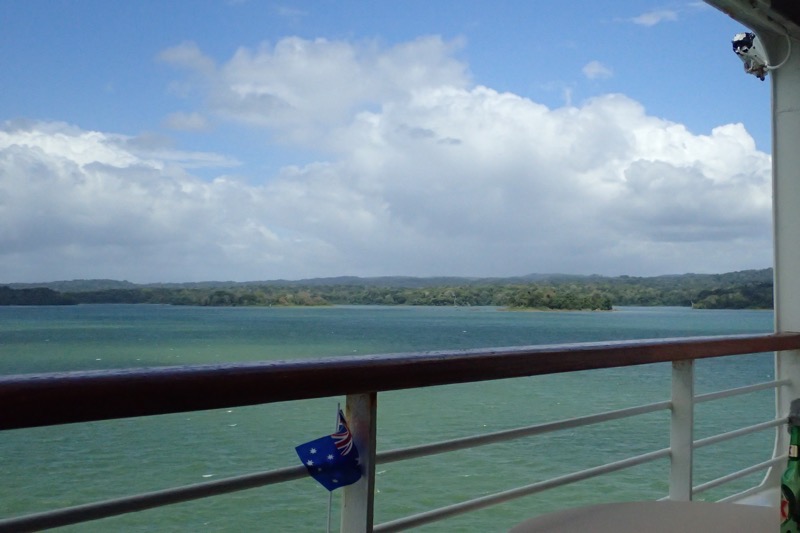 Views of the Gatun Lake…
Views of the Gatun Lake…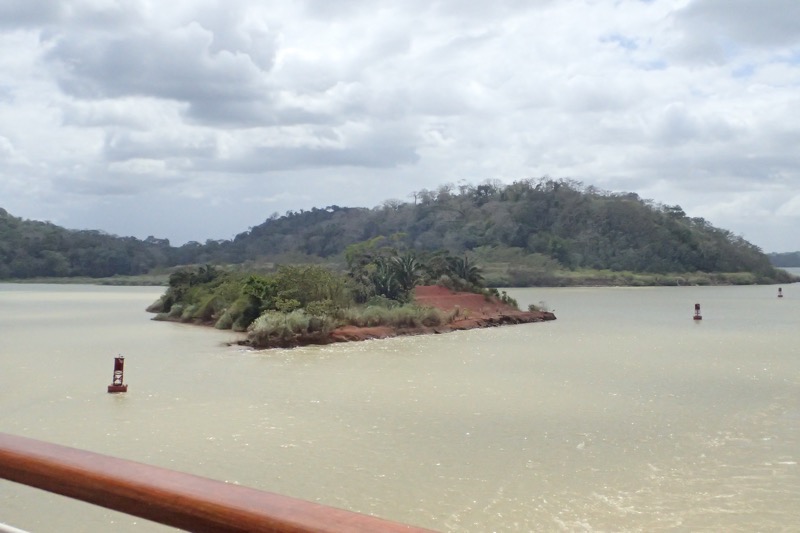
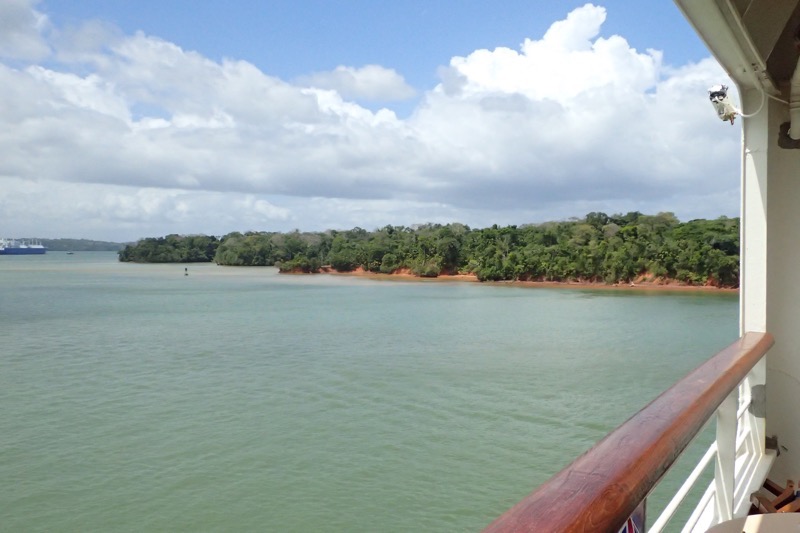 Lunchtime with the Nookies; Terry, Barry, John and Mick (aka Mick The Official, and Original, Bad Influence!)
Lunchtime with the Nookies; Terry, Barry, John and Mick (aka Mick The Official, and Original, Bad Influence!)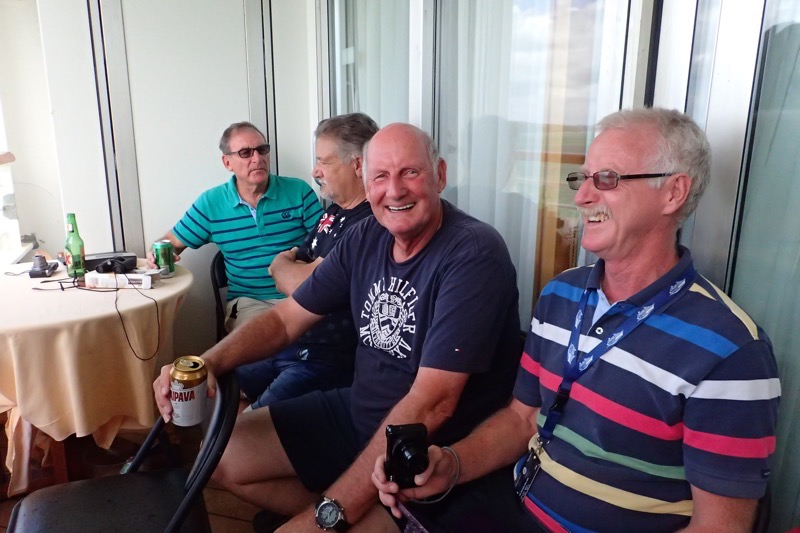 The Girls taunting the local tug boat captains with their ‘girls’. 😉
The Girls taunting the local tug boat captains with their ‘girls’. 😉 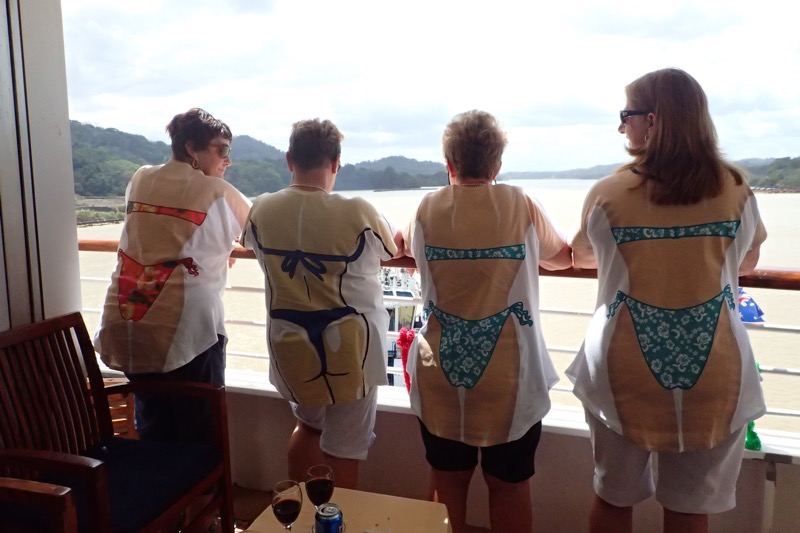
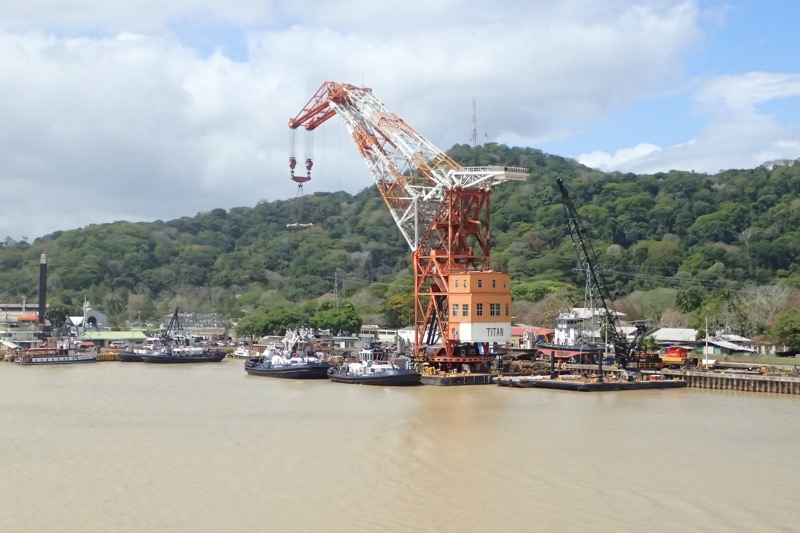 One of the tugboats who was following us for quite some time was doing donuts in the water for our amusement and talking to us over their PA system… when we held out beers for them, they said “We wish.” and “Now, you’re just being mean!” as we were partying on the deck and they were stuck working… poor fellas. I think they followed us for an hour hoping someone was going to flash their bits! 🙂
One of the tugboats who was following us for quite some time was doing donuts in the water for our amusement and talking to us over their PA system… when we held out beers for them, they said “We wish.” and “Now, you’re just being mean!” as we were partying on the deck and they were stuck working… poor fellas. I think they followed us for an hour hoping someone was going to flash their bits! 🙂 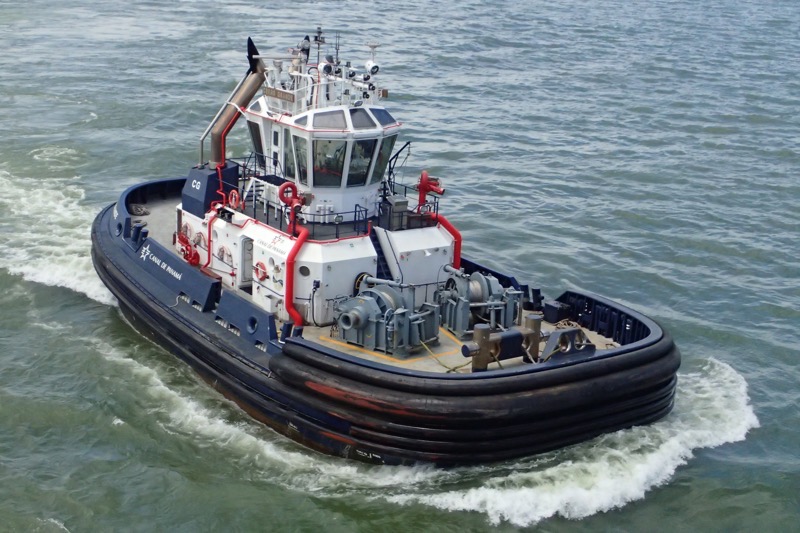
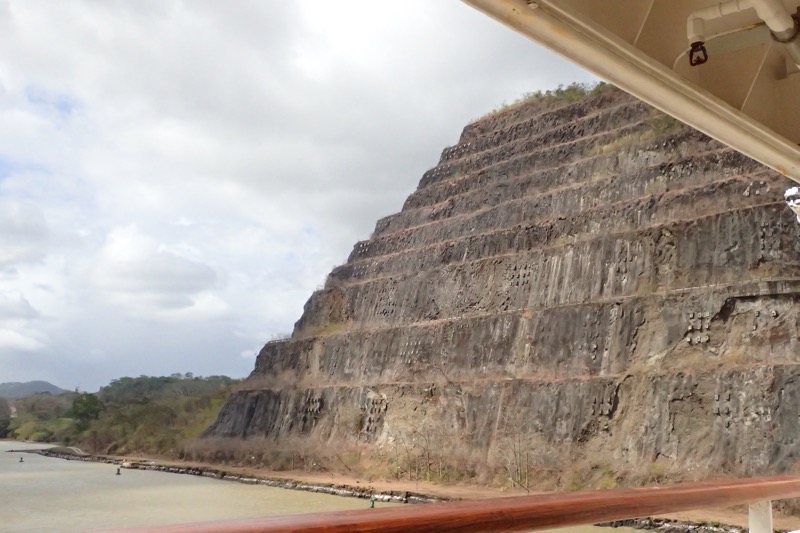
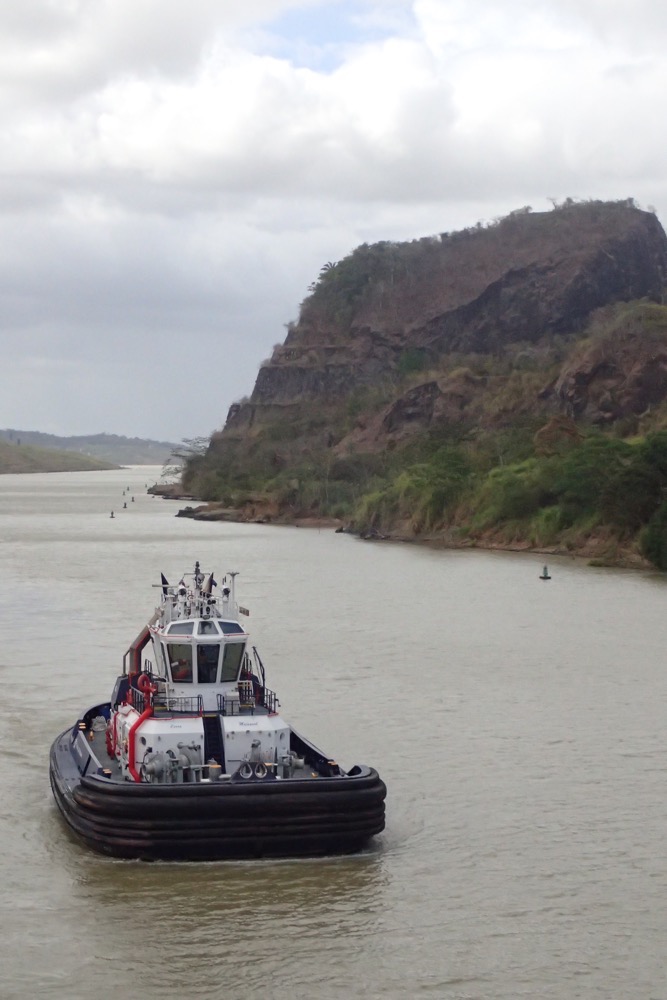 The Centennial Bridge
The Centennial Bridge 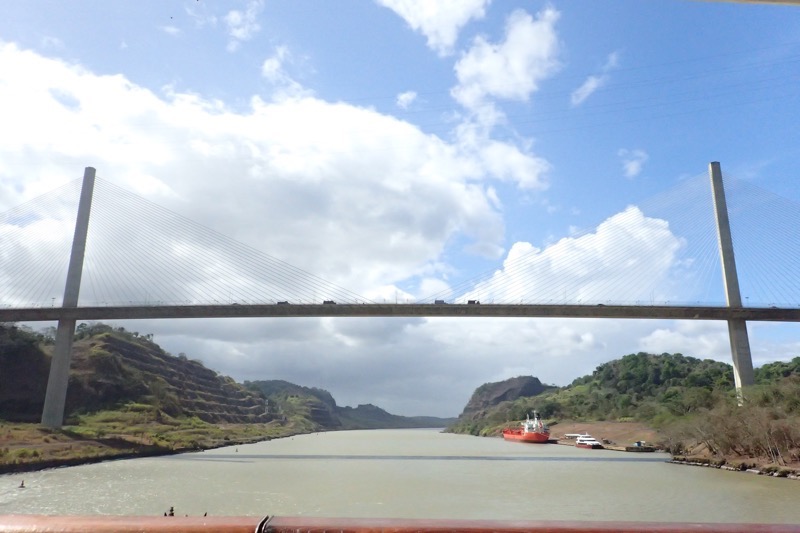
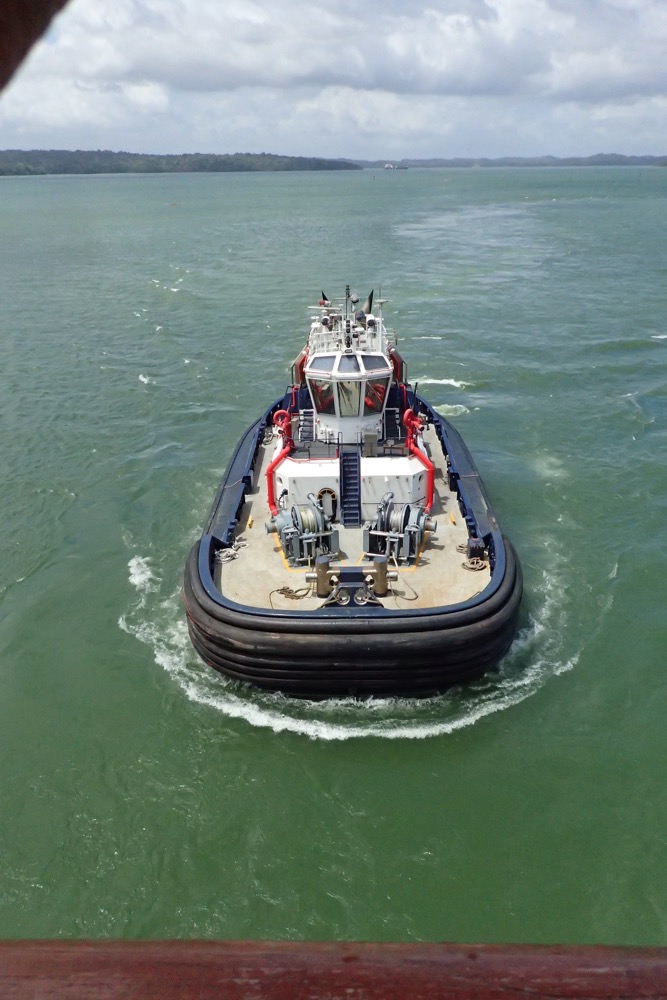 Out the other side of Gamboa we found ourselves going through the Pedro Miguel Locks and then the Mira Flores Locks. I was back on the front of the ship on the deck 11 view deck to see this – you can really see the water levels moving up and down to move these enormous ships – our cruise ship and the car carrier that we had been moving neck and neck with all day.
Out the other side of Gamboa we found ourselves going through the Pedro Miguel Locks and then the Mira Flores Locks. I was back on the front of the ship on the deck 11 view deck to see this – you can really see the water levels moving up and down to move these enormous ships – our cruise ship and the car carrier that we had been moving neck and neck with all day. 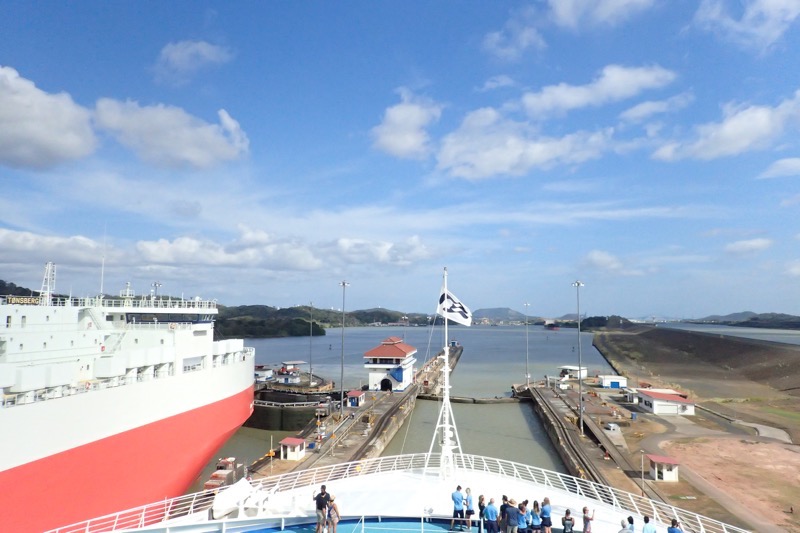
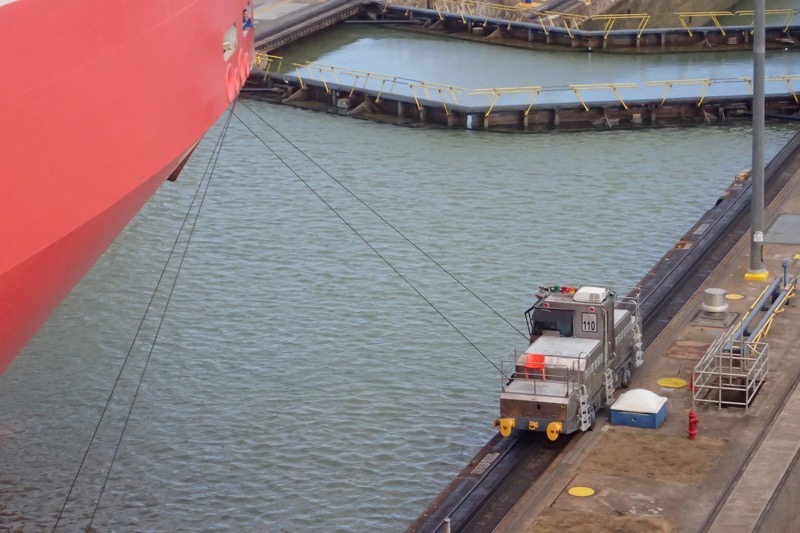 The other interesting thing we learned today was the cost of using the Canal. The tolls are set by the Panama Canal Authority and are based on the type of ship and what type of cargo it may be carrying. For examples, container cargo ships are assessed on a unit of measurement called a ‘twenty-foot equivalent unit’ TEU, which is roughly the size of a regular shipping container. From last year, the toll was about USD$90 per TEU… which doesn’t sound too much until you consider the average Panamax container ship can take over 4000 TEU. Passenger cruise ships are calculated differently – a cruise ship of over 30,000 tonnes is charged based on the number of berths on the ship/the number of passengers that can fit on the ship, not necessarily the number of passengers that are on the ship. The cost per berth as of 2016 is $111 for unoccupied berths (why?) and $138 for occupied berths. Other ships are calculated based on the amount of cubic meters of water they displace which is sounding too much by math for me.
The other interesting thing we learned today was the cost of using the Canal. The tolls are set by the Panama Canal Authority and are based on the type of ship and what type of cargo it may be carrying. For examples, container cargo ships are assessed on a unit of measurement called a ‘twenty-foot equivalent unit’ TEU, which is roughly the size of a regular shipping container. From last year, the toll was about USD$90 per TEU… which doesn’t sound too much until you consider the average Panamax container ship can take over 4000 TEU. Passenger cruise ships are calculated differently – a cruise ship of over 30,000 tonnes is charged based on the number of berths on the ship/the number of passengers that can fit on the ship, not necessarily the number of passengers that are on the ship. The cost per berth as of 2016 is $111 for unoccupied berths (why?) and $138 for occupied berths. Other ships are calculated based on the amount of cubic meters of water they displace which is sounding too much by math for me.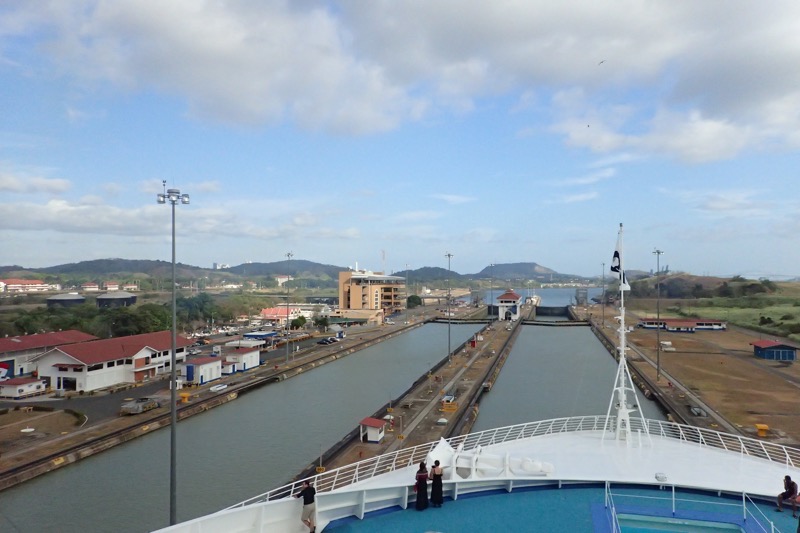 The most expensive toll ever paid was by a cruise ship called the Norwegian Pearl which paid over USD$375,000 for an expedited passage – the average cost is about $54,000 for a ship of that size, but they basically paid to jump the queue. There was another ship when work was being carried out on the Gatun Locks, an tanker I think, that once paid about $250,000 to avoid waiting in a 90 ship queue (7 days wait) on what should have been a $13,500 toll.
The most expensive toll ever paid was by a cruise ship called the Norwegian Pearl which paid over USD$375,000 for an expedited passage – the average cost is about $54,000 for a ship of that size, but they basically paid to jump the queue. There was another ship when work was being carried out on the Gatun Locks, an tanker I think, that once paid about $250,000 to avoid waiting in a 90 ship queue (7 days wait) on what should have been a $13,500 toll.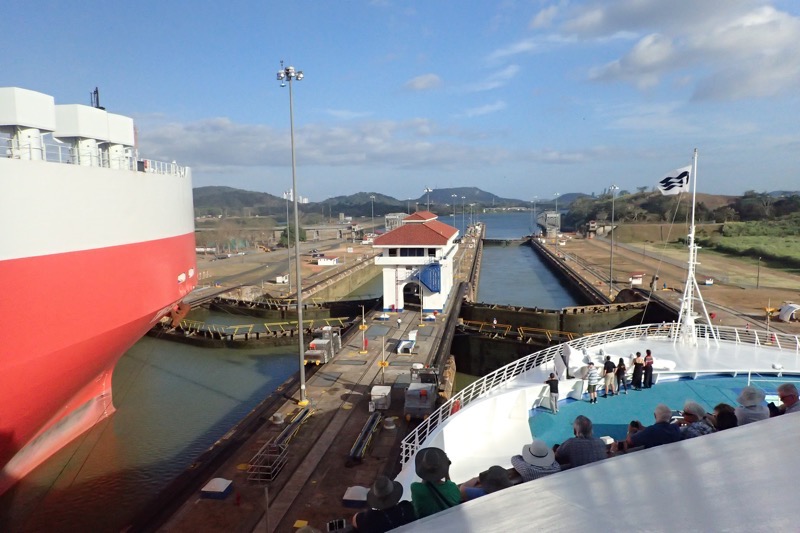 In the image below, you can see the water racing through a culvert… this is how the lock system works – by using gravity to move metric shit tonnes of water to allow each ship to raise and lower as required.
In the image below, you can see the water racing through a culvert… this is how the lock system works – by using gravity to move metric shit tonnes of water to allow each ship to raise and lower as required.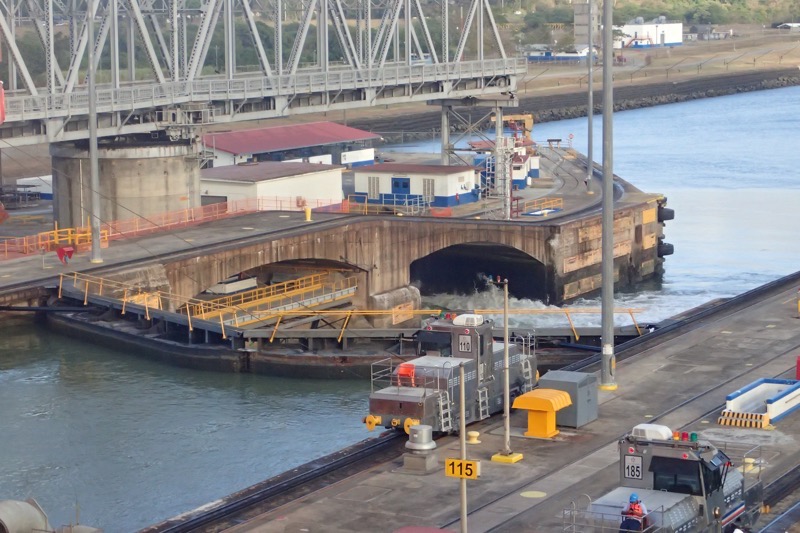
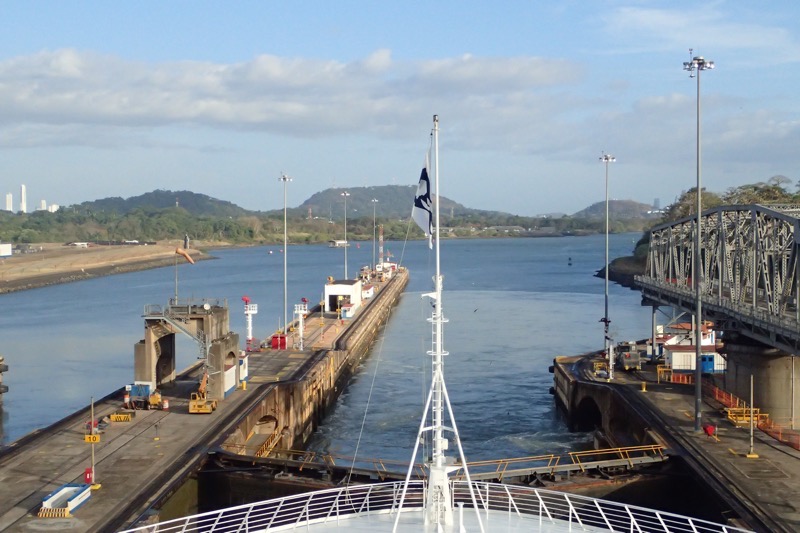
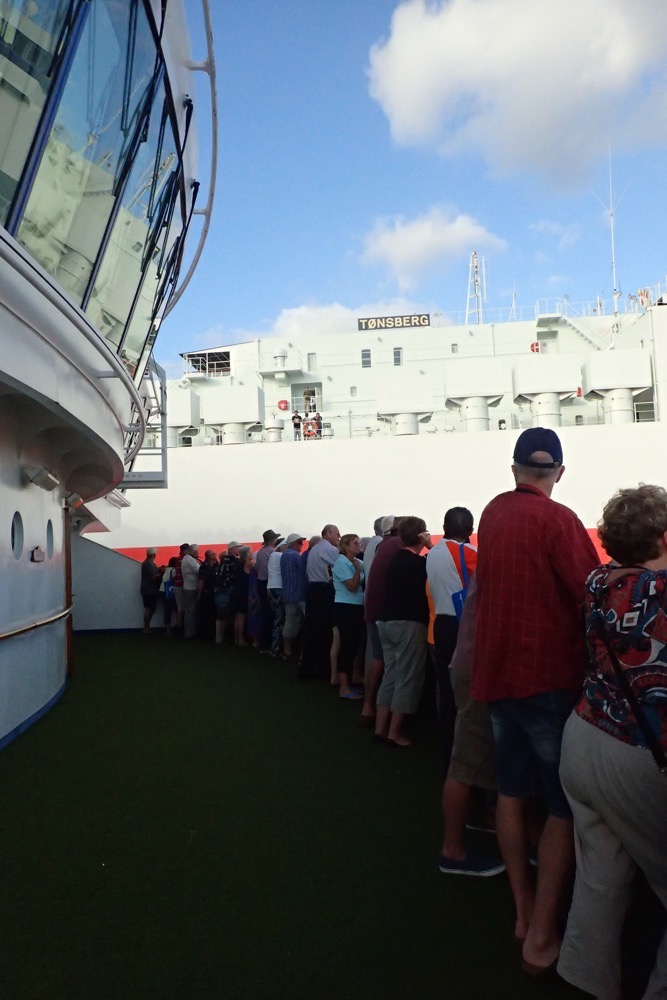
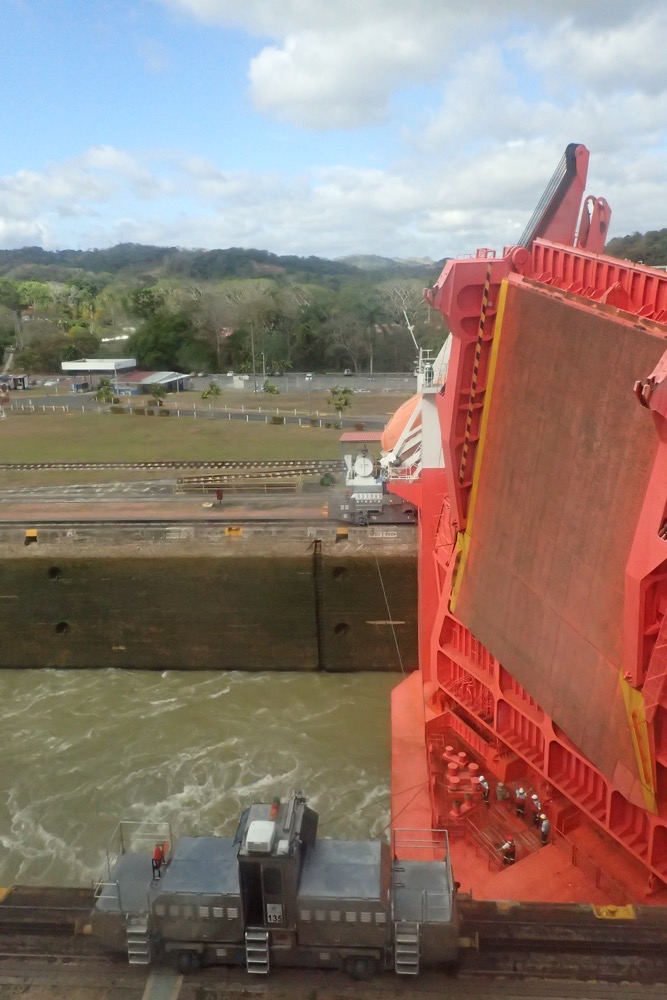 Currently, the canal is handling far more traffic than had ever been projected by the original engineers – it was estimated that it would move about 80 million tonnes of cargo each year, but in 2015, over 340 million tonnes was moved through the canal… I gotta ask myself, how much of the stuff on these container ships is full of shit made in China destined for $2 stores the world over? Are we overdoing this moving crap around the world thing? Something to think about…
Currently, the canal is handling far more traffic than had ever been projected by the original engineers – it was estimated that it would move about 80 million tonnes of cargo each year, but in 2015, over 340 million tonnes was moved through the canal… I gotta ask myself, how much of the stuff on these container ships is full of shit made in China destined for $2 stores the world over? Are we overdoing this moving crap around the world thing? Something to think about…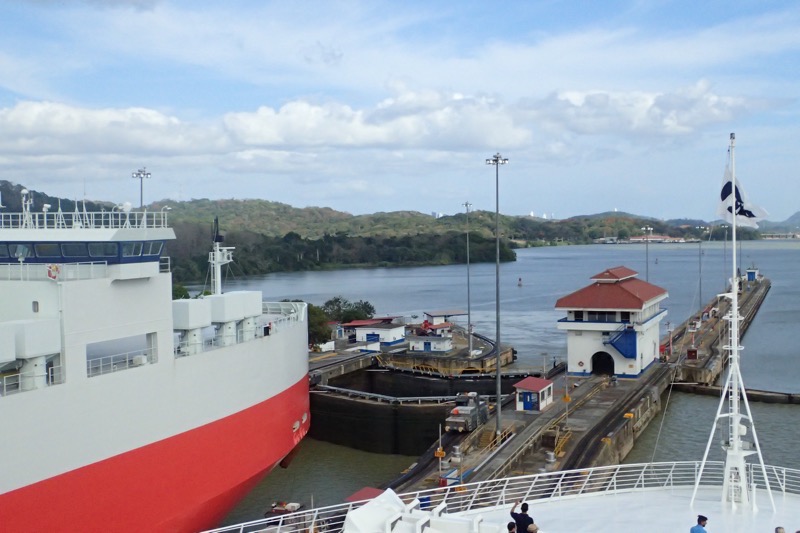 The rolling bumpers that allow the ship to move through the canal without damage – with barely a 1 foot clearance these rollers keep the ship from rubbing along the canal’s concrete edges.
The rolling bumpers that allow the ship to move through the canal without damage – with barely a 1 foot clearance these rollers keep the ship from rubbing along the canal’s concrete edges.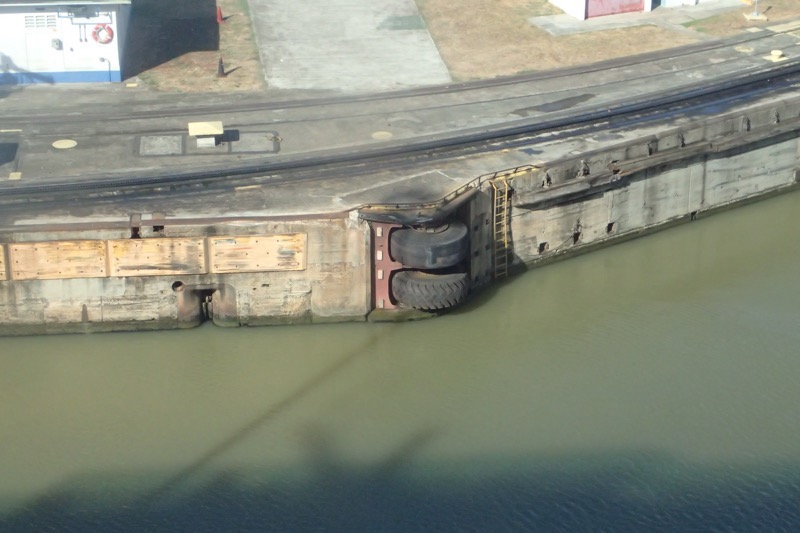 In the old days, mules were used to pull ships through the canal – today ‘mules’ are still used to pull the ships through and help keep their sideways movement controlled. Only now they are 50 tonne machines made by (originally General Electric) and Mitsubishi now. Six of these are attached to the ship for the transit, and believe it or not the cables are sent out to the ship at the beginning of any transit by two little guys in a row boat who then pass them to a crew member on the ship who has gone out a watertight door and down a rope ladder to ‘catch’ it! Many different methods of throwing and/or shooting the cables to the ship have been tried in the past, but the little guys in the row boats have proved most effective over time.
In the old days, mules were used to pull ships through the canal – today ‘mules’ are still used to pull the ships through and help keep their sideways movement controlled. Only now they are 50 tonne machines made by (originally General Electric) and Mitsubishi now. Six of these are attached to the ship for the transit, and believe it or not the cables are sent out to the ship at the beginning of any transit by two little guys in a row boat who then pass them to a crew member on the ship who has gone out a watertight door and down a rope ladder to ‘catch’ it! Many different methods of throwing and/or shooting the cables to the ship have been tried in the past, but the little guys in the row boats have proved most effective over time.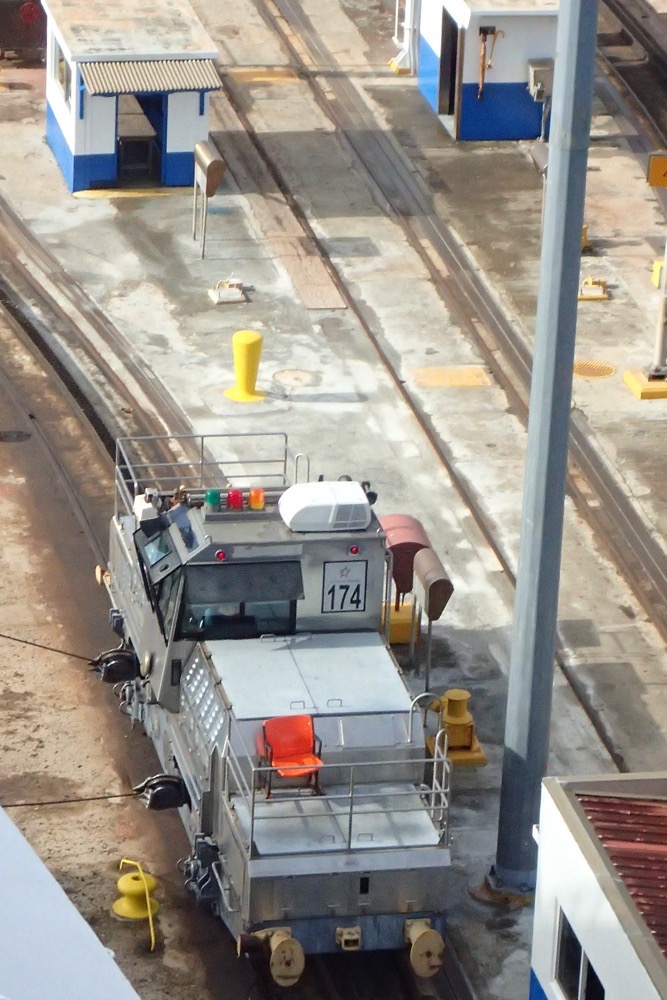 Mules…
Mules…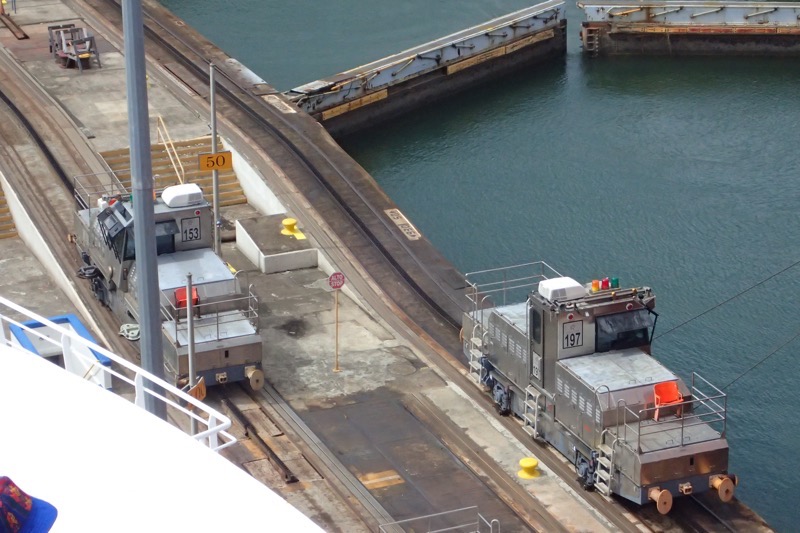 Heading out the other side you can see the large port infrastructure at the other end of the Panama Railway… large cranes dot the skyline to unload/reload ships that are not traversing through the canal.
Heading out the other side you can see the large port infrastructure at the other end of the Panama Railway… large cranes dot the skyline to unload/reload ships that are not traversing through the canal.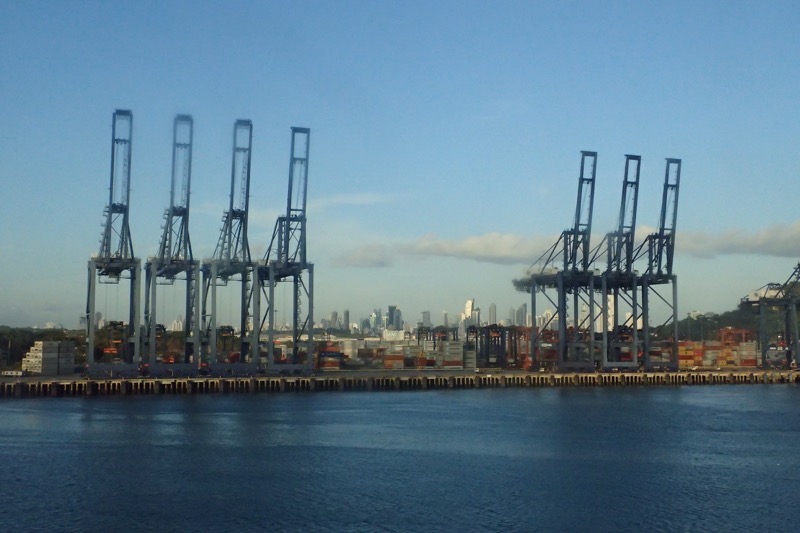 Elaine and Anyse enjoying the view from the Deck 10 forward viewing deck.
Elaine and Anyse enjoying the view from the Deck 10 forward viewing deck.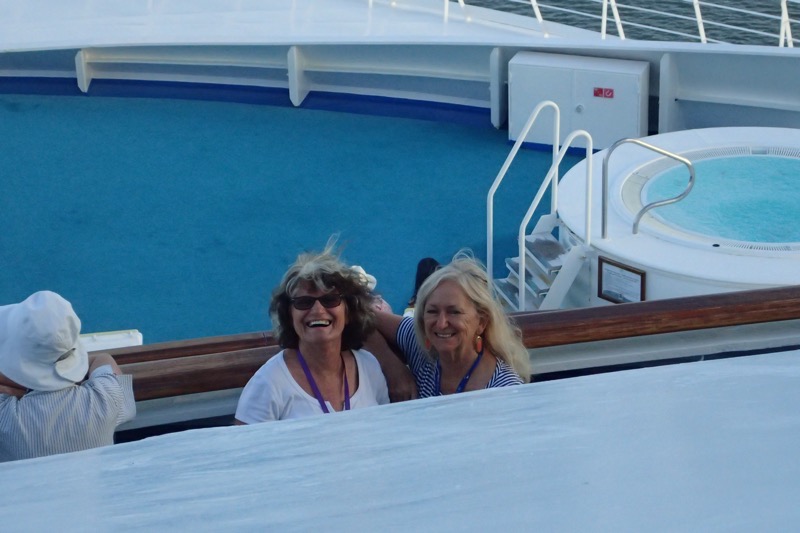 And then, before you know it… ta-da! We are back in the Pacific Ocean, and well, you know – we could swim home from here, right? 😉
And then, before you know it… ta-da! We are back in the Pacific Ocean, and well, you know – we could swim home from here, right? 😉 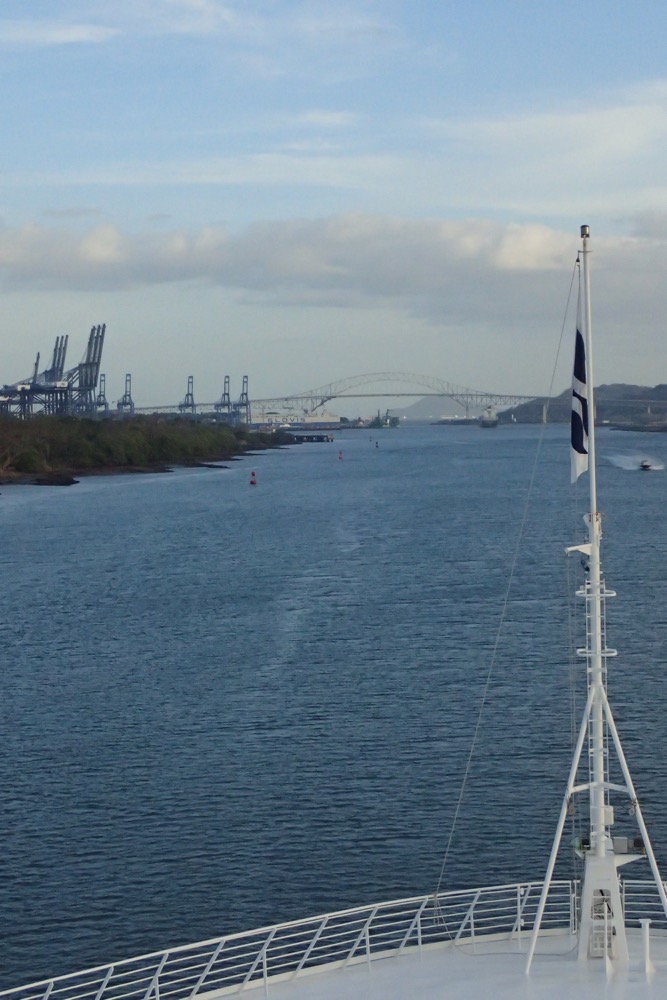
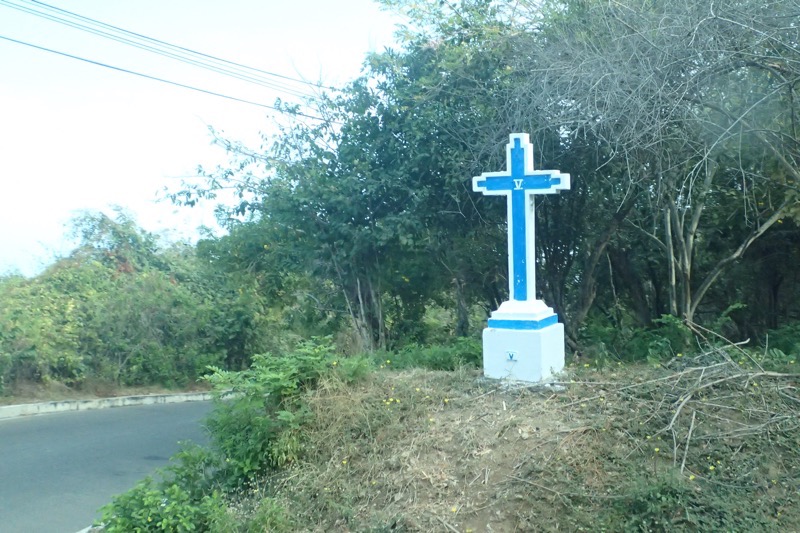 Our first stop in Cartagena today was up the mountain that overlooks the city, to La Popa Monastery. The monastery was built in the 17th century and it continues to houses a community of Augustinian monks today. On the way up the mountain were markers for the traditional Catholic Stations of the Cross, however there are 14 of them, and from my heavily indoctrinated Catholic school recollections there was only ever 12… Mercedes was unable to explain away the extra stations, so I guess that one will remain a mystery.
Our first stop in Cartagena today was up the mountain that overlooks the city, to La Popa Monastery. The monastery was built in the 17th century and it continues to houses a community of Augustinian monks today. On the way up the mountain were markers for the traditional Catholic Stations of the Cross, however there are 14 of them, and from my heavily indoctrinated Catholic school recollections there was only ever 12… Mercedes was unable to explain away the extra stations, so I guess that one will remain a mystery.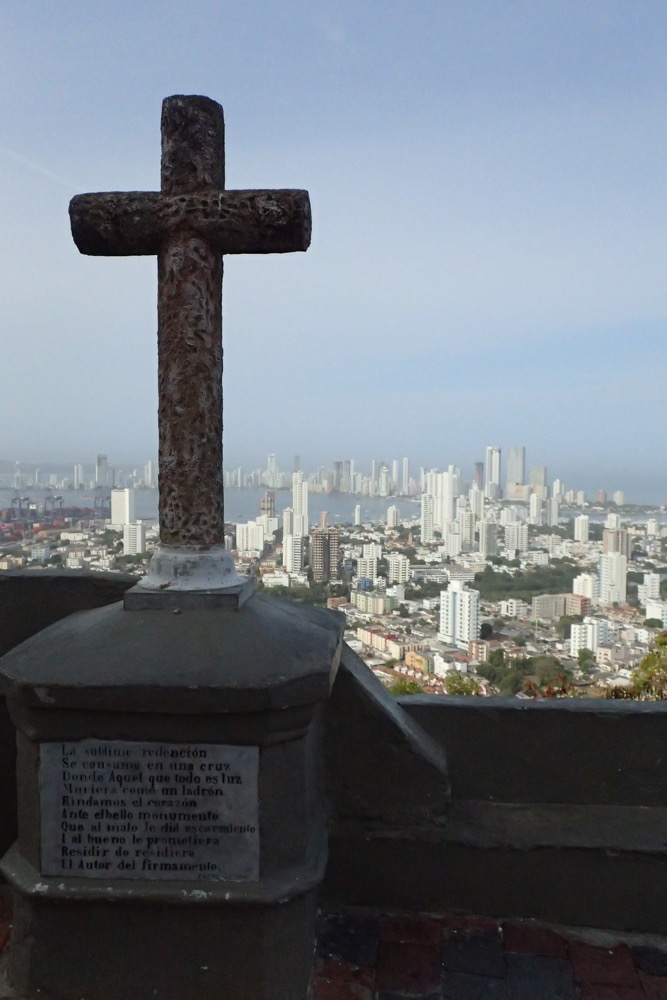 The view over Cartagena.
The view over Cartagena.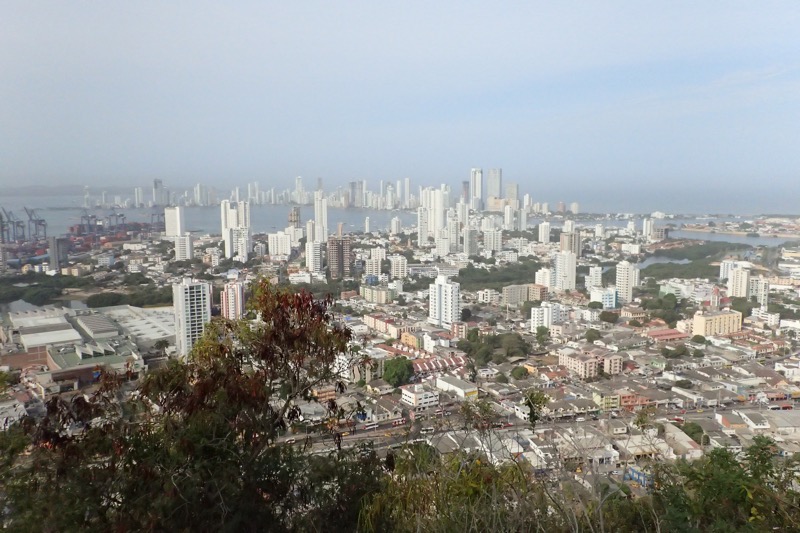 Steps up to La Popa.
Steps up to La Popa.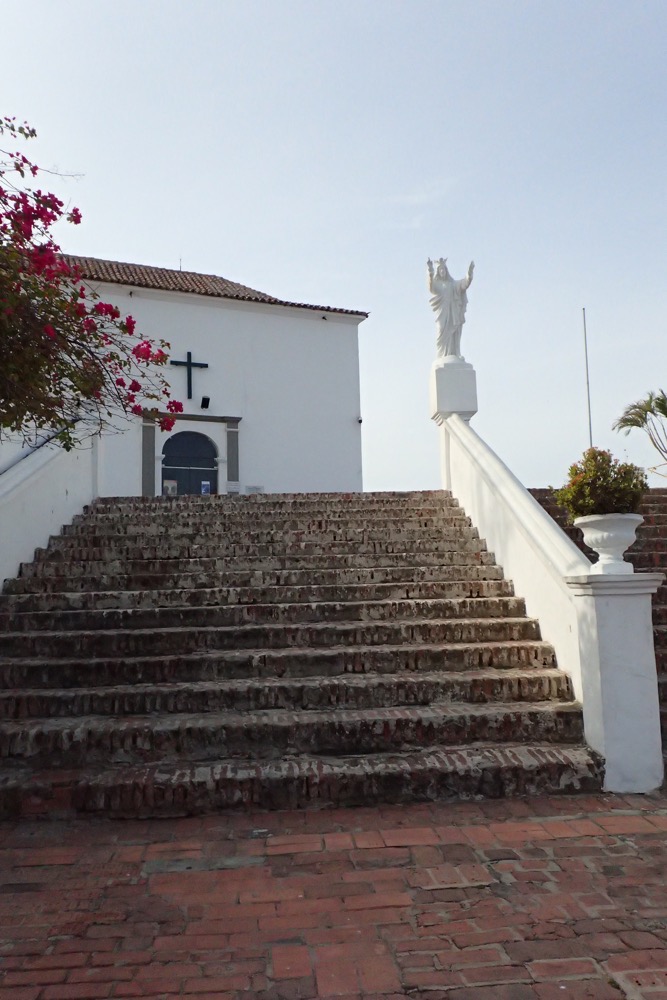
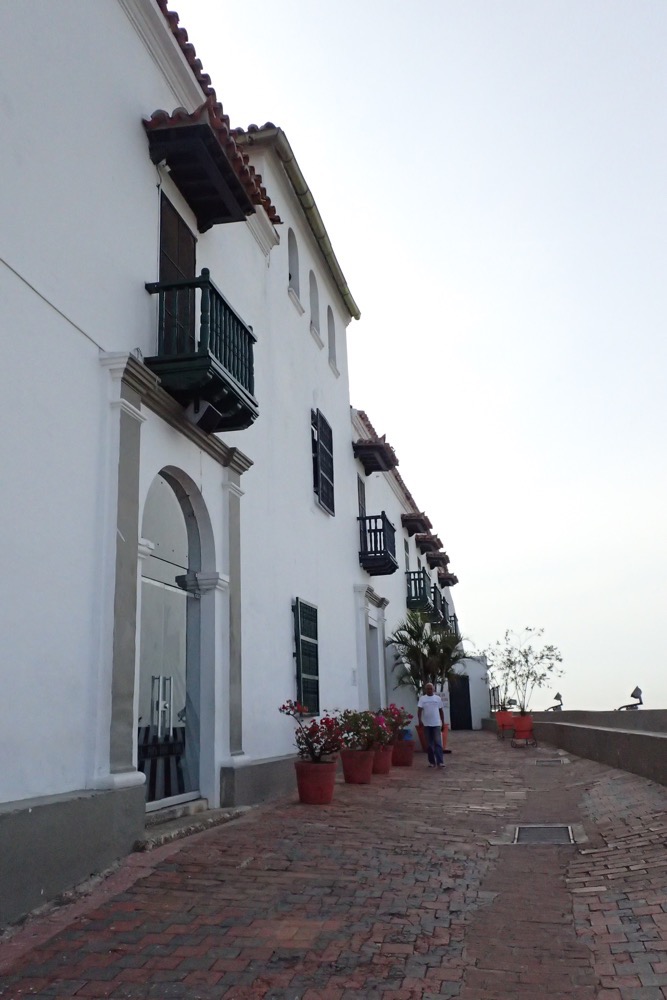
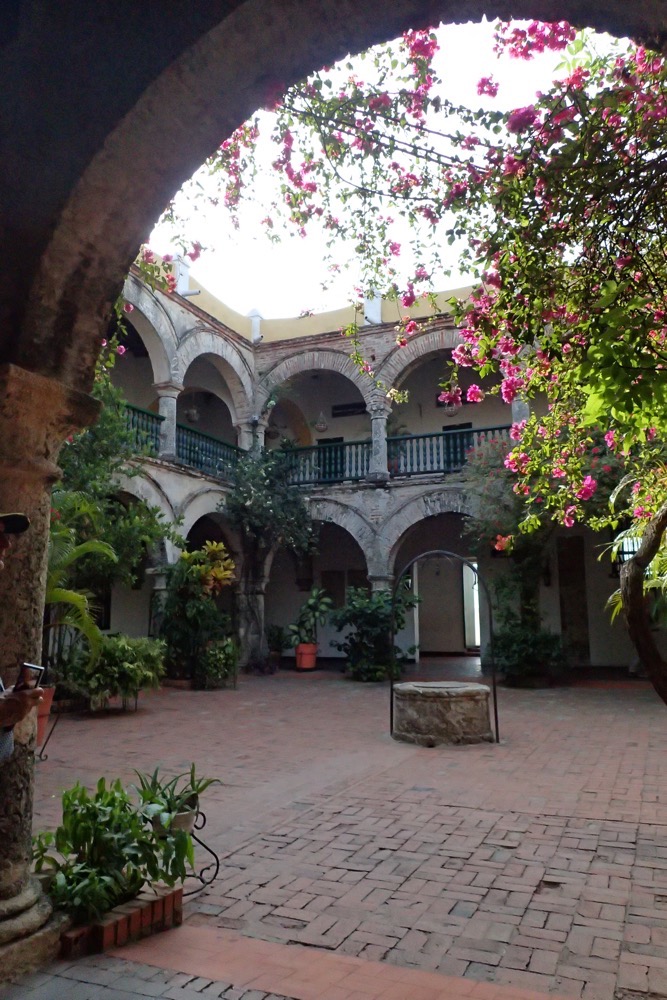 This lovely cloistered courtyard has been cleverly designed to capture rainwater and funnel it to an enormous underground water cistern… the pillars of the courtyard are hollow, and water flows down through the pillars into the cistern for later use, as the subterranean water here is too salty to use for traditional wells.
This lovely cloistered courtyard has been cleverly designed to capture rainwater and funnel it to an enormous underground water cistern… the pillars of the courtyard are hollow, and water flows down through the pillars into the cistern for later use, as the subterranean water here is too salty to use for traditional wells.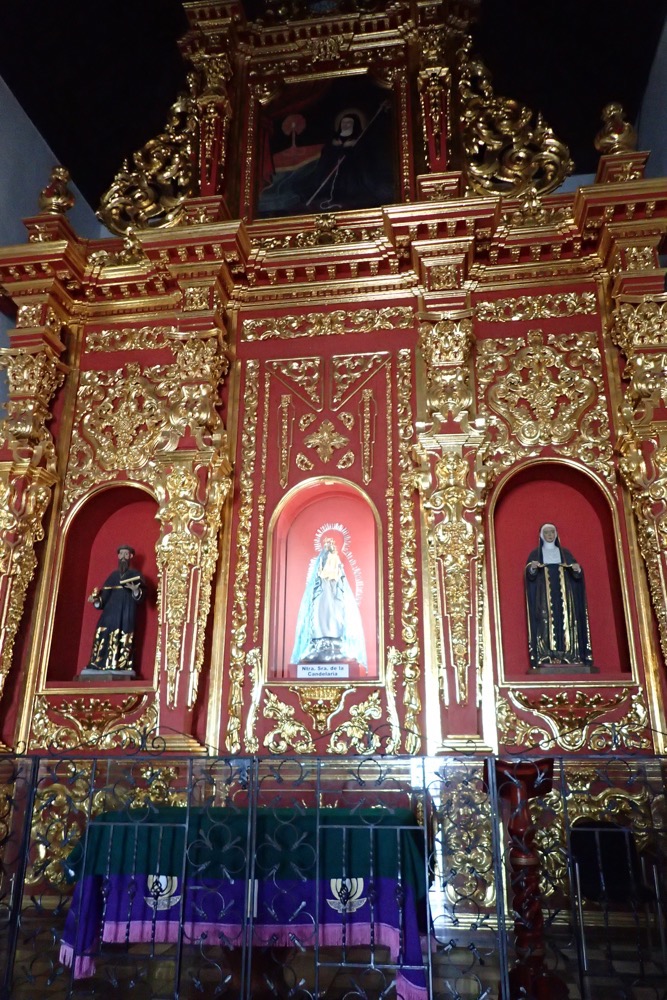 Every year wealthy local women make the Madonna new clothing and there is a room here dedicated to her old clothes. At first the garments looked very impressive, but on closer inspection, it was evident that most of the embroidery was done by machine so I didn’t even bother taking a photo of any of it. #embroiderysnobs
Every year wealthy local women make the Madonna new clothing and there is a room here dedicated to her old clothes. At first the garments looked very impressive, but on closer inspection, it was evident that most of the embroidery was done by machine so I didn’t even bother taking a photo of any of it. #embroiderysnobs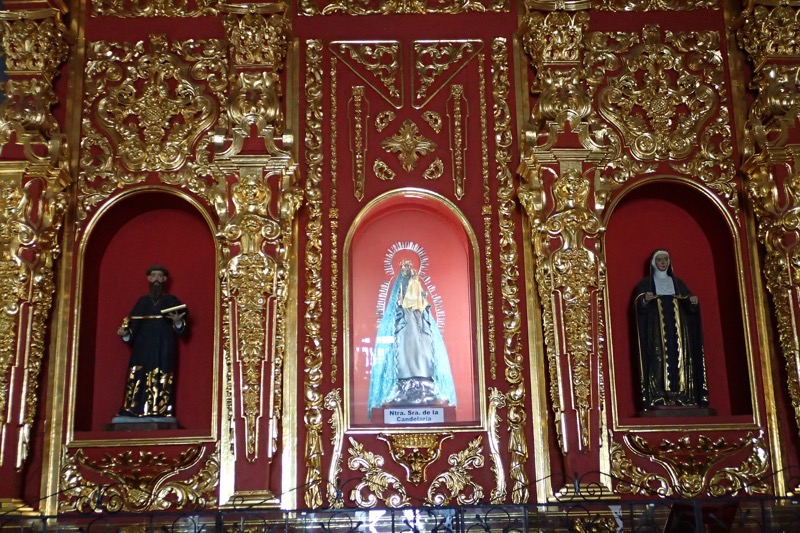 There is a story here that the local pagan Karib and Calamari Indian people worshiped Buziraco, the devil, in the form of a golden goat, and the friar who wanted to build the monastery and the shrine to La Virgen de la Candelaria confronted the devil and his worshippers by throwing the golden goat off the side of the mountain. The devil retaliated with hurricanes and storms until the church was completed, at which point the devil relented and moved deeper into the continent of South America leaving Cartagena alone. The city actually experiences no storms, no earthquakes, and no hurricanes of any sort. This weird diorama at the monastery depicts the native indians worshipping their golden goat… Mercedes, our guide, told us this story was highly unlikely, stating: “Who ever heard of a Catholic priest throwing away gold?”
There is a story here that the local pagan Karib and Calamari Indian people worshiped Buziraco, the devil, in the form of a golden goat, and the friar who wanted to build the monastery and the shrine to La Virgen de la Candelaria confronted the devil and his worshippers by throwing the golden goat off the side of the mountain. The devil retaliated with hurricanes and storms until the church was completed, at which point the devil relented and moved deeper into the continent of South America leaving Cartagena alone. The city actually experiences no storms, no earthquakes, and no hurricanes of any sort. This weird diorama at the monastery depicts the native indians worshipping their golden goat… Mercedes, our guide, told us this story was highly unlikely, stating: “Who ever heard of a Catholic priest throwing away gold?”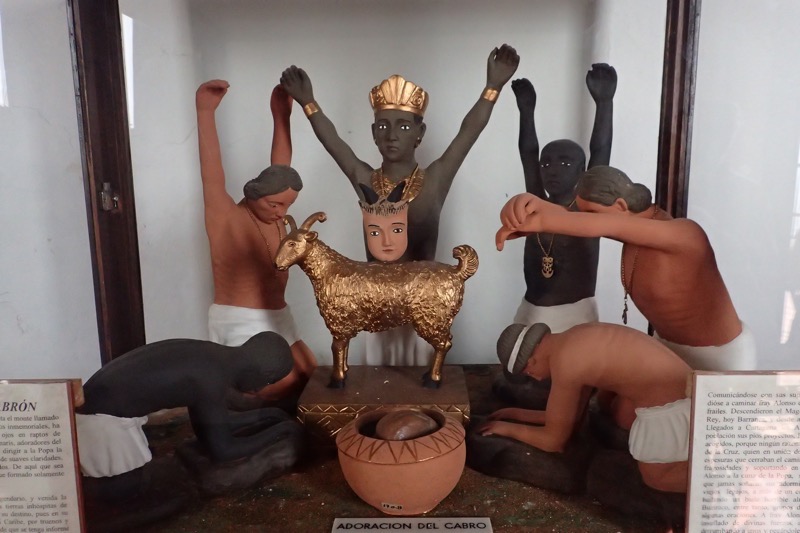
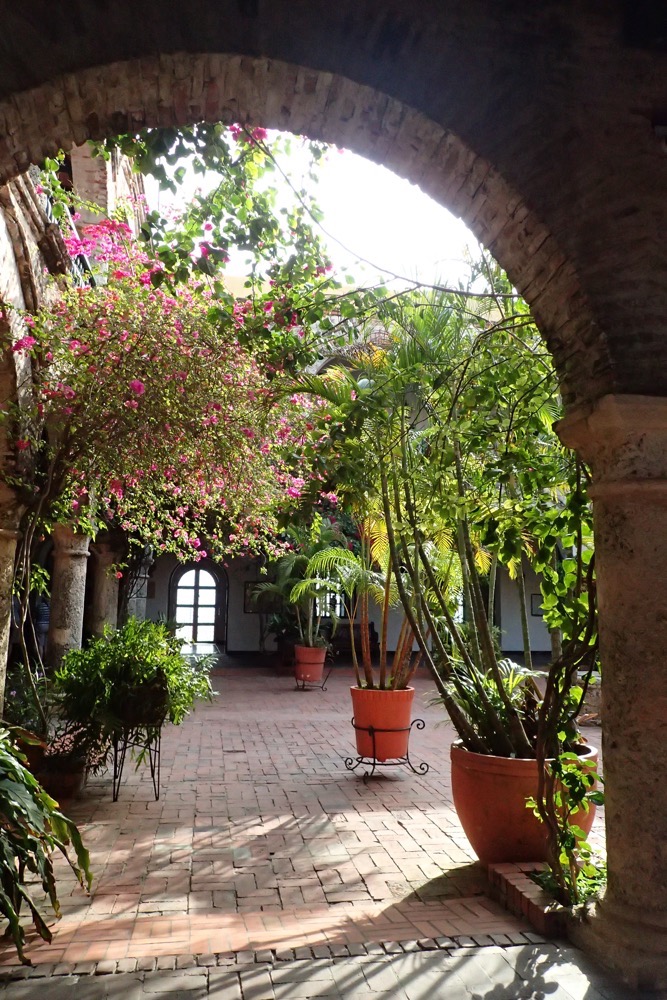
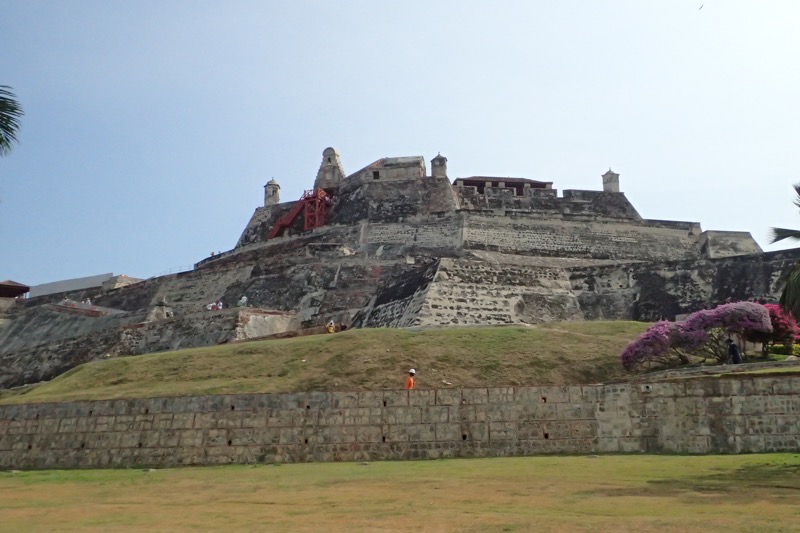
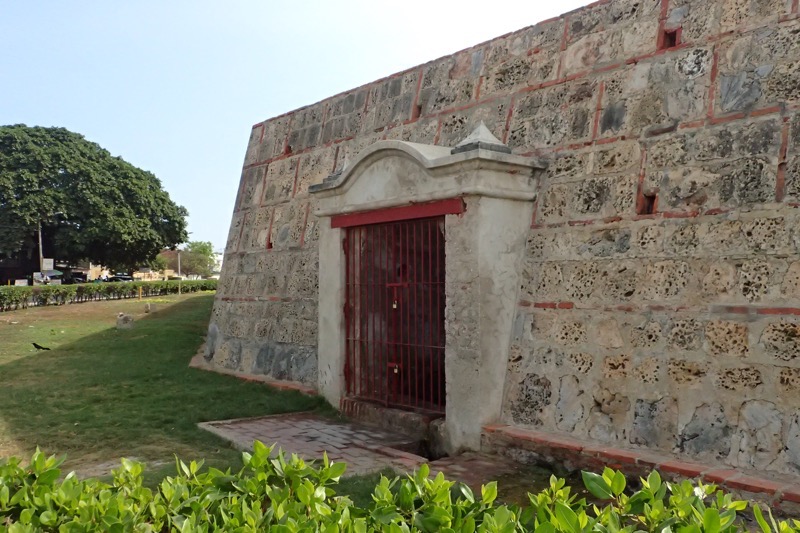
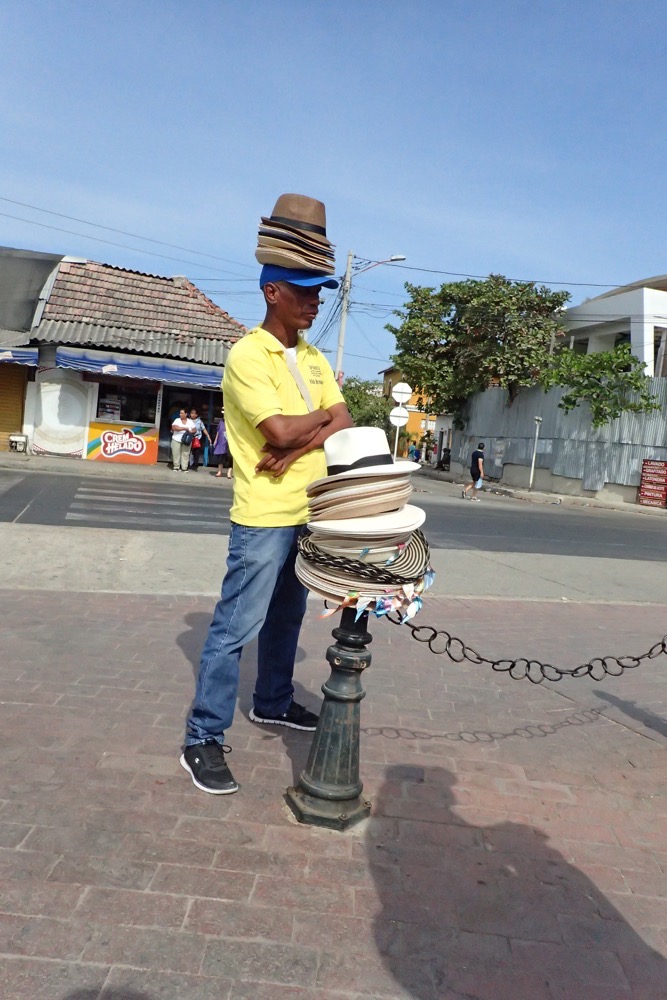
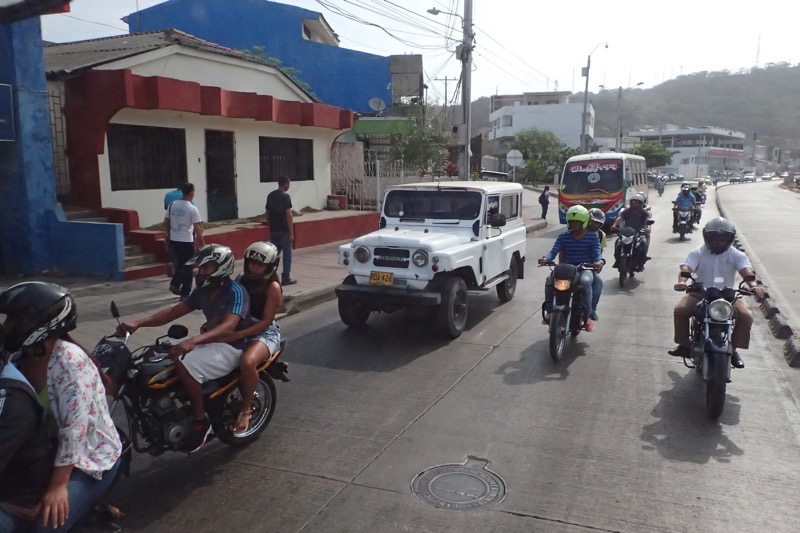 Oh, and nostalgically, I must have seen about 20 old G60 Nissan Patrols today. 🙂 Quite unexpected and not sure why, but they seemed to be everywhere, when you never see them at home anymore. The G60 seems to be an old work horse of choice here and it was lots of fun spotting them in the traffic. BigSal and Trish will recognise them from the air vents under the front windscreen 🙂
Oh, and nostalgically, I must have seen about 20 old G60 Nissan Patrols today. 🙂 Quite unexpected and not sure why, but they seemed to be everywhere, when you never see them at home anymore. The G60 seems to be an old work horse of choice here and it was lots of fun spotting them in the traffic. BigSal and Trish will recognise them from the air vents under the front windscreen 🙂 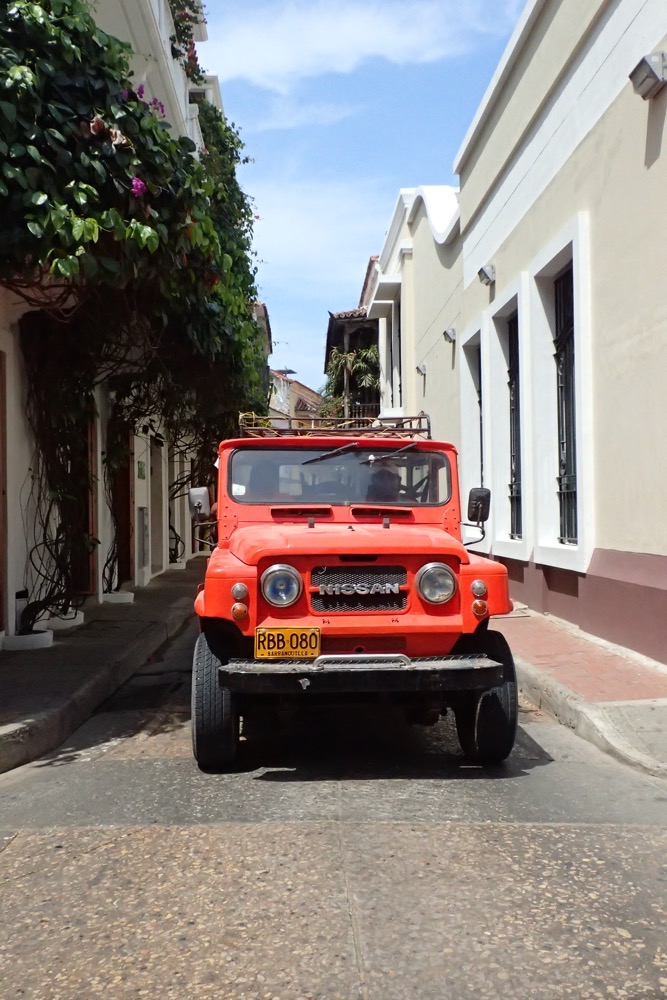
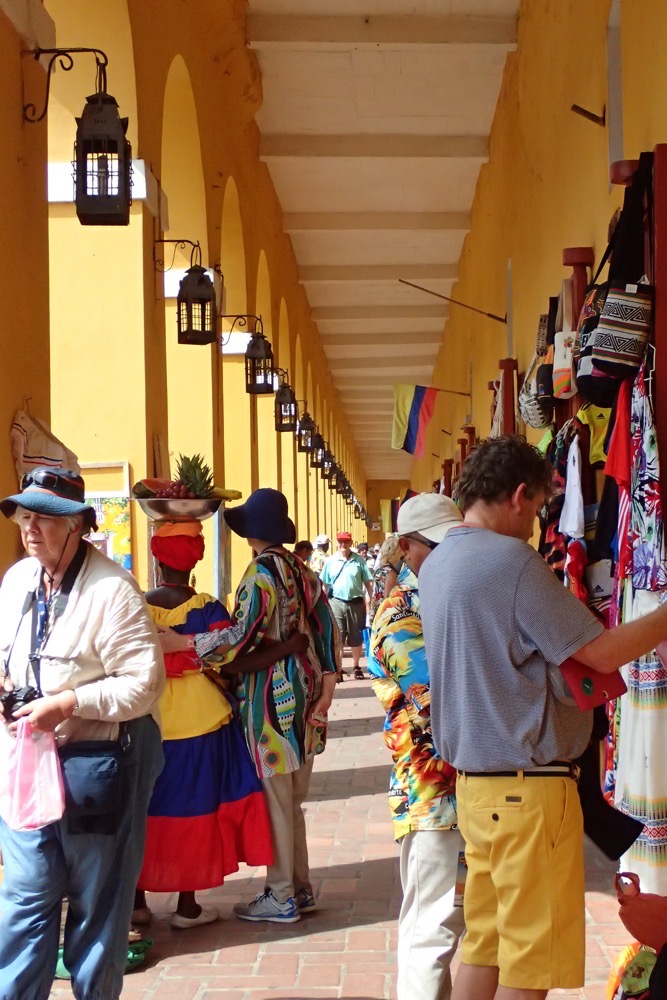 Shopping is a very happy, colourful experience here, excepting where the ladies in the traditional dresses kept coming up to us, and draping their arms around us saying we could take pictures with them and their fruitbaskets for $1. I don’t mind them making money in this way – but please don’t bump into or touch me while I am in a strange country… it makes me immediately do a complete audit of all my pockets and my bag to ensure I still have my wallet and my camera! When playing tourist in a place like Columbia (or Rio or Buenos Aires), you are already on high alert for pickpockets without people touching and bumping into you deliberately. :/
Shopping is a very happy, colourful experience here, excepting where the ladies in the traditional dresses kept coming up to us, and draping their arms around us saying we could take pictures with them and their fruitbaskets for $1. I don’t mind them making money in this way – but please don’t bump into or touch me while I am in a strange country… it makes me immediately do a complete audit of all my pockets and my bag to ensure I still have my wallet and my camera! When playing tourist in a place like Columbia (or Rio or Buenos Aires), you are already on high alert for pickpockets without people touching and bumping into you deliberately. :/ 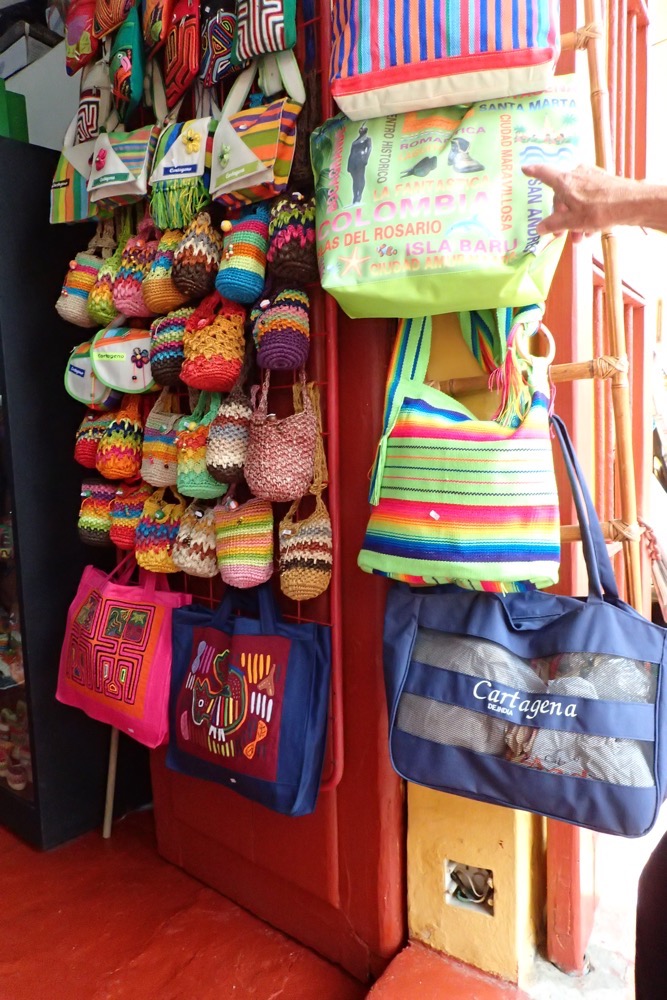 All the souvenirs are crazy colourful.
All the souvenirs are crazy colourful.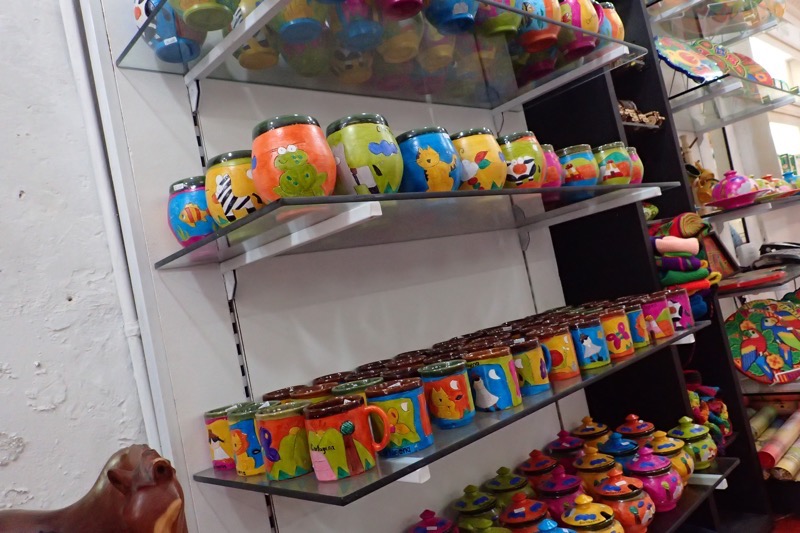
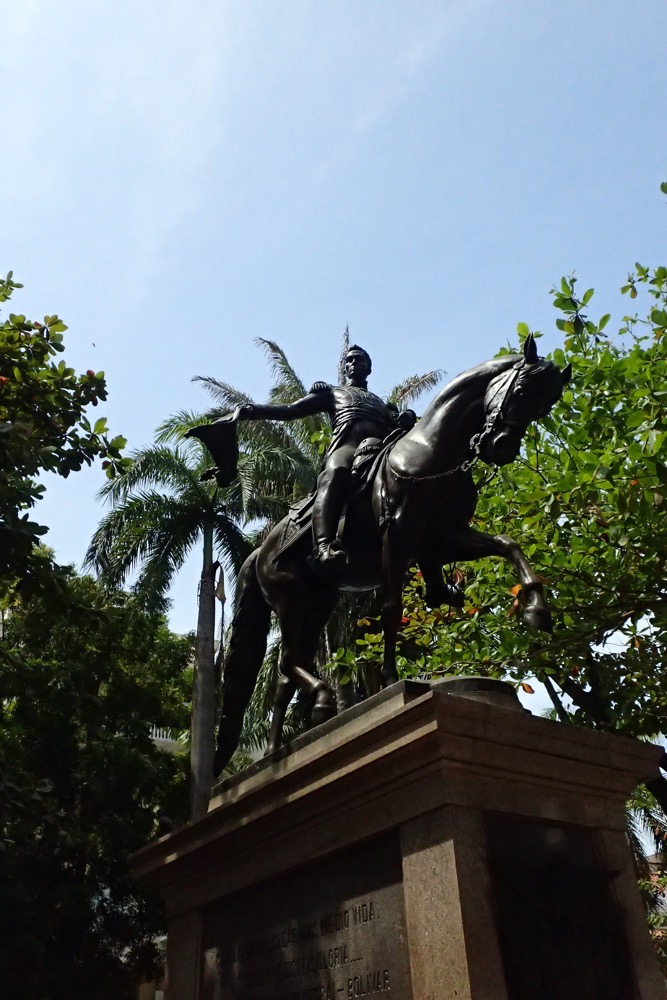
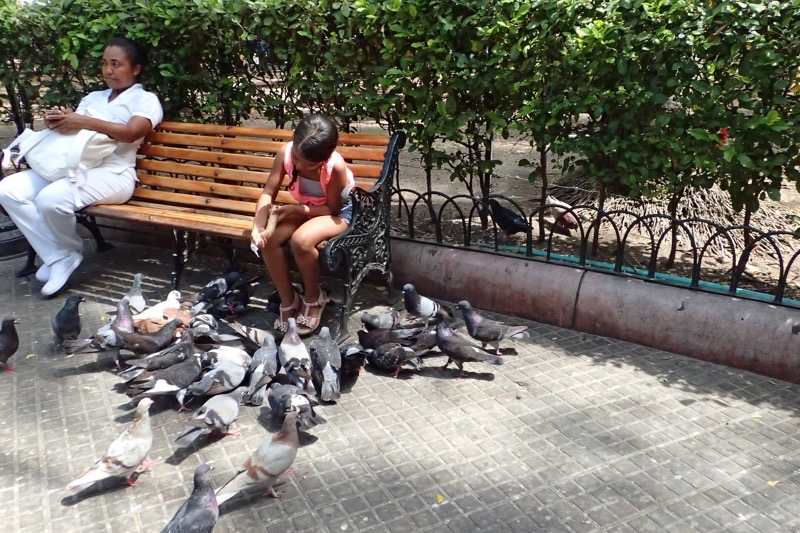 In the town centre is the Historical Museum of Cartagena, which has an impressive colonial facade from the palace museum. The facade stems from the period of the Spanish Inquisition, which of course, no one expected.
In the town centre is the Historical Museum of Cartagena, which has an impressive colonial facade from the palace museum. The facade stems from the period of the Spanish Inquisition, which of course, no one expected.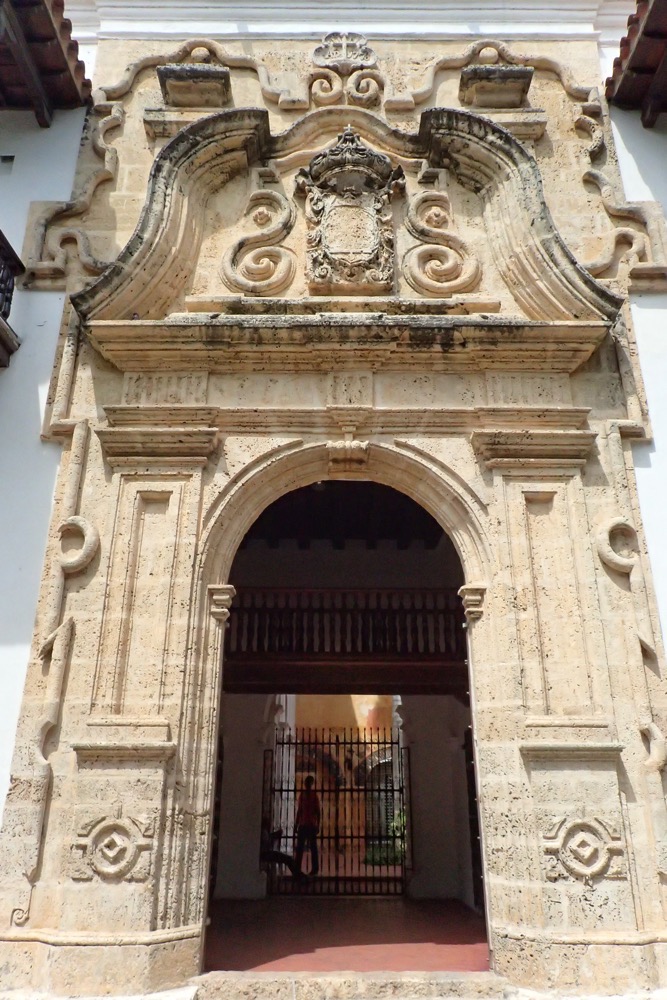 And the museum itself houses many torture instruments that the inquisition used with great creative effect… we did not have time to go through the museum unfortunately, though I heard from one of my dining companions who did go through the museum, that one was able to have their torture put onto a proxy for the right price. Yes, somehow it was acceptable to the Inquisitors to torture the slave of an intended torturee (for a sturdy donation, of course), and that slave recanting on behalf of his owner was sufficient for these sadistic priests!
And the museum itself houses many torture instruments that the inquisition used with great creative effect… we did not have time to go through the museum unfortunately, though I heard from one of my dining companions who did go through the museum, that one was able to have their torture put onto a proxy for the right price. Yes, somehow it was acceptable to the Inquisitors to torture the slave of an intended torturee (for a sturdy donation, of course), and that slave recanting on behalf of his owner was sufficient for these sadistic priests!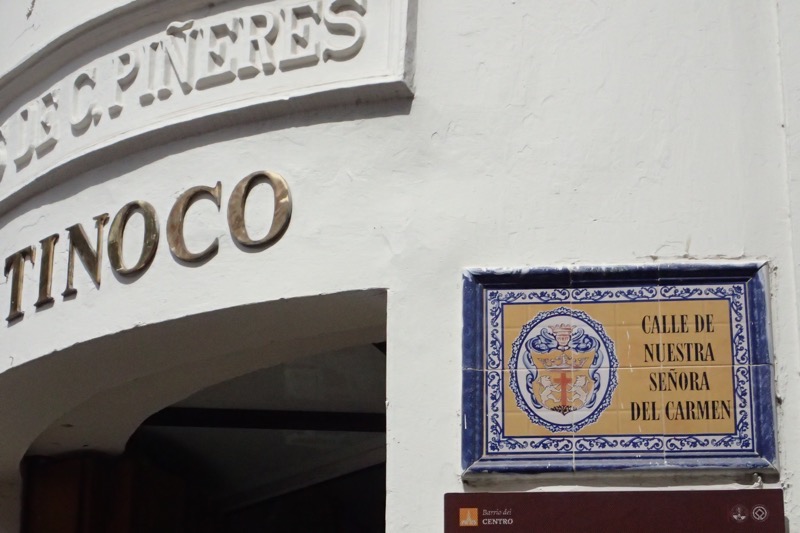 The Old City is the walled historic centre of Cartagena, which (like everything else in South America) has been listed as a UNESCO World Heritage Site. It is full of winding streets and bright colourfully painted Spanish colonial architecture. Mercedes informs us here that many of the old private homes are now all used as hotels, bars and restaurants. The homes were built to house large Catholic merchant families where it was not uncommon to have 10-15 children. The downstairs of the house would be for work, trading, selling etc., the mezzanine floor would be used to house guests – as it took 55 days to sail from Spain to Cartagena, people would come and visit for extended periods of time, so most wealthy homes had space for semi-permanent guests. The upstairs of the house would accommodate the actual family, so big enough for 10-15 people. You can see the small balconies of the mezzanine ‘guest’ floors, under the main balconies upstairs for the family.
The Old City is the walled historic centre of Cartagena, which (like everything else in South America) has been listed as a UNESCO World Heritage Site. It is full of winding streets and bright colourfully painted Spanish colonial architecture. Mercedes informs us here that many of the old private homes are now all used as hotels, bars and restaurants. The homes were built to house large Catholic merchant families where it was not uncommon to have 10-15 children. The downstairs of the house would be for work, trading, selling etc., the mezzanine floor would be used to house guests – as it took 55 days to sail from Spain to Cartagena, people would come and visit for extended periods of time, so most wealthy homes had space for semi-permanent guests. The upstairs of the house would accommodate the actual family, so big enough for 10-15 people. You can see the small balconies of the mezzanine ‘guest’ floors, under the main balconies upstairs for the family.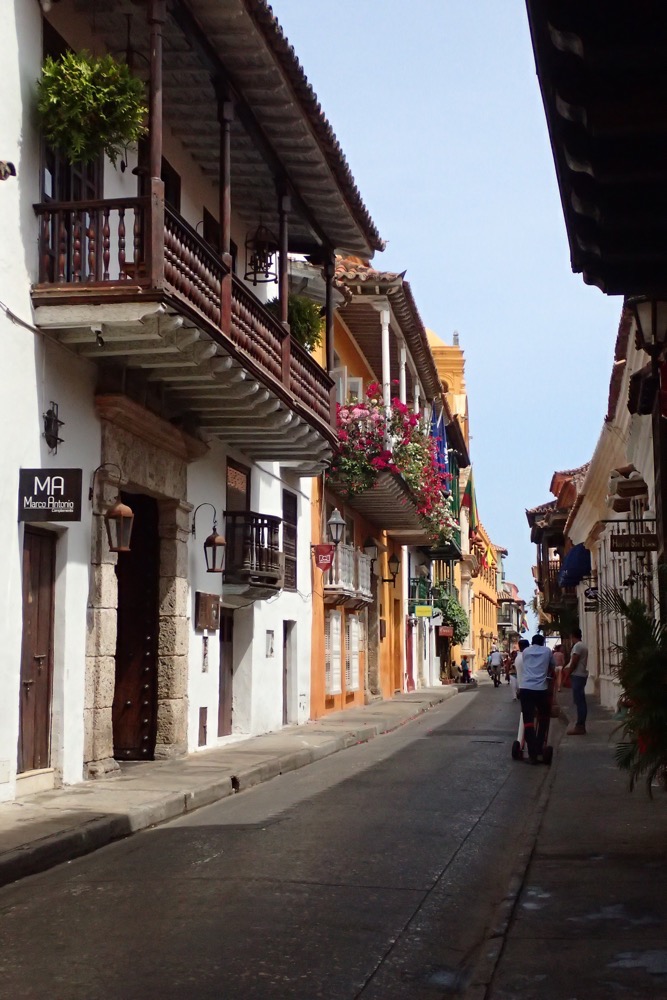
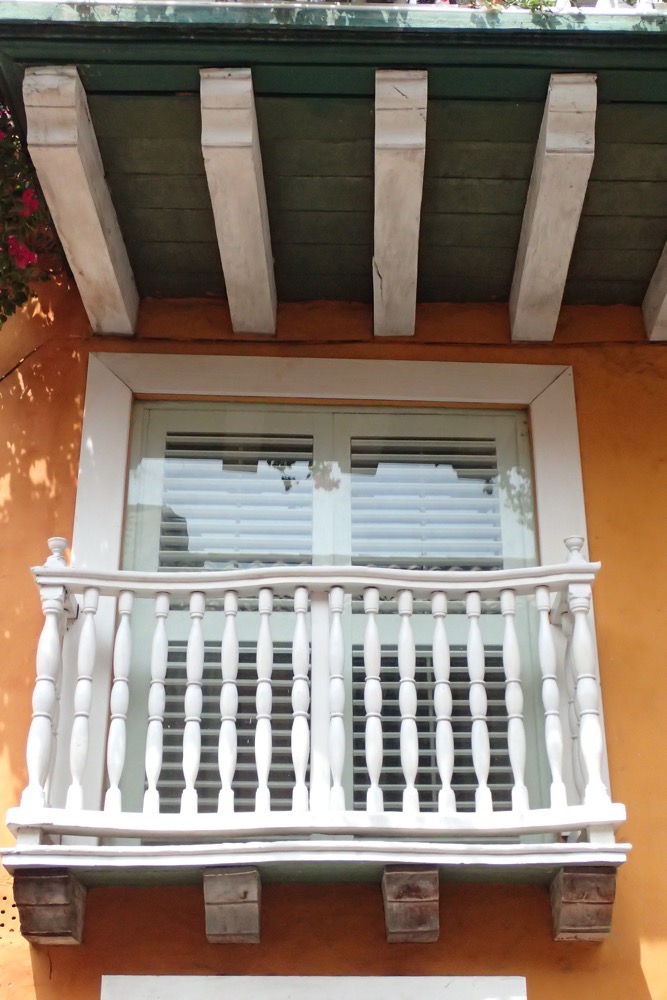 Many of these old buildings have these mezzanine balconies, original slate and stone floors, and original brickwork from the 16th – 17thC. Absolutely beautiful.
Many of these old buildings have these mezzanine balconies, original slate and stone floors, and original brickwork from the 16th – 17thC. Absolutely beautiful.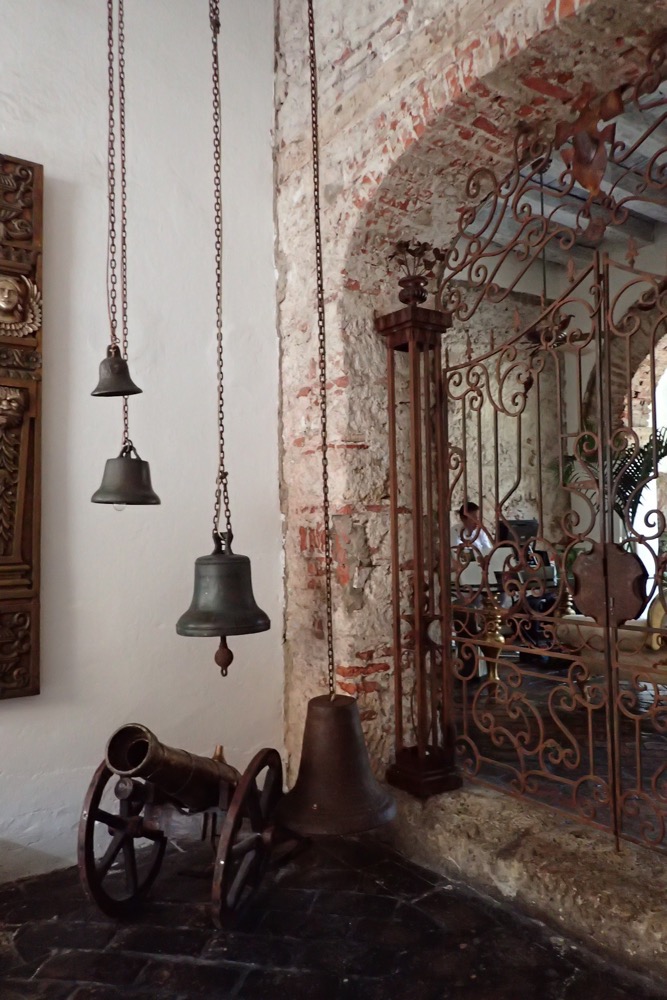
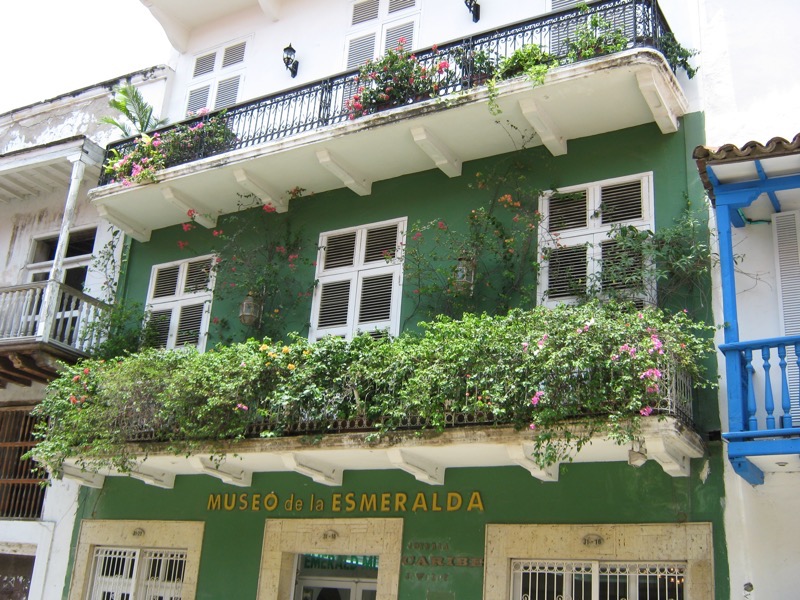
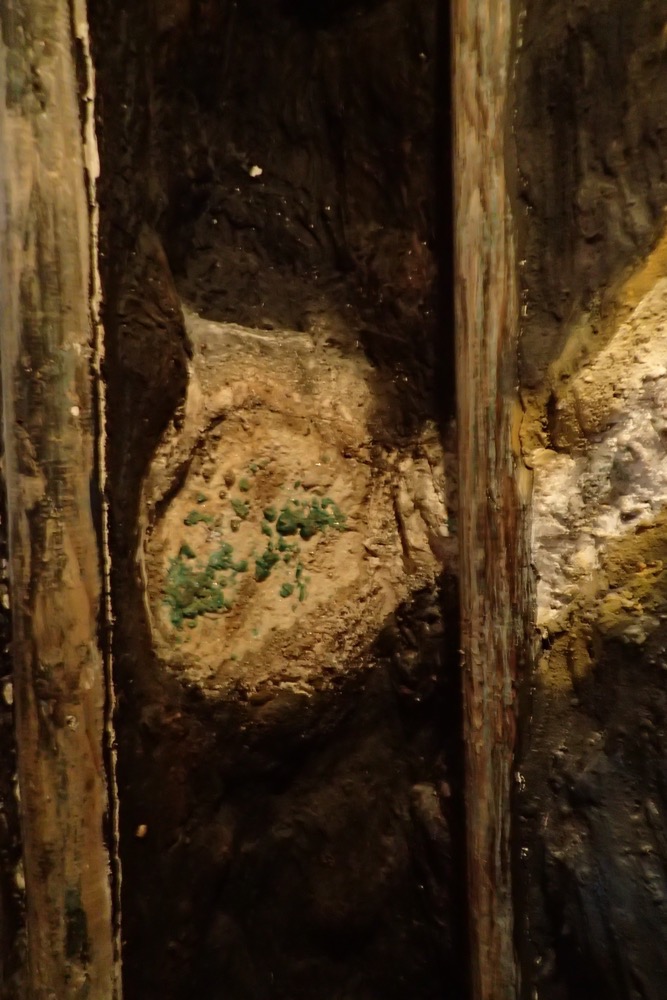
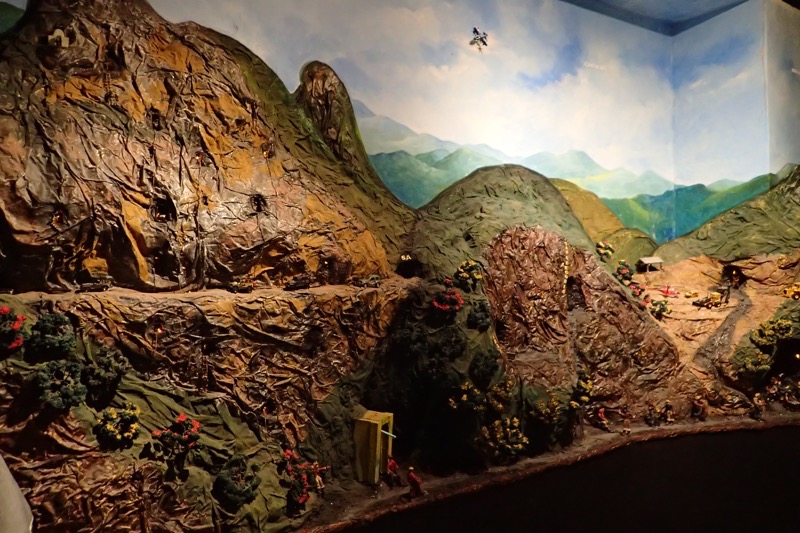
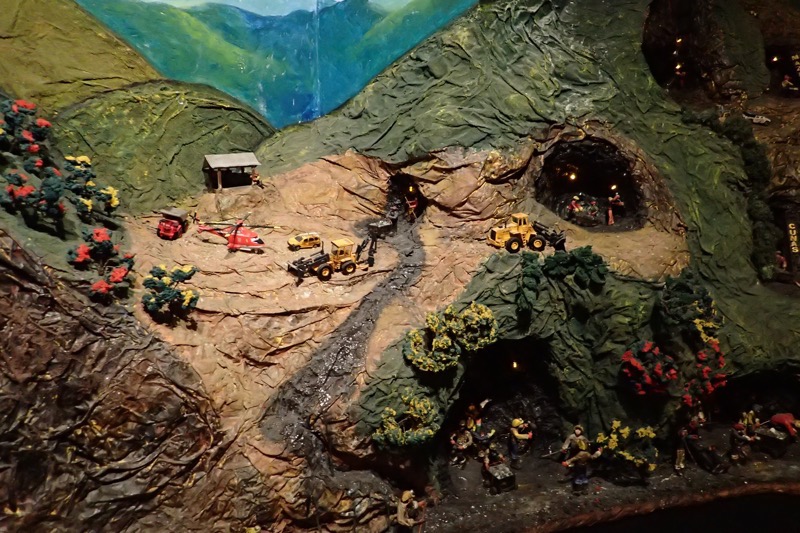 A diorama depicting the El Dorado Ceremony – “When the Muisca chief passed away, his nephew was acknowledged as the new chief by this people. During a ceremony priests undressed the chief and anointed him with a viscous mixture of soil and gold powder. Then the chief would get on a raft with large amounts of gold and emeralds at his feet. Other chiefs decked with feathers, crowns, armlets, pendants etc carried an offering and sat on the raft. As soon as the raft left the edge of the water, whistles, trumpets flutes and songs would play until the raft reached the centre of the lake. The chief would throw himself into the water with his offerings and the rafter would go back to honour the new heir who was now recognised as the chief and prince.” Not sure what is happening there? Does the nephew get sacrificed for the actual son of the chief to take his place?
A diorama depicting the El Dorado Ceremony – “When the Muisca chief passed away, his nephew was acknowledged as the new chief by this people. During a ceremony priests undressed the chief and anointed him with a viscous mixture of soil and gold powder. Then the chief would get on a raft with large amounts of gold and emeralds at his feet. Other chiefs decked with feathers, crowns, armlets, pendants etc carried an offering and sat on the raft. As soon as the raft left the edge of the water, whistles, trumpets flutes and songs would play until the raft reached the centre of the lake. The chief would throw himself into the water with his offerings and the rafter would go back to honour the new heir who was now recognised as the chief and prince.” Not sure what is happening there? Does the nephew get sacrificed for the actual son of the chief to take his place?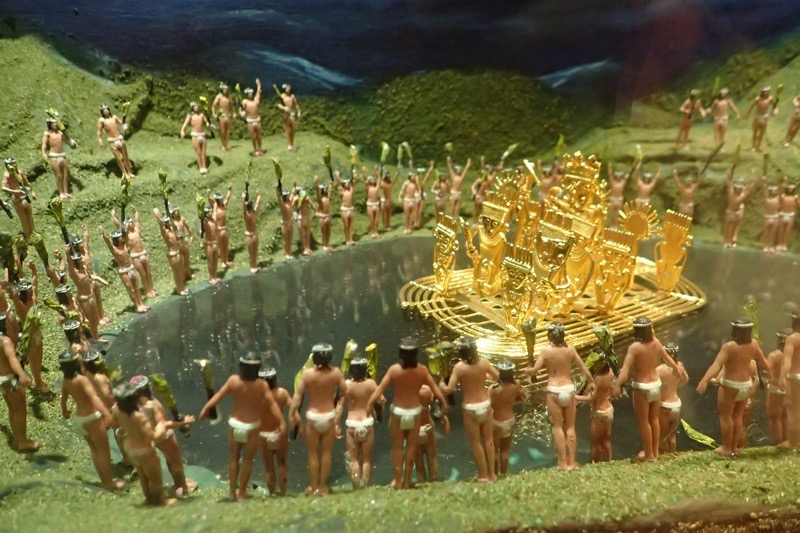 The ‘museum’ continued in an equally confusing theme full of strange little dioramas…
The ‘museum’ continued in an equally confusing theme full of strange little dioramas…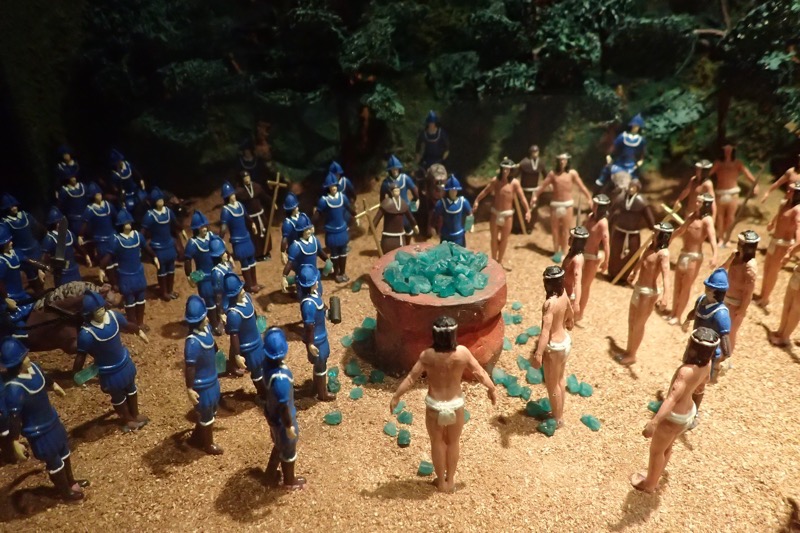
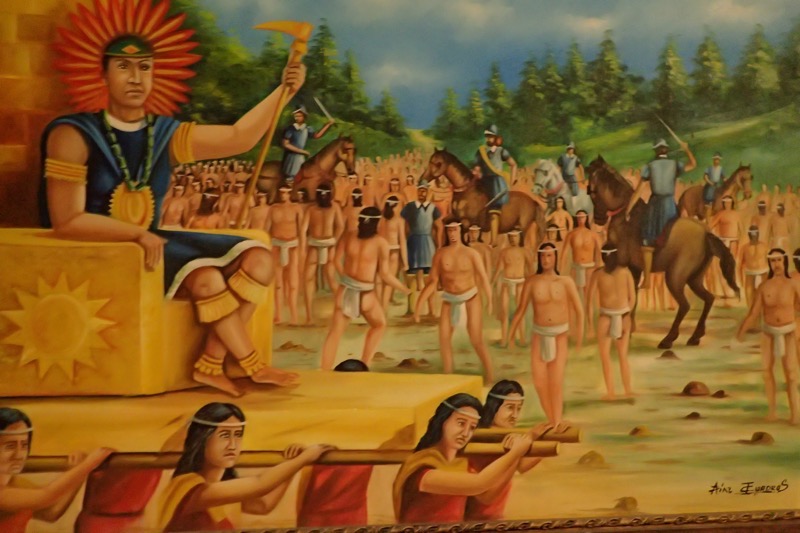 Everywhere were signs and things telling you how superior the Columbia emeralds are to those mined in other areas of the world…
Everywhere were signs and things telling you how superior the Columbia emeralds are to those mined in other areas of the world…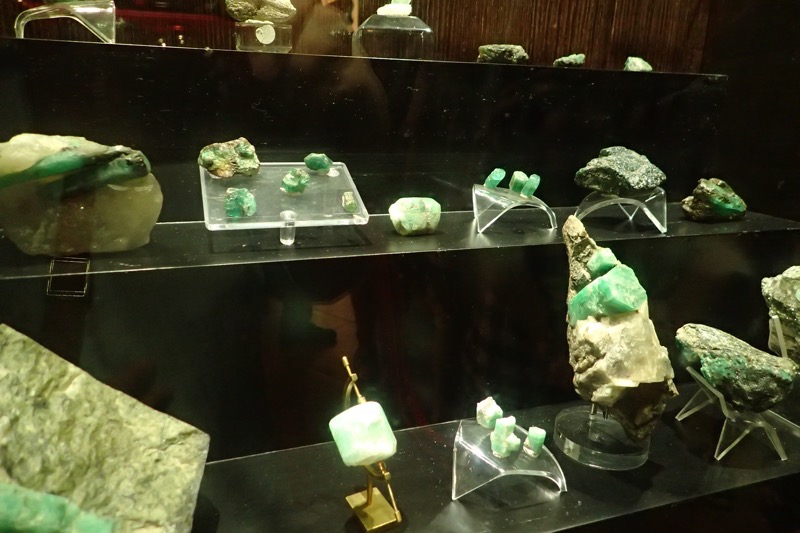
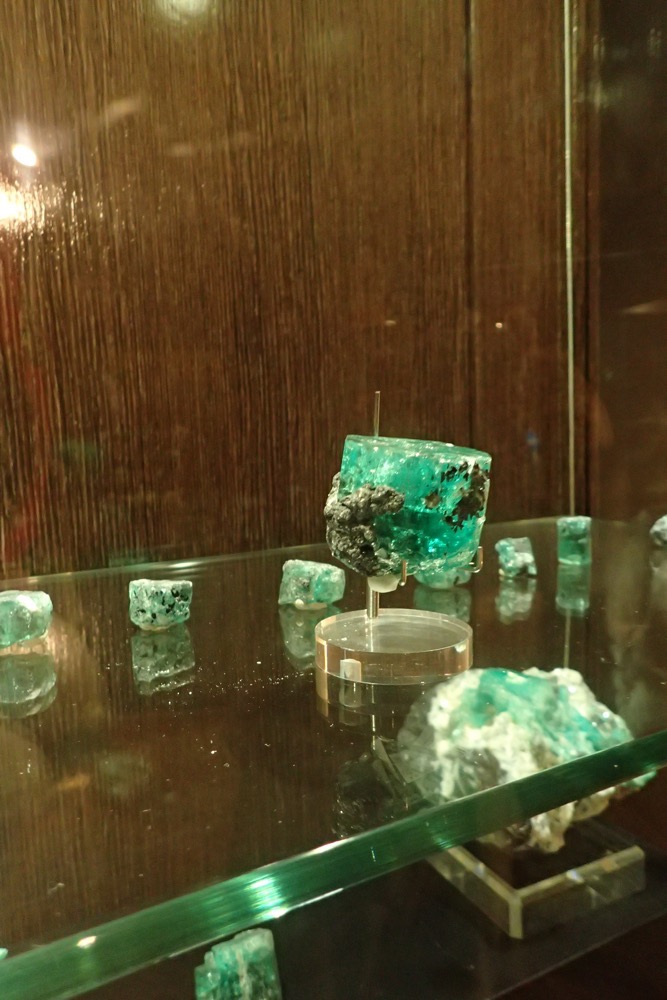 There was even a guy here hand cutting emeralds…
There was even a guy here hand cutting emeralds… 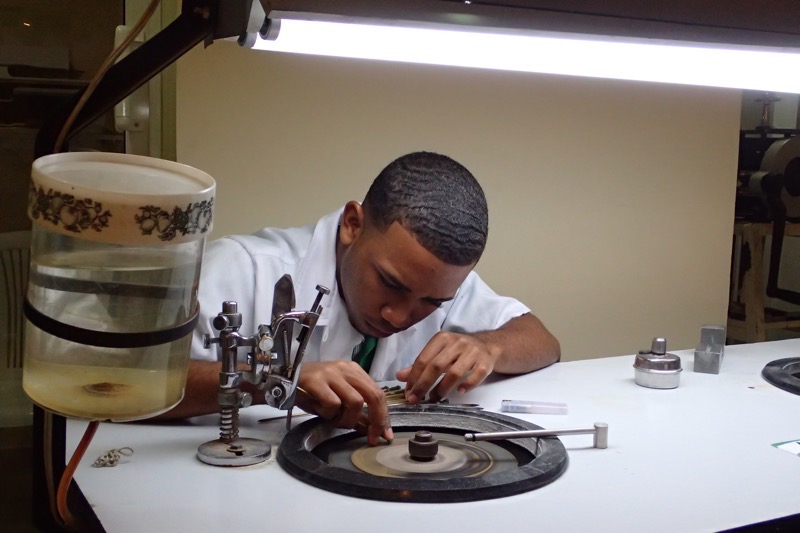
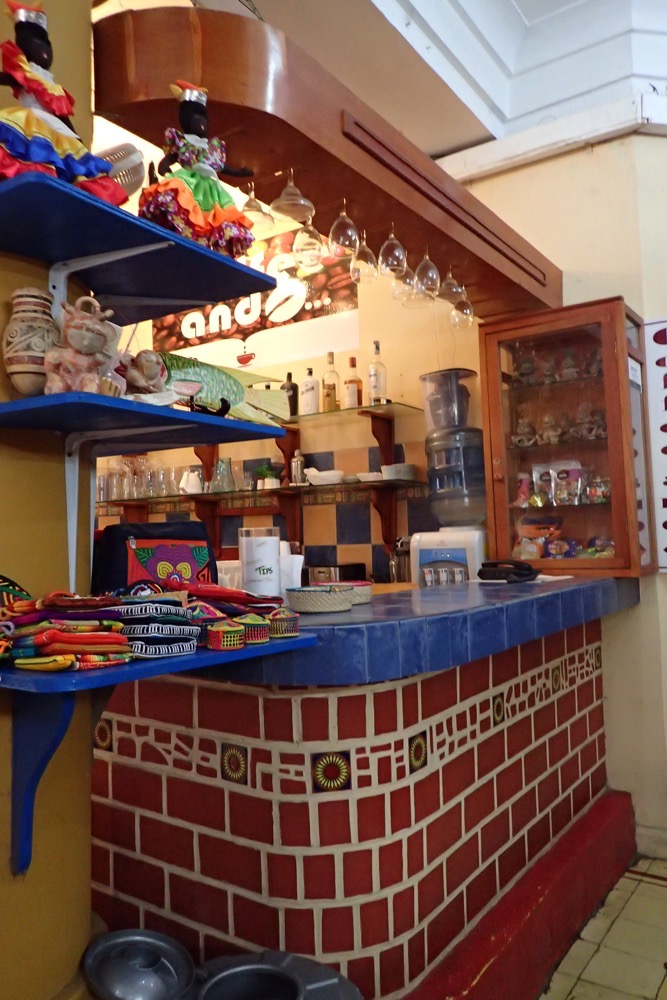
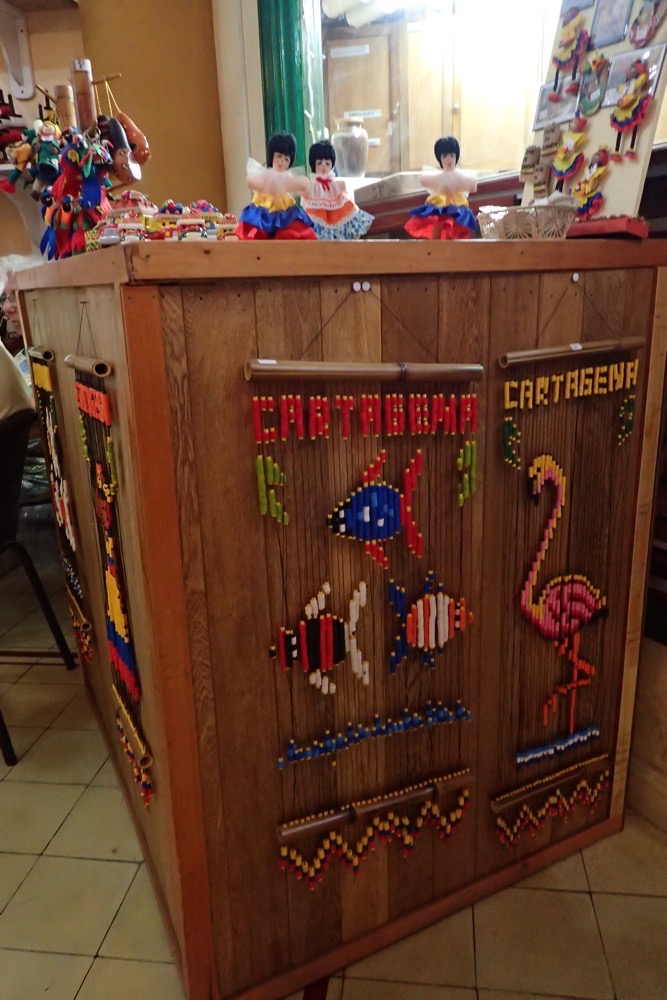
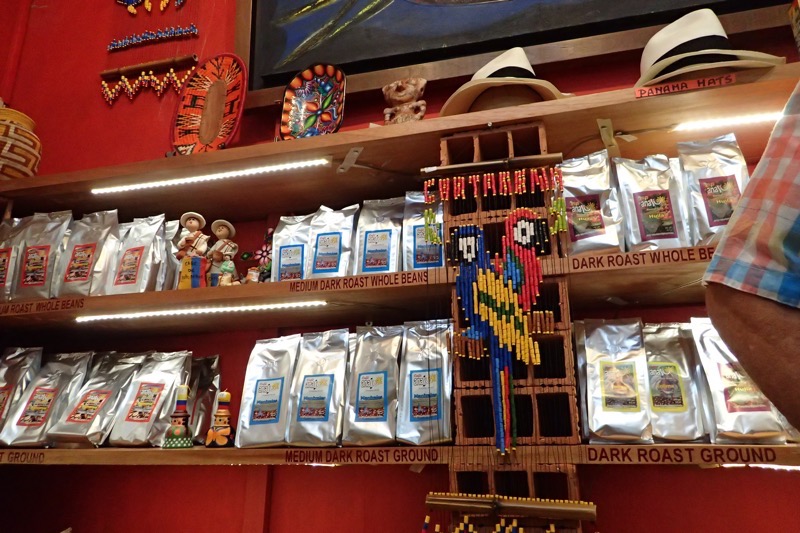 But ever being a contrary little thing – I hate coffee and don’t really like chocolate either. So I went for a wander in the streets instead of being assaulted by the coffee smells. There are lots of people selling colourful wares along the streets in the Old City. Mostly hats, coral necklaces, bags, textiles, and little wristbands that say ‘Cartagena’ seemed to be really popular – but everything is crazy colourful still.
But ever being a contrary little thing – I hate coffee and don’t really like chocolate either. So I went for a wander in the streets instead of being assaulted by the coffee smells. There are lots of people selling colourful wares along the streets in the Old City. Mostly hats, coral necklaces, bags, textiles, and little wristbands that say ‘Cartagena’ seemed to be really popular – but everything is crazy colourful still.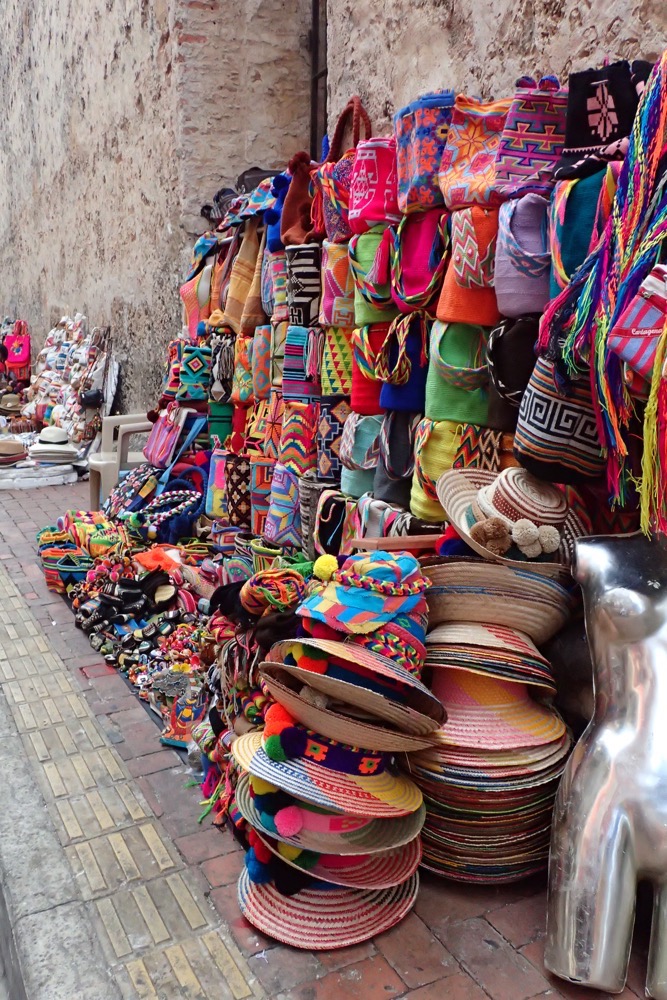
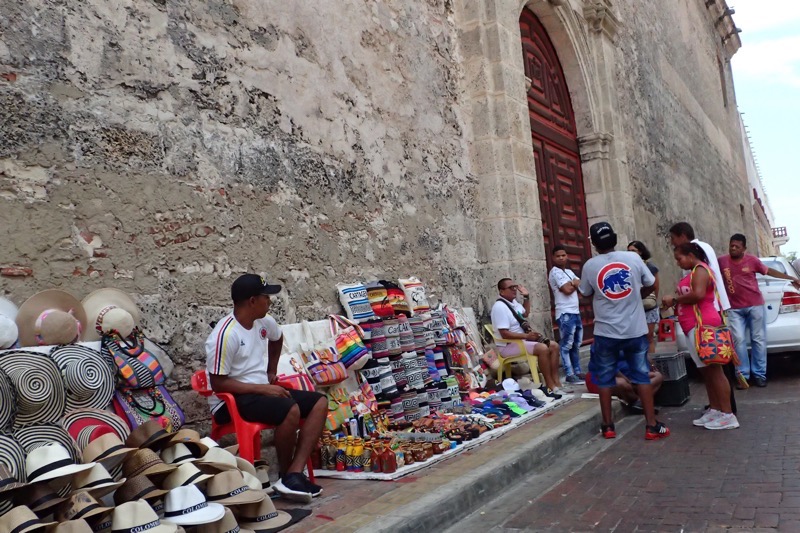 Columbia is one of the few South American countries never to be under dictatorial rule, this is in part due to the fact that members of the military are unable to vote – as we know, most dictators emerge from military coups. Military service is mandatory for 18 months for every male at 18 years of age. The only exception is where a family has a singular male child – obviously this is because if anything were to happen to that male child, there would be no ‘man in the house’ to look after the remaining family. (insert a dry futile nod to the blatant thriving patriarchy, here)
Columbia is one of the few South American countries never to be under dictatorial rule, this is in part due to the fact that members of the military are unable to vote – as we know, most dictators emerge from military coups. Military service is mandatory for 18 months for every male at 18 years of age. The only exception is where a family has a singular male child – obviously this is because if anything were to happen to that male child, there would be no ‘man in the house’ to look after the remaining family. (insert a dry futile nod to the blatant thriving patriarchy, here)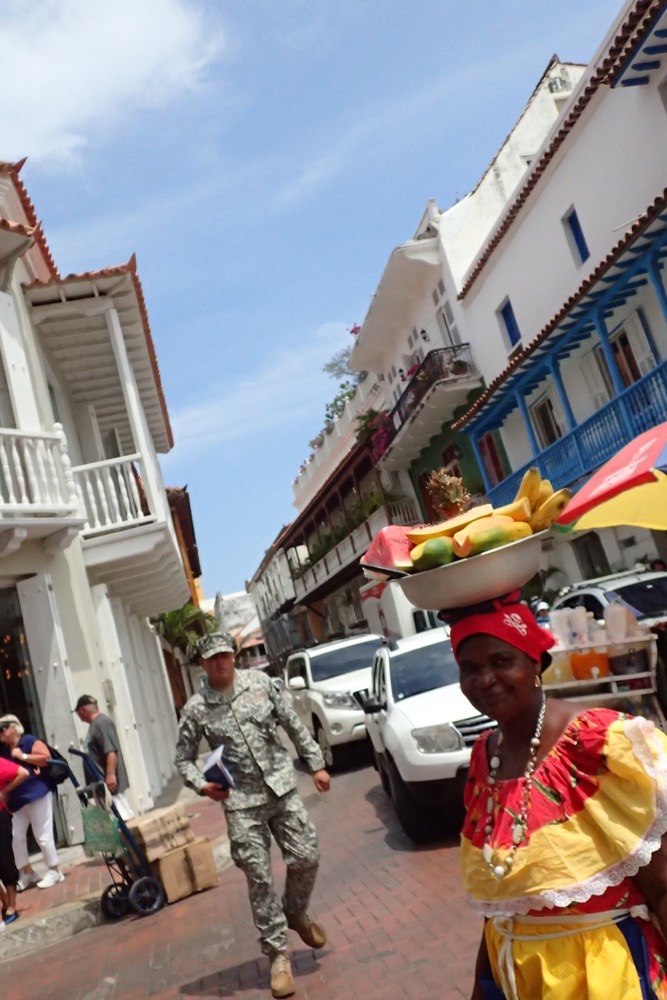
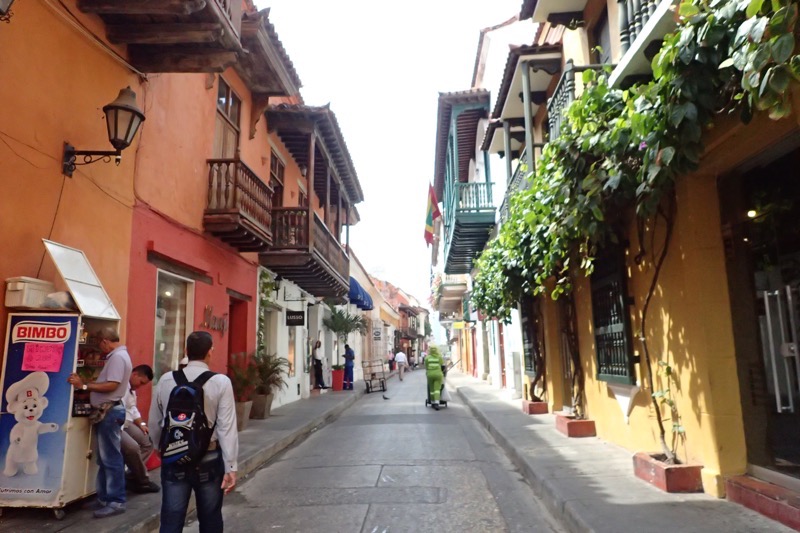
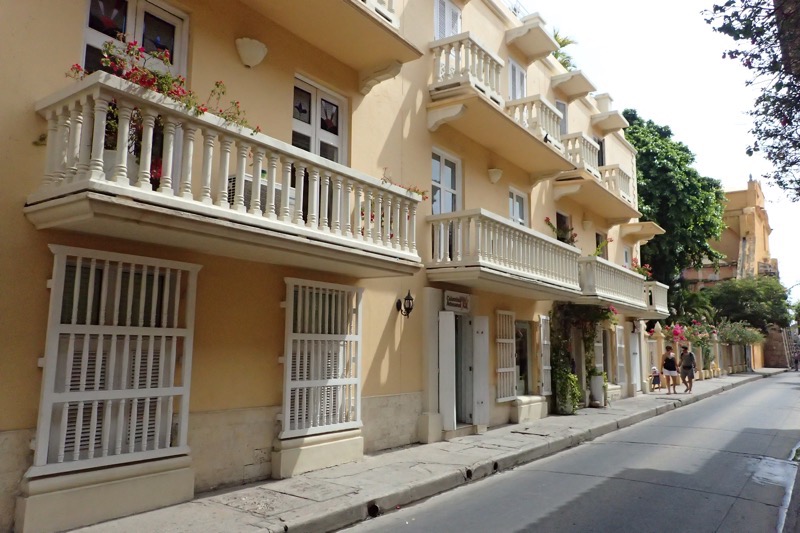
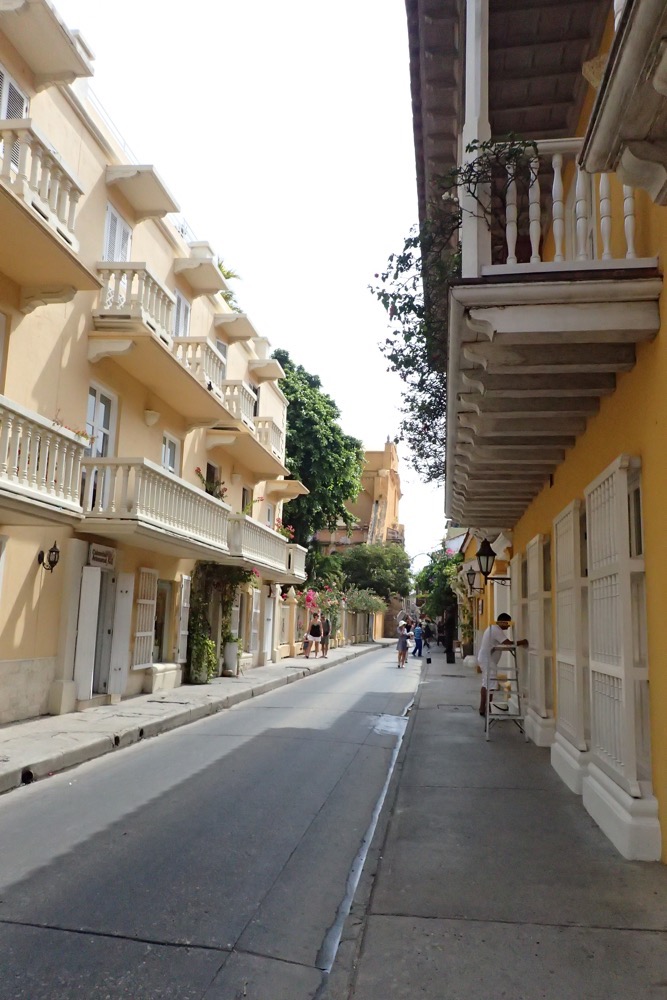
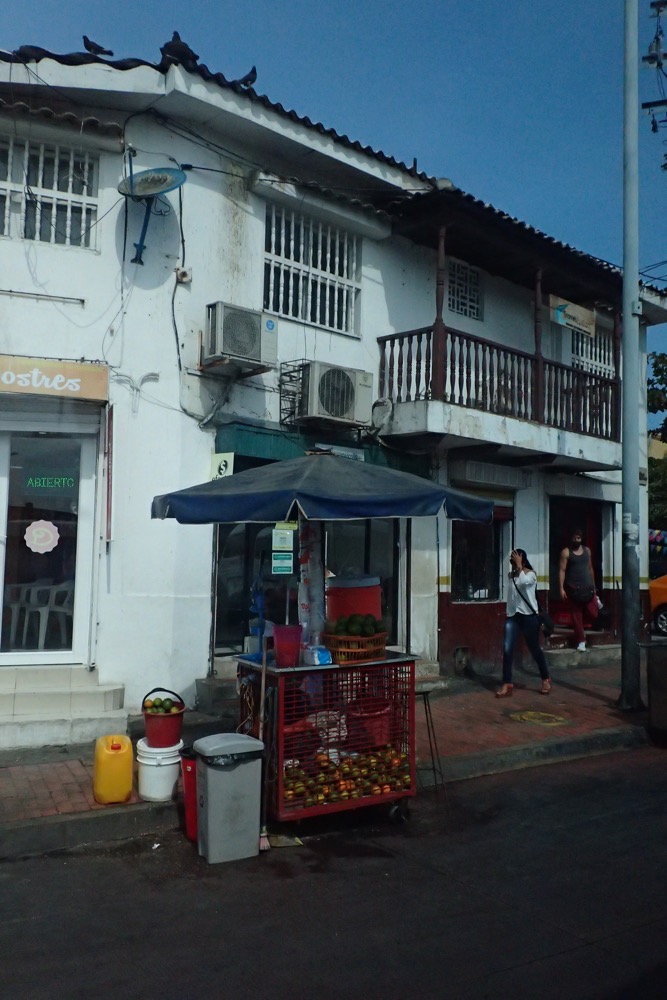 Our next visit was to the Monasterio de San Pedro Cláver, a Jesuit temple that is part of a large monastery with religious buildings that include the Cloister of San Pedro Cláver and a small archaeological museum. It was built between 1580 and 1654, and apparently the body of Saint Peter Claver is located in its main altar.
Our next visit was to the Monasterio de San Pedro Cláver, a Jesuit temple that is part of a large monastery with religious buildings that include the Cloister of San Pedro Cláver and a small archaeological museum. It was built between 1580 and 1654, and apparently the body of Saint Peter Claver is located in its main altar.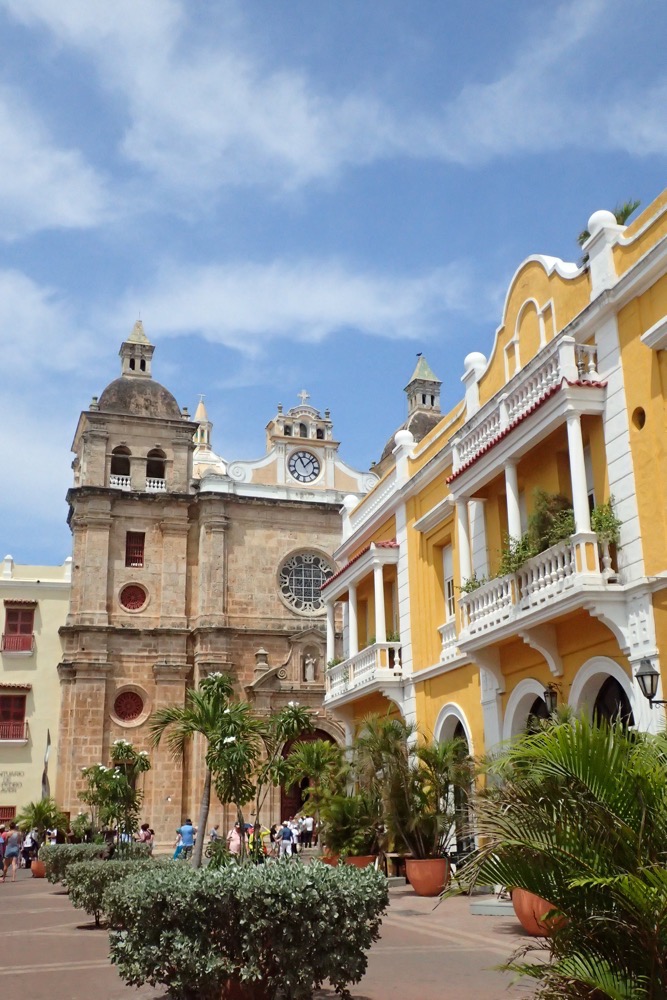
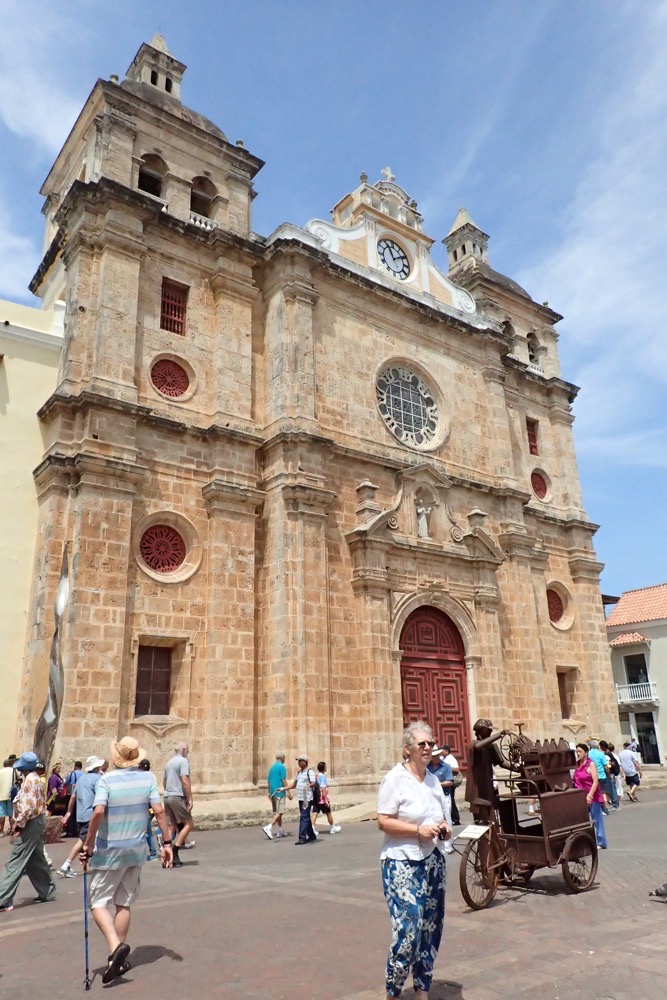 Directly in front of the church is the bronze sculpture Mujer Reclinada, (RecliningWoman) by an artist named Botero. He copped a lot of criticism for placing a naked woman directly outside the Monasterio de San Pedro Cláver, with people saying it was inappropriate for a statue of this type to be placed beside a church – his response? Have you been to the Vatican? It is covered in naked people. Touche Signor Botero.
Directly in front of the church is the bronze sculpture Mujer Reclinada, (RecliningWoman) by an artist named Botero. He copped a lot of criticism for placing a naked woman directly outside the Monasterio de San Pedro Cláver, with people saying it was inappropriate for a statue of this type to be placed beside a church – his response? Have you been to the Vatican? It is covered in naked people. Touche Signor Botero.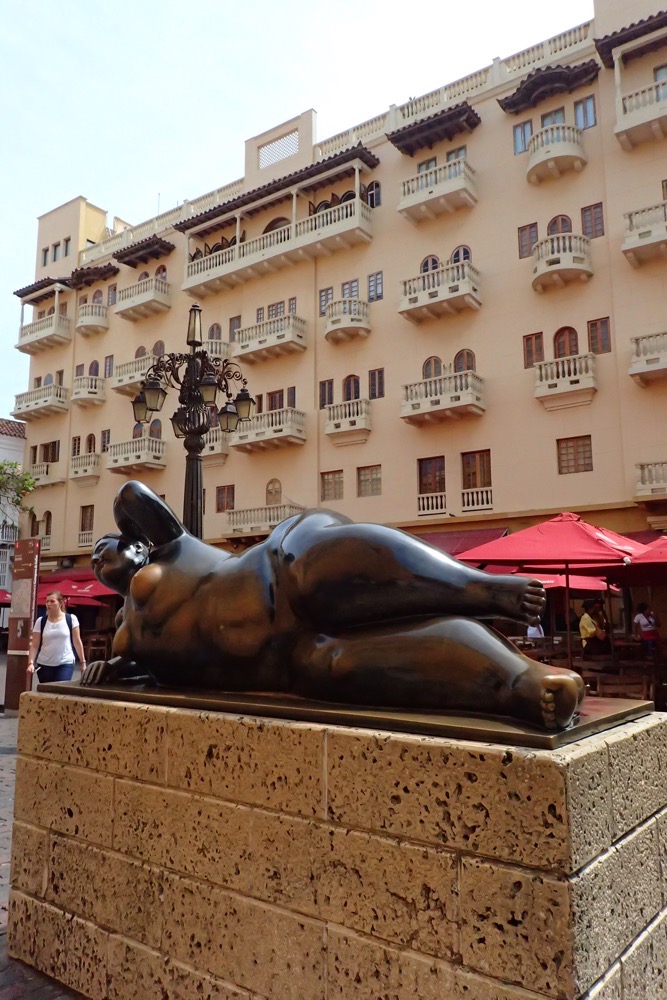 Buy your own Mujer Reclinada…
Buy your own Mujer Reclinada…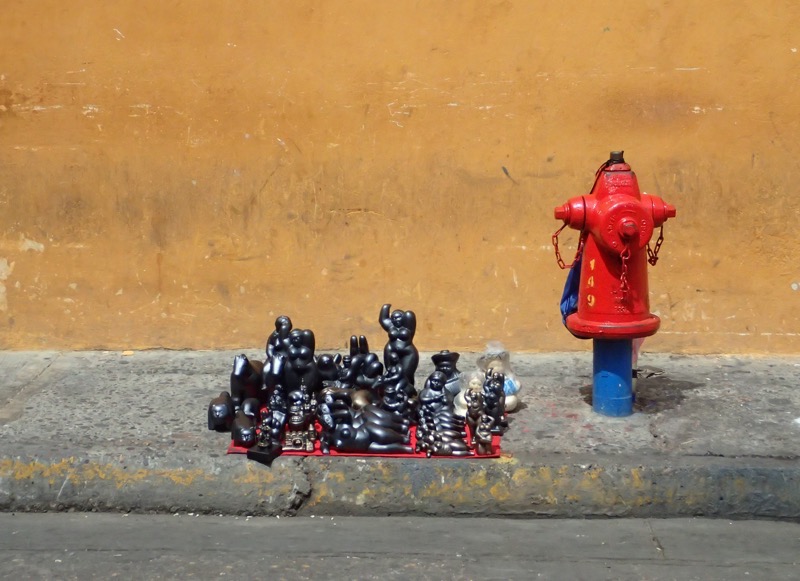
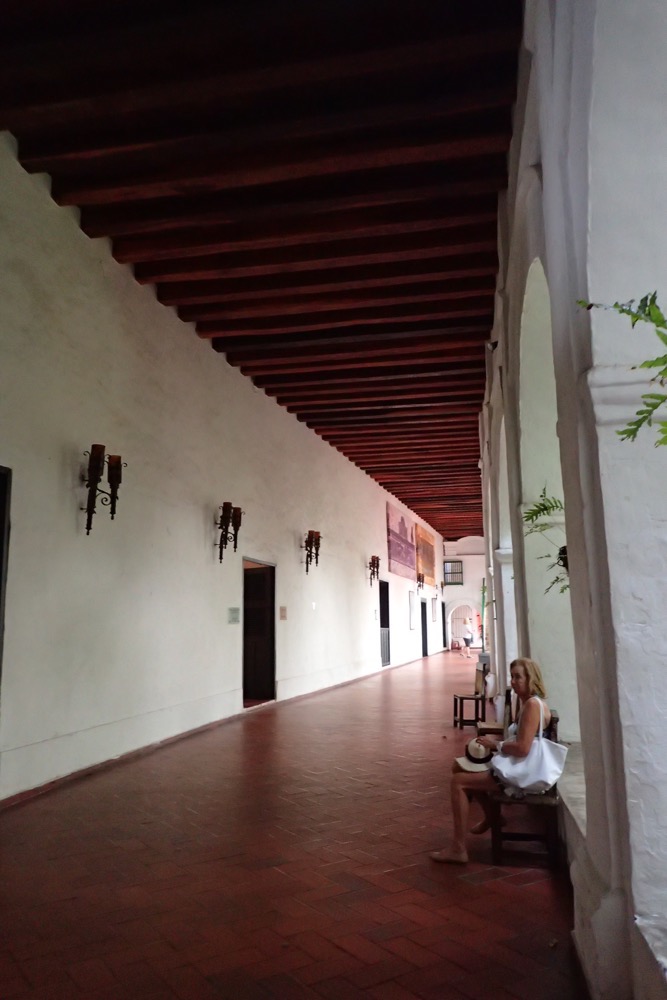 Inside is another cloistered courtyard which is also home to an active monastery community.
Inside is another cloistered courtyard which is also home to an active monastery community.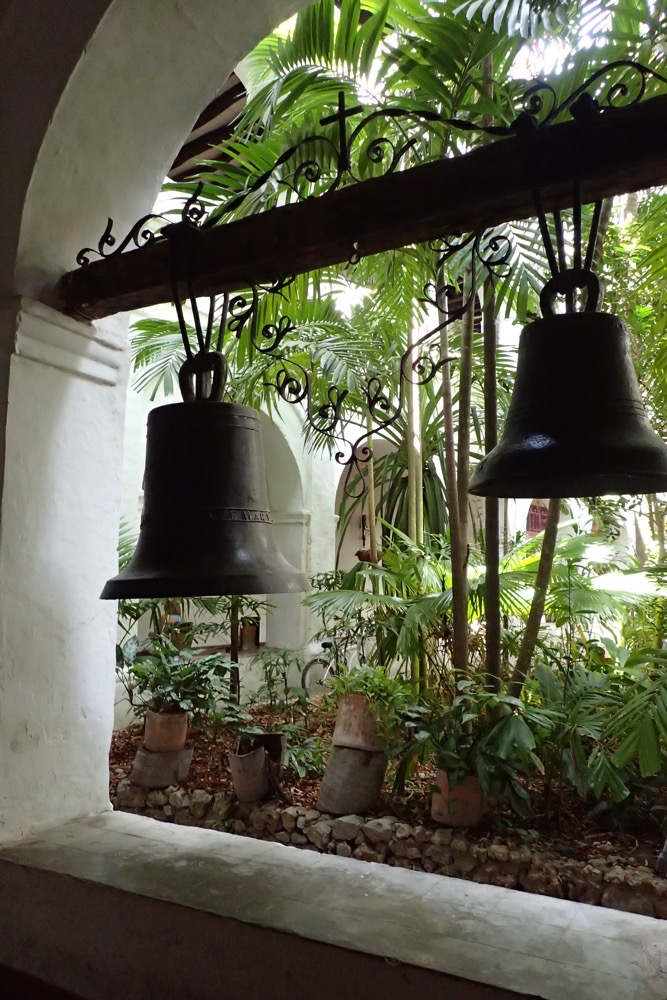 Many of these items in the Collection of Religious Art were created form the 16th to 20th centuries, being sacradotal in origin, many of the artists names were lost. These items have been either donated to the Jesuits or rescued by them when buildings were being destroyed for redevelopment.
Many of these items in the Collection of Religious Art were created form the 16th to 20th centuries, being sacradotal in origin, many of the artists names were lost. These items have been either donated to the Jesuits or rescued by them when buildings were being destroyed for redevelopment. 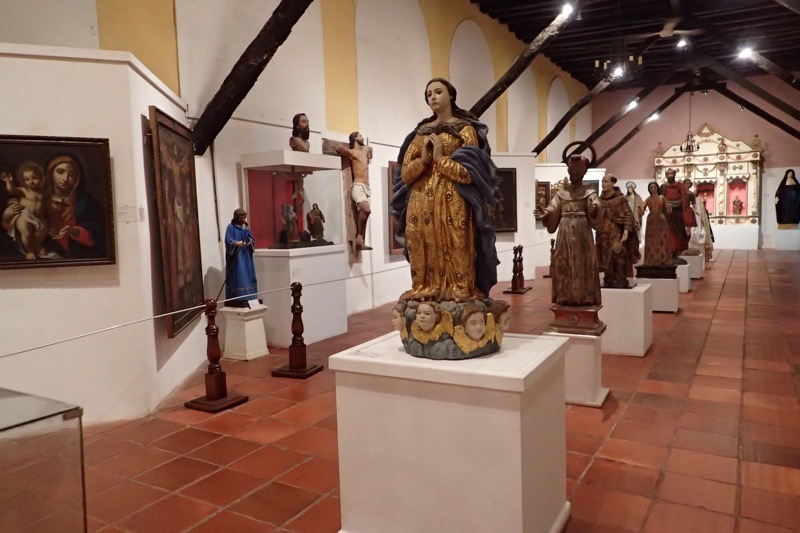 This altar is an example of what a modest chapel may contain – as compared to the impressive gold worked altar at La Popa. You can see a Freemason influence with the all seeing eye of God at the very top of the altar.
This altar is an example of what a modest chapel may contain – as compared to the impressive gold worked altar at La Popa. You can see a Freemason influence with the all seeing eye of God at the very top of the altar.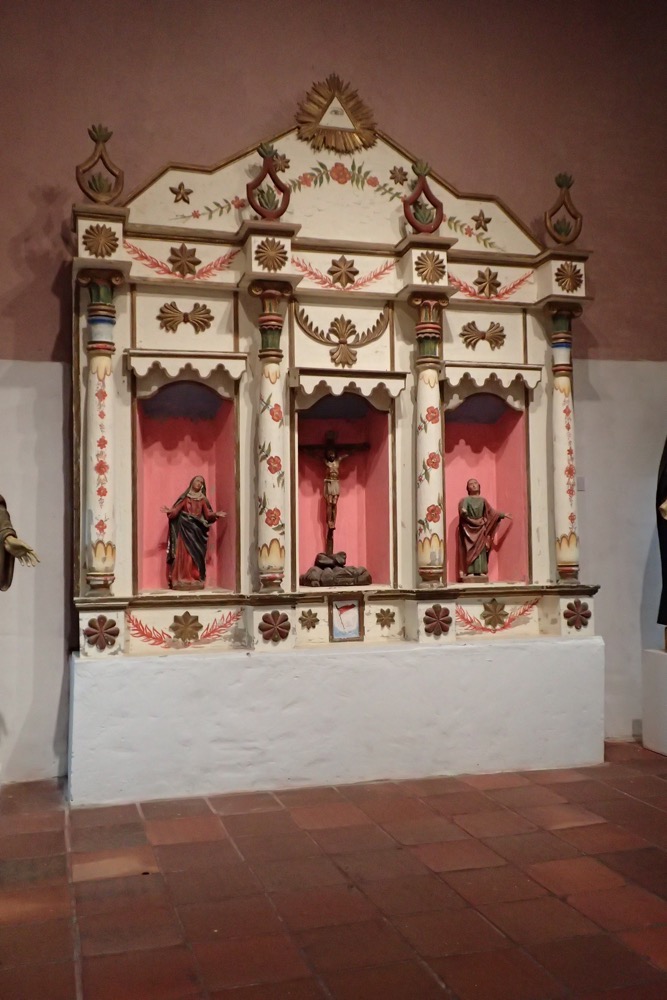 The ceiling at Monasterio de San Pedro Cláver.
The ceiling at Monasterio de San Pedro Cláver.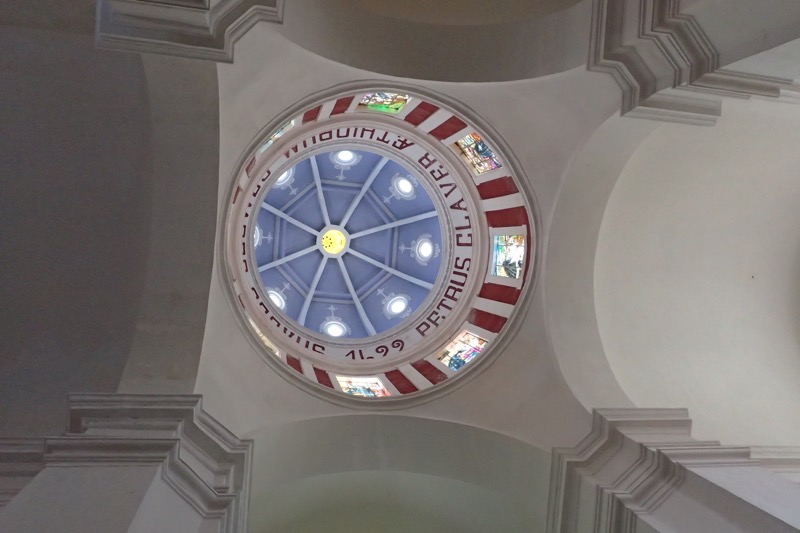 And the nave that contains the remains of San Pedro Cláver.
And the nave that contains the remains of San Pedro Cláver.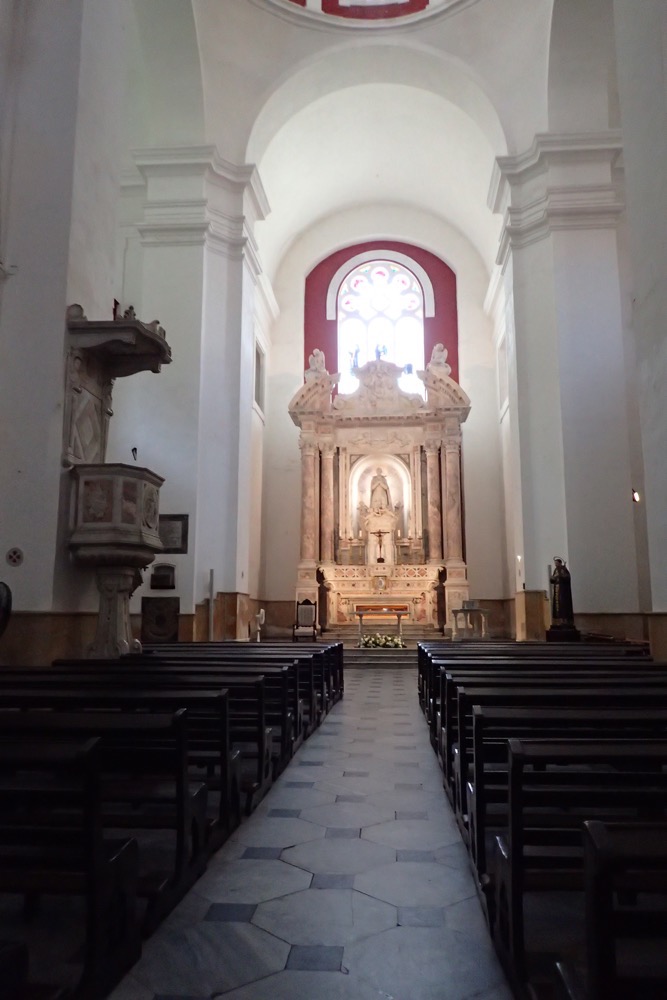 In the courtyard was some domestic macaws clambering all over the tourists. I have to say with those large talons and pointy looking beaks, I only held them momentarily and it was with some trepidation! I don’t trust birds. 😛
In the courtyard was some domestic macaws clambering all over the tourists. I have to say with those large talons and pointy looking beaks, I only held them momentarily and it was with some trepidation! I don’t trust birds. 😛 